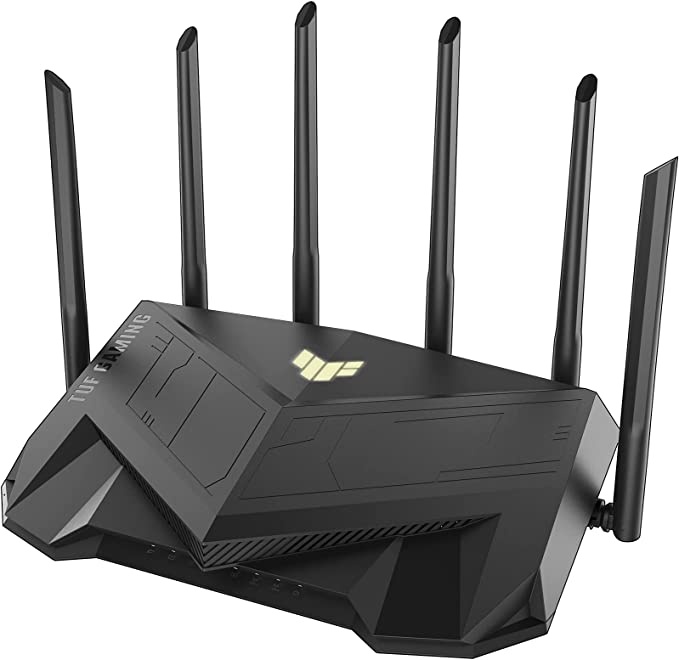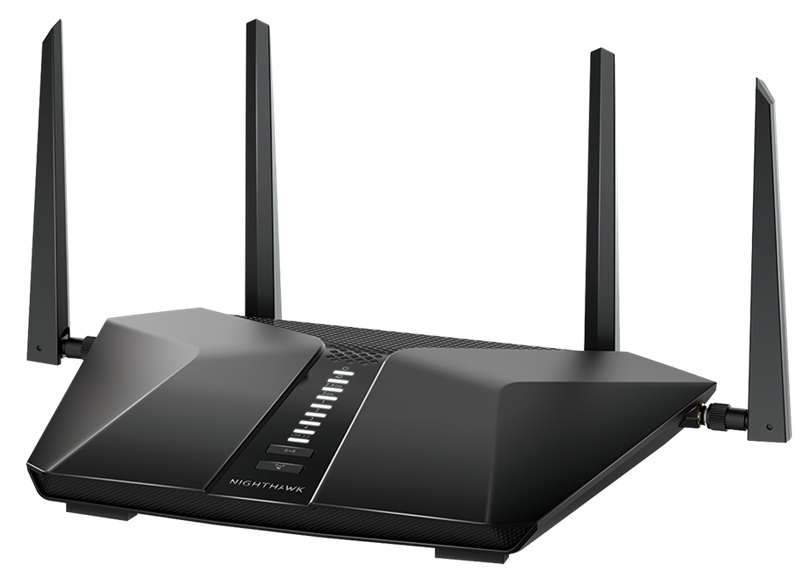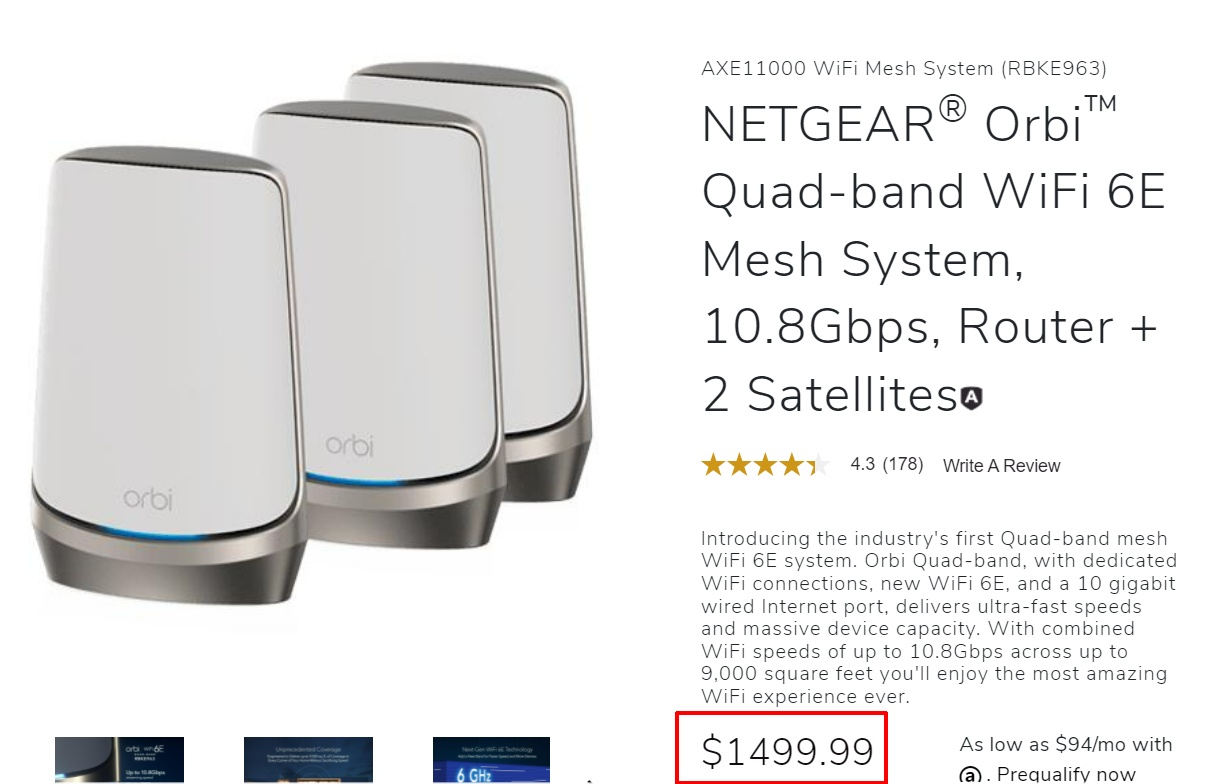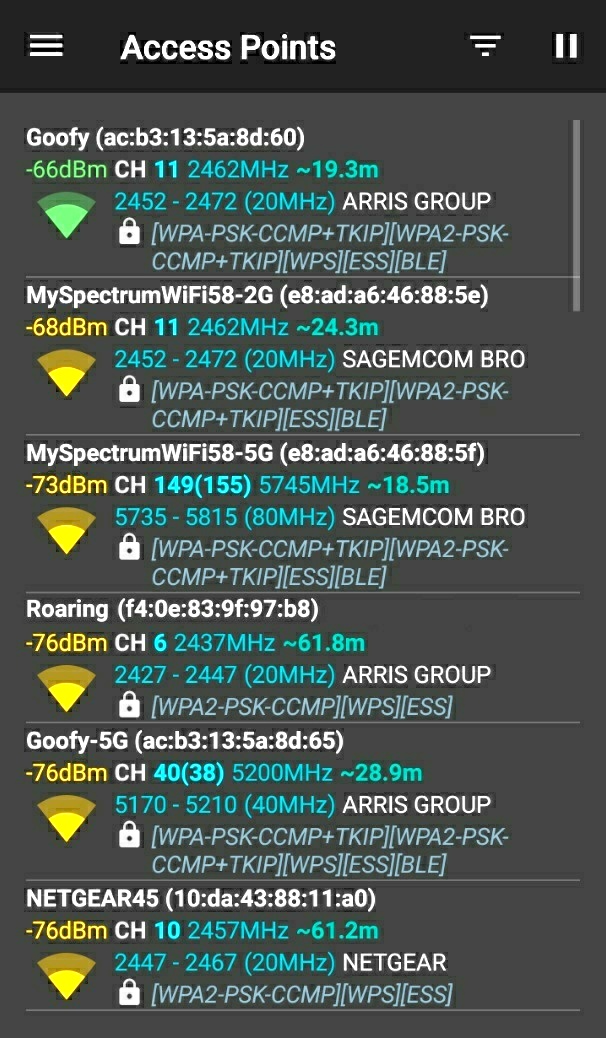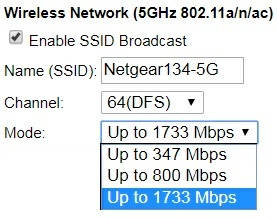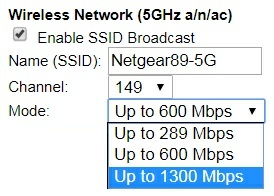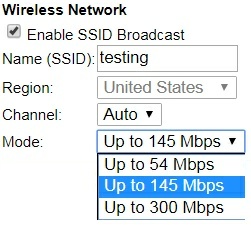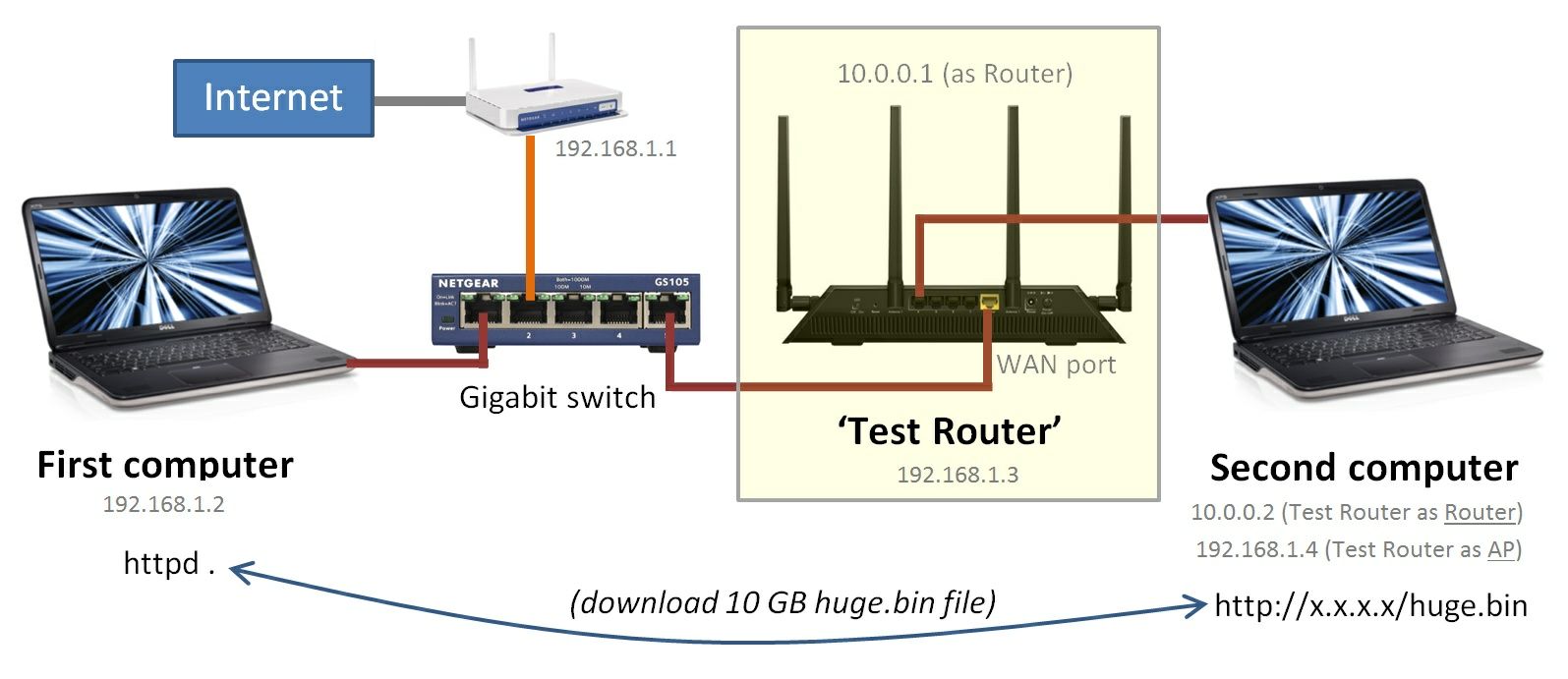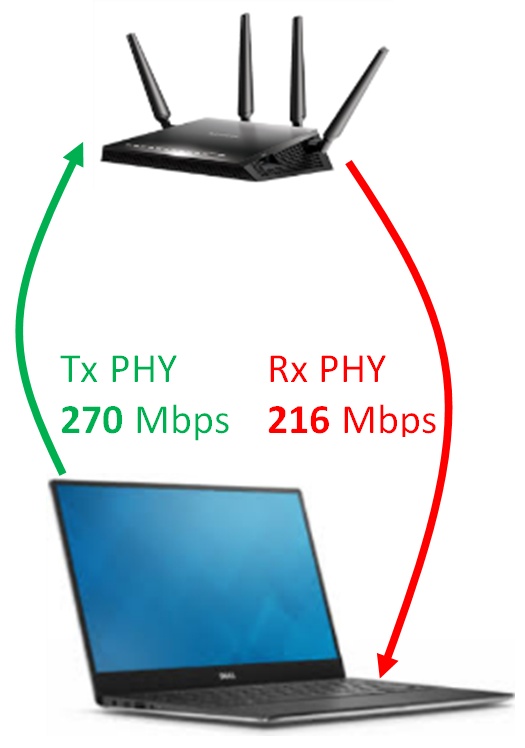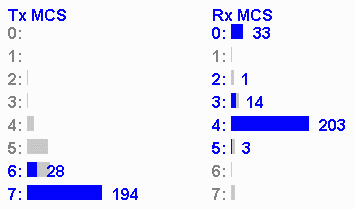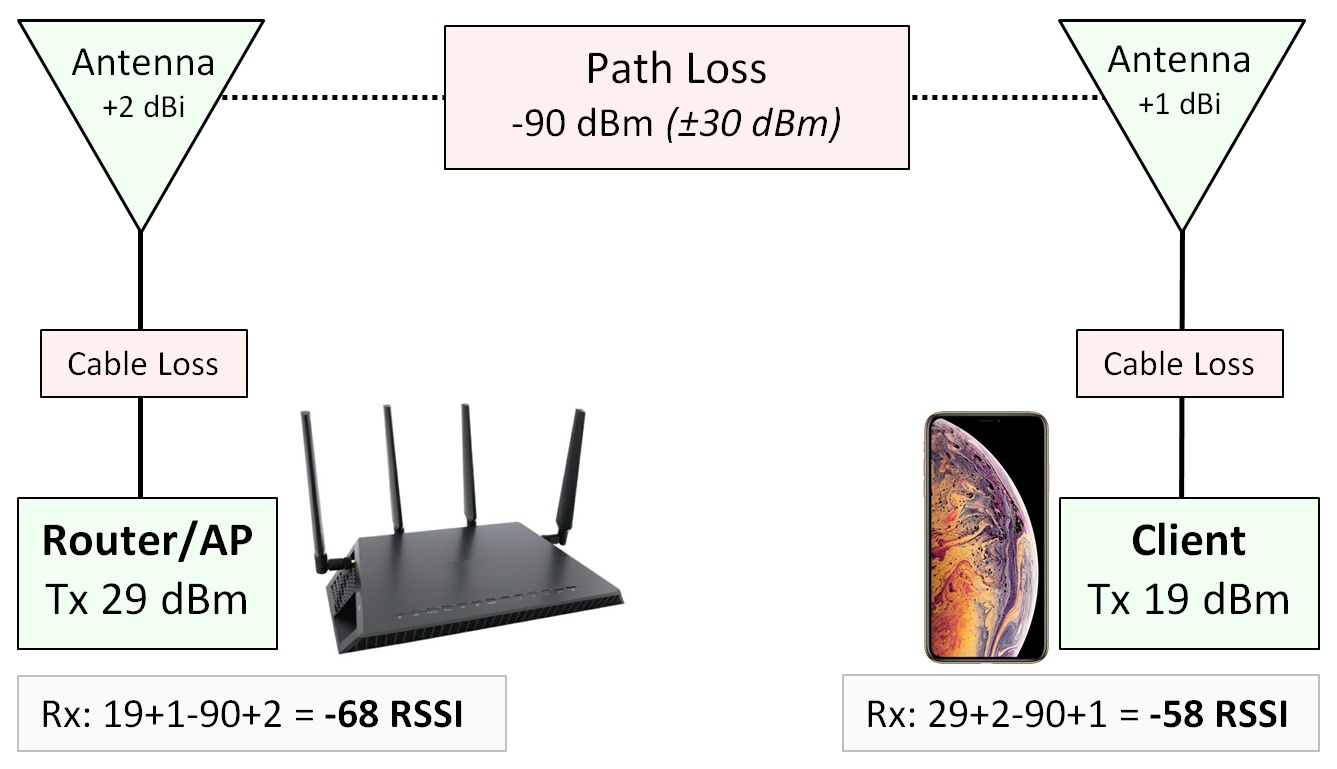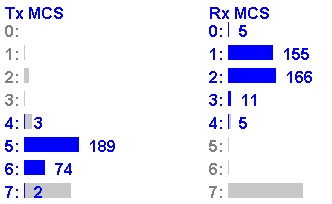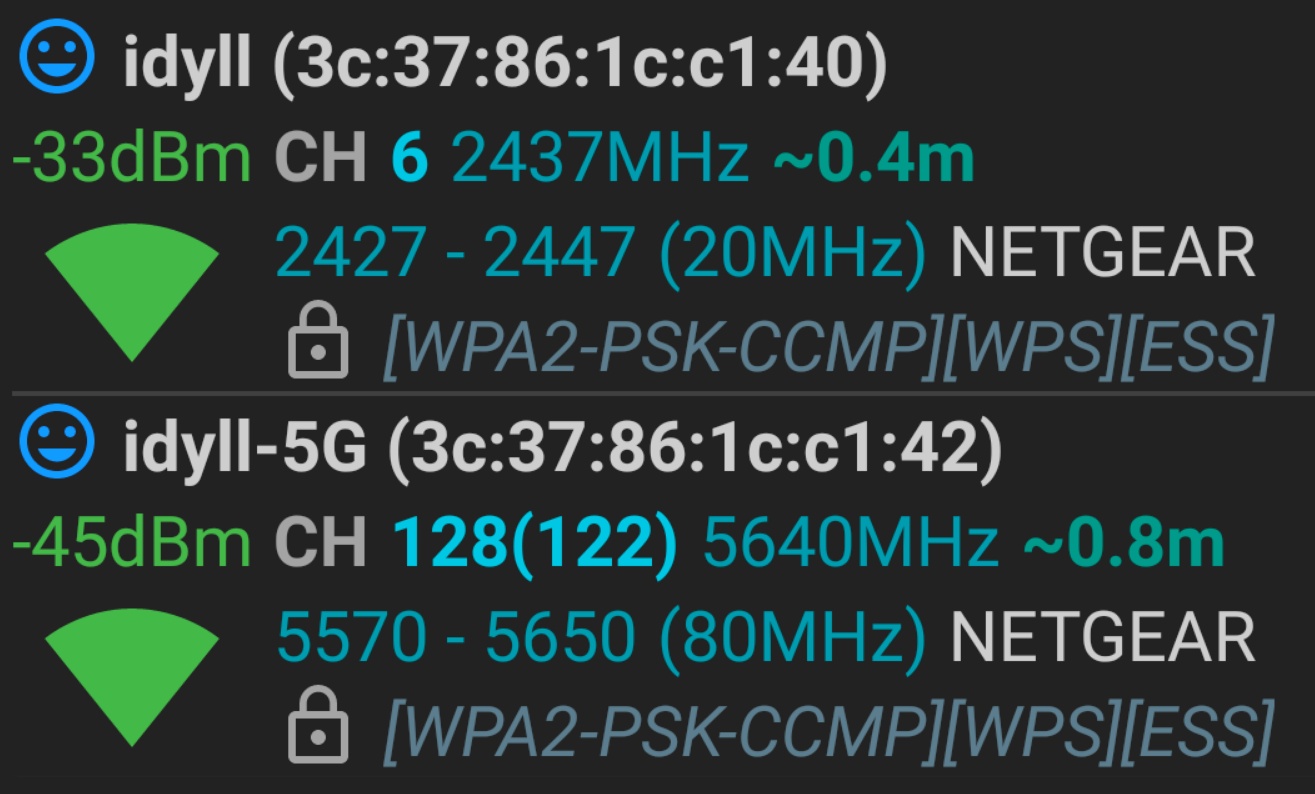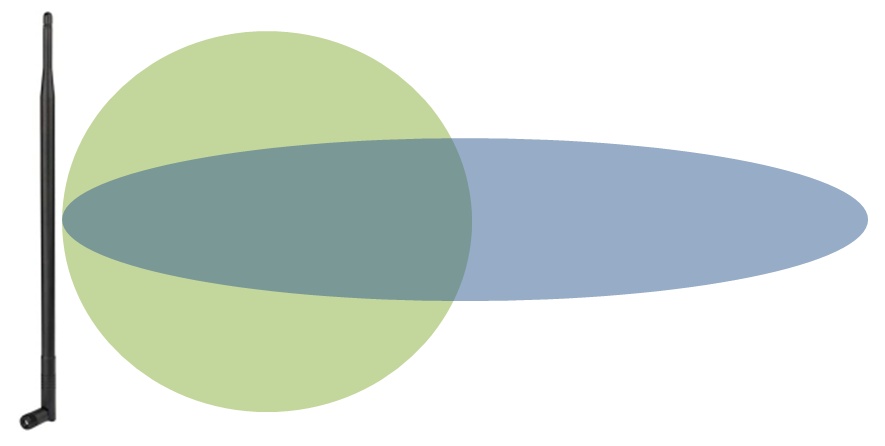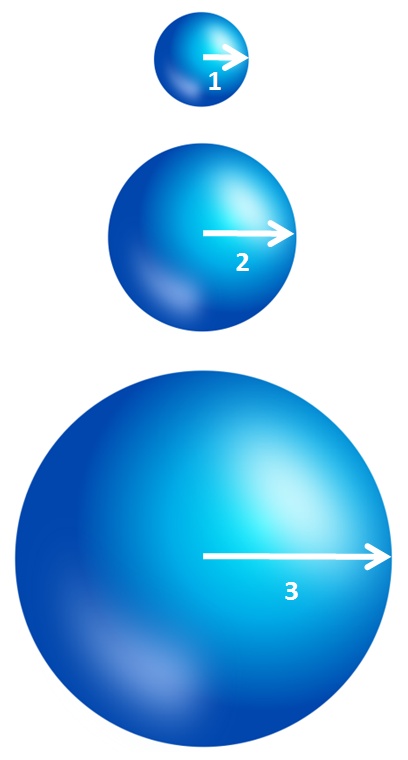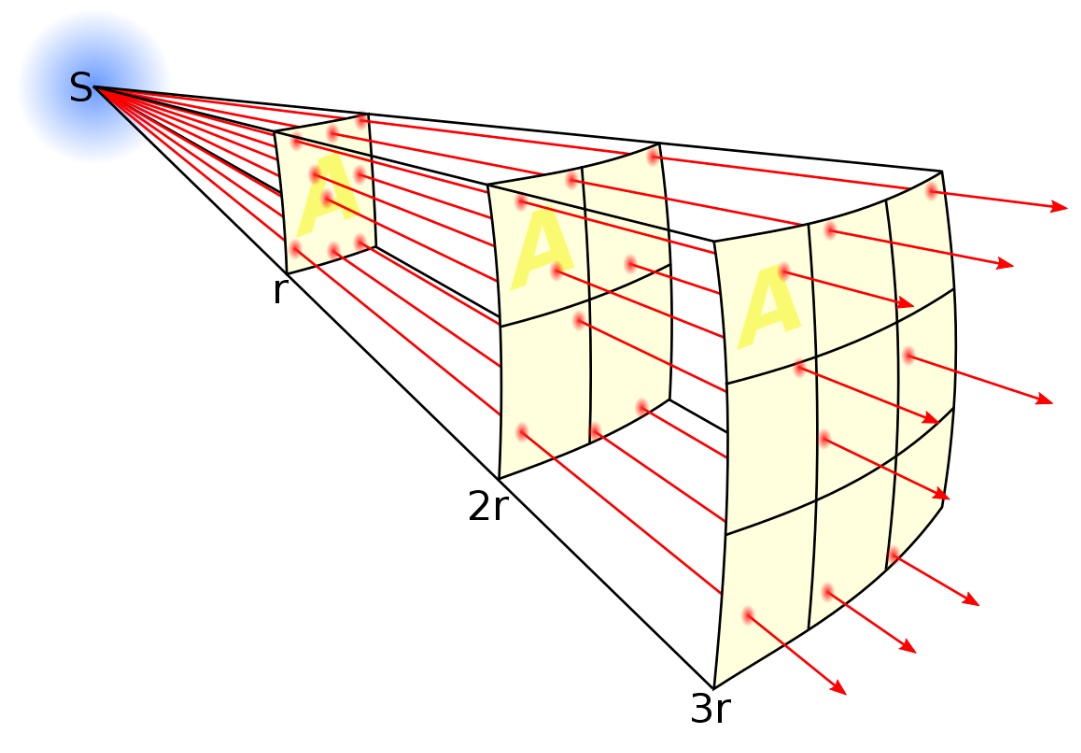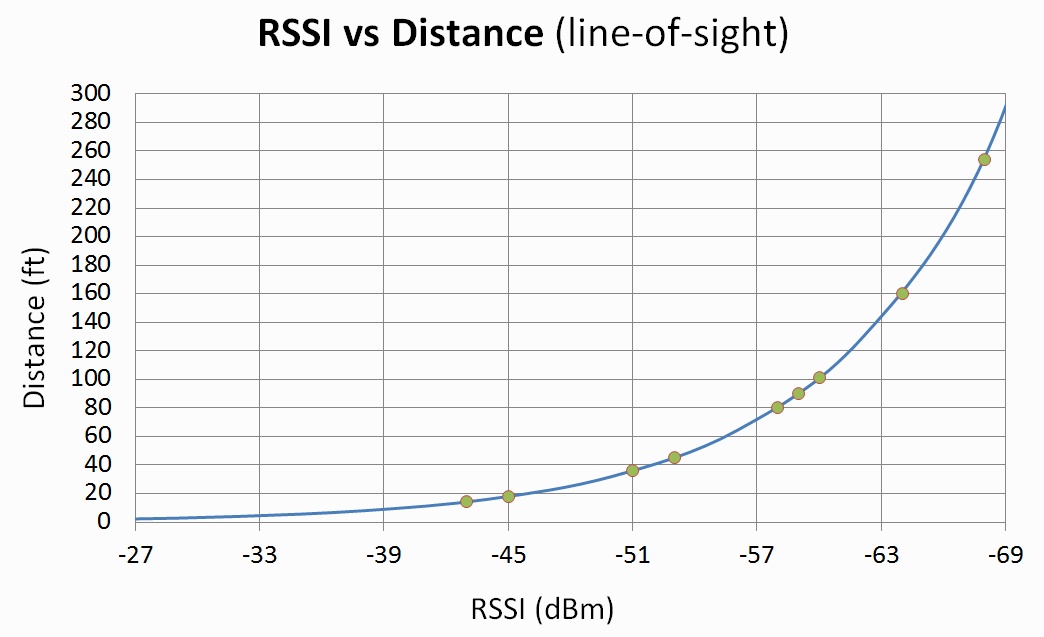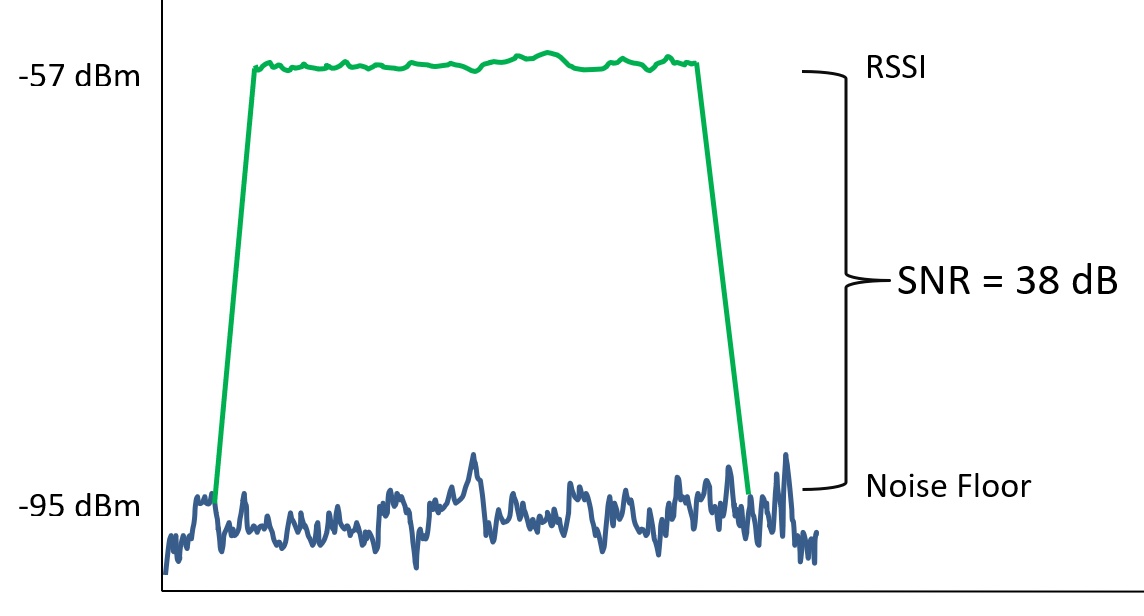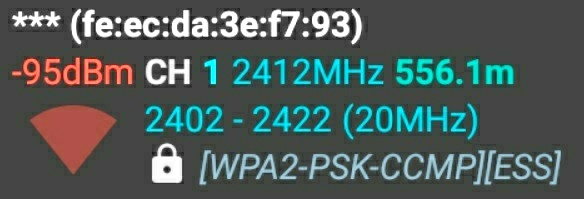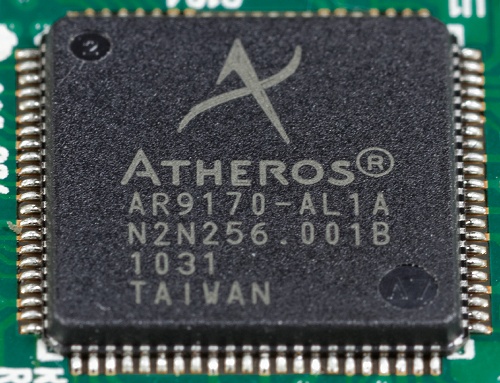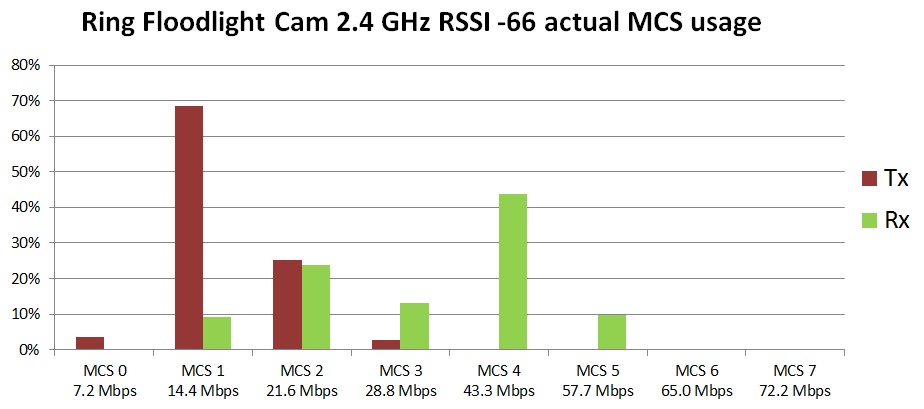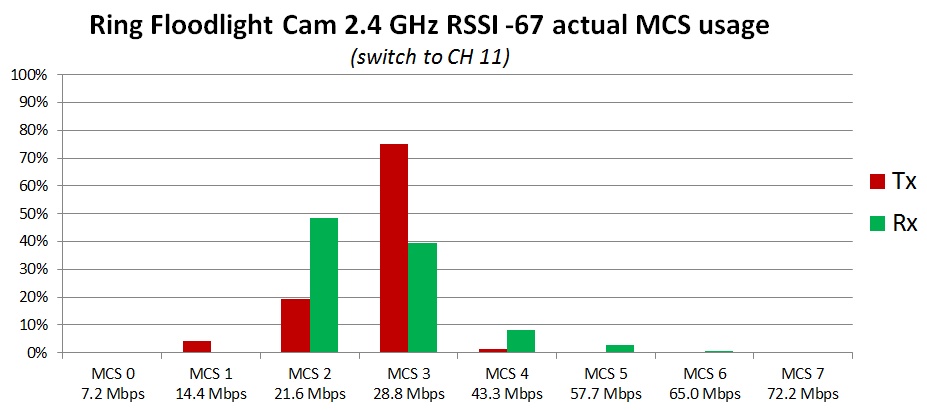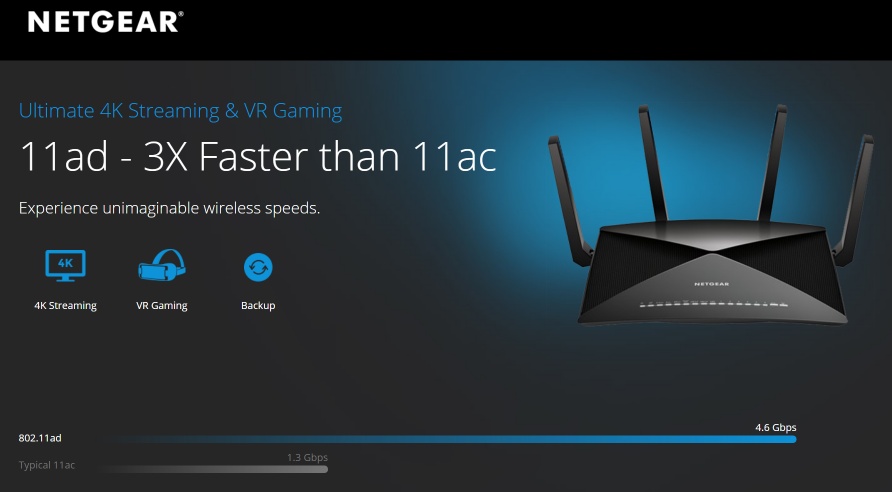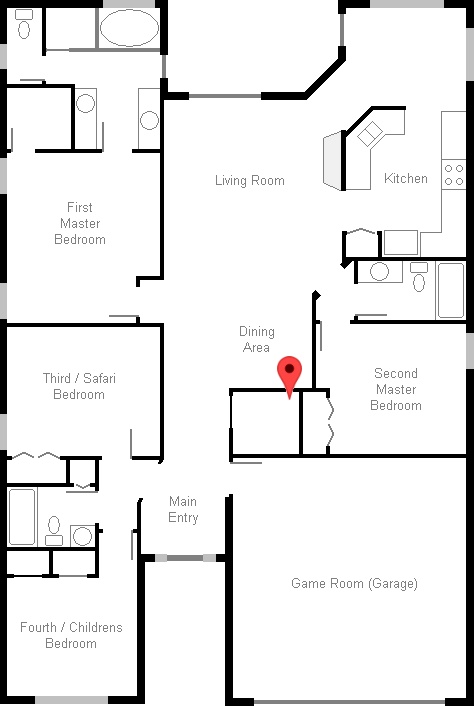Wifi speeds vs. broadband speeds: Wifi speeds have lagged behind ever increasing Internet speeds. As a result, there has been a very rapid switch in wifi from Wi-Fi 4 (2.4 GHz 802.11n) to Wi-Fi 5 (5 GHz 802.11ac), to Wi-Fi 6 (5 GHz 802.11ax), and now to Wi-Fi 6E (802.11ax extended into 6 GHz) in an attempt to keep up (and Wi-Fi 7 is just around the corner). ★ So what new router/AP should you consider buying today? Router Manufacturers' Marketing Hype: Don't be fooled by the marketing hype of router manufacturers' advertising outrageously high aggregate (all bands added together) Gbps wireless speeds (like 7.2 Gbps). What really matters is realistic speeds achieved by your wifi client devices, that actually exist today. The weakest link: Wifi throughput to a Wi-Fi 5 wireless client device will likely max out at around 600 Mbps (±60 Mbps) for 2x2 MIMO no matter what 4×4 router is used (when right next to the router and slower at distance). And the far majority of ALL wireless client devices today (smartphones, tablets, laptops, etc) are still only 2x2 MIMO. So your client device is almost certainly causing slow wifi speeds (and maybe not your existing AP/router). The best router/AP value today: A mid-range Wi-Fi 6 router supporting (1) 4×4 MIMO, (2) ALL DFS channels, and (3) beamforming is a great value today (as of April 2023; best seen upper right). So, upgrade, or not?: The only question that really matters is: What are client PHY speeds now and what will client PHY speeds be after an AP/router update? Because, if (the majority of) client PHY speeds will not increase after a router update (especially for 'at range' client devices), what is the point in spending money on a new router that won't improve Wi-Fi speeds?
The goal of this paper: This paper was written to help people understand current wifi technology, so that YOU can make an educated 'router' upgrade decision -- because there is WAY too much hype out there (especially about wifi speeds) -- and router manufacturers' are directly to blame. The issue: Wifi spectrum is a limited, TIME-shared resource. Any number of access points (both yours and neighbors) can all share the SAME wifi spectrum. But because wifi use has exploded over the last few years (tablets, laptops, smartphones, TVs, Blu-rays, security cams, thermostats, Bluetooth, BLE, Zigbee, microwaves, etc) the wifi spectrum is way overcrowded. And when combined with ISP Internet speeds now often many times faster than Fast Ethernet (100Mbps), and sometimes even 1 Gbps, wifi speeds have not kept up.
Industry solution: The industry quickly switched to the much newer Wi-Fi 6 (5 GHz 802.11ax) spectrum, where speeds are much faster, due to more available spectrum and new wifi features, such as MIMO and wider (up to 160 MHz) channels. But that requires a new router, but which one? BUT, our devices are still speed limited. Why? As will be shown in the next sections, mainly due to limited 2×2 MIMO support in almost all of today's wireless (and battery powered) client devices. But let's also be very realistic. If you have 400 Mbps (or less) Internet speeds, 2×2 MIMO Wi-Fi 5 to your router is almost always sufficient -- and IS fast enough -- even with an older high quality "wave 2" 4×4 MIMO 802.11ac router (an example of one is seen right).
In summary: Wi-Fi can only operate as fast as the least capable Wi-Fi device in a 'conversation', which almost always is your client device (and not the router). KEY Wi-Fi concept: Client devices often limit speeds, not the router/AP. The weakest link in Wi-Fi is YOUR client device: You have 1 Gbps Internet, and just bought a very expensive AX11000 class router with advertised speeds of up to 11 Gbps, but when you run a speed test from your iPhone XS Max (at a distance of around 32 feet), you only get around 450 Mbps (±45 Mbps). Same for iPad Pro. Same for Samsung Galaxy S8. Same for a laptop computer. Same for most wireless clients. Why? Because that is the speed expected from these (2×2 MIMO) devices! This section explains in great detail exactly why that is. You may safely skip to the next section for a shortcut if this section is too detailed/technical for you. The rest of this section is a "deep dive" into everything that limits speed when a Wi-Fi 5 client device communicates with a Wi-Fi 5 router.
AC5300 rating: How did your router even get a 'rating' of 5300 Mbps in the first place? Router manufacturers combine/add the maximum physical network speeds for ALL wifi bands (usually 2 or 3 bands) in the router to produce a single aggregate (grossly inflated) Mbps number. But your client device only connects to ONE band (not all bands) on the router at once. So, '5300 Mbps' is all marketing hype. The following sections detail how the grossly speed of 5300 Mbps is reduced down to a 'real-world' speed of only 455 Mbps... 5300 → 2166: Maximum ONE band speed: The only thing that really matters to you is the maximum speed of a single 5 GHz band (using all MIMO antennas). You find out by looking at the 'tech specs' for an AP/router. 5300 is just 1000 + 2166 + 2166, where 1000 is the 2.4 GHz band speed and 2166 is the 5 GHz band speed. 2166 also is a tip-off that this router is a 4×4 MIMO router (by looking for '2166' in the speed table, right). More on bands in the Beware tri-band marketing hype section far below. 2166 → 2166: Realistic 80 MHz channel width: Router manufacturers cite speeds for 2.4 GHz using 40-MHz channel widths, but a 20-MHz channel width is much more realistic (that cuts cited speeds in half). For 5 GHz 802.11ac, speeds are typically cited for an 80-MHz channel width, which all AC clients are required to support. But if cited speeds are for a 160-MHz channel width (that is starting to happen for the new Wi-Fi 6 routers), cut the cited speeds in half (as most clients won't support that). 2166 → 1083: Client 2×2 MIMO: Which MIMO column do you use in the wifi speed table (right) -- The MIMO of the router or the MIMO of the client device? You must use the minimum MIMO common to both devices (often the client). So if you have a 4×4 router, but use a 2×2 client (like the Apple iPhone XS Max or Samsung Galaxy S8) to connect to it, maximum speeds will be instantly cut in half (2/4) from cited router speeds. Wi-Fi specifications for iPhone, iPad, or iPod. Virtually all newer iOS devices are 2×2 MIMO and older iOS devices are 1×1 (no MIMO). 1083 → 866: Client 256-QAM: You can only use the maximum (common) QAM supported by both the router and the client. Router manufacturers may cite speeds for 1024-QAM (which the router DOES support), but you will only get that if your clients supports that QAM (many do not) and you are very close to the router (sometimes only just feet away). So reduce to a much more realistic maximum of 256-QAM 5/6. 866 → 650: 32 feet from router (Modulation/Coding): Router manufacturers love to cite the maximum PHY speed possible, which you will only when you are very close (just feet) to the router. But as you move further away from the router, speeds gradually decrease. The 'distance' issue is represented by rows in the PHY speed table (seen upper right). At just 32 feet away from the router (a very typical distance), 64-QAM 5/6 was actually observed, so use that. For more details, see the next section. Analogy: Understanding Modulation/Coding: Imagine that once a second, you hold up your arms in various positions to convey a message to someone else. If you were only ten feet away from that person, the number of arm positions reliably detected would be very high. But now move 100 feet away. The number of arm positions reliably conveyed would be reduced. Now move 500 feet way. The number of arm positions reliably conveyed might be reduced to just 'did the arm move at all'. The same thing happens in wifi. If you are close to the AP/router, a large number of bits can be conveyed 'at once'. But as you move away, a smaller and smaller number of bits can be reliably conveyed 'at once'. So 'modulation/coding' is simply how much information can be conveyed at once, and is directly related to distance from the AP/router. 650 → 455: Wi-Fi overhead (MAC efficiency): What is the overhead at the network level? All of the speeds we have discussing so far are for PHY (physical) network speeds. But due to wifi protocol overhead, speeds at the application level are around 60% to 80% the physical network level. So use 70% as a fair estimate of throughput you can expect to see. 70% of 650 is 455 Mbps. Just Google 802.11ac MAC efficiency to understand this issue. In short, there are 'housekeeping' packets that MUST be sent at the SLOWEST possible modulation, and that takes time and slows everything down (along with other issues). 455 → ???: Interference/Contention: So, the final number is 455 Mbps for a 2×2 device (at a fair distance away from the router), but only if your device gets exclusive use of ALL time left in the wifi channel. But there may (or may not) be other wifi users (either local, or even neighbors on the same spectrum) which will decrease your speed by some unknown amount. Results: 2×2 MIMO devices get a realistic (maximum) download speed of 455 Mbps (±45 Mbps) at around 32 feet, which is dramatically lower than the '5300 Mbps' advertised by router manufacturers. A lesson learned: The two critical factors that greatly impact and determine maximum real-world speed for a single client are: (1) lowest common MIMO level support and (2) MAC efficiency.
YOUR client device is the key (limiting) factor for the speed (and maximum distance) at which your device connects to a router (a modern router is rarely the limit; for technical details, see prior section). Stay in this section for a fast shortcut. For a client device, expect 'top PHY speeds' (standing right next to the router) of:
With a new modern Wi-Fi 6 router, it is virtually never the router that has the speed limit, but rather, it is the client device (that is NOT as capable as the router) that limits speeds. For example:
The problem (of finding maximum speed): So how do you find the maximum (realistic) wireless speed of a client to an AP/router? You could just run a speed test, but if the speed is not what you expected, where is the problem -- the client, the router, the Internet, interference, elsewhere, or is the speedtest accurate? The solution: Go to your wireless device and find the PHY speed (the raw bitrate between the device and your AP/router) and take 70% of that PHY speed to estimate maximum application speed (the next section explains why the overhead is so large). Then lookup the PHY speed number in the PHY speed tables to then find which MIMO level is currently being used.
Windows 11 (new way): Right-click on the Wi-Fi icon in the taskbar. Click on "Network and Internet Settings". Click on "Wi-Fi". Click on "XXX properties" (where XXX is the name of your Wi-Fi network). Scroll down to "Link speed (Receive/Transmit)". Windows 10 (new way): Go to the 'Settings' app, click on 'Networking & Internet', click on the 'View your network properties' link and find the transmit/receive speed under your 'Wi-Fi' adapter. However, I suspect that sometimes transmit/receive are just a single value displayed twice instead of two actual speeds.
Windows 11/10/8/7 (legacy mode): In the Windows "Control Panel", search for and then click on "Network and Sharing Center", then click on the named wireless connection (which opens a 'status' dialog), and look for the 'Speed' (example seen right). Example: Lookup 702 Mbps speed (right) in the PHY tables far below and it is not found. So, go to the full PHY speed tables and you will find various matches, but only one makes logical sense: 80 MHz channel, 2×2 MIMO, 256-QAM. Mac: (1) Hold the option/alt key down and click the Wi-Fi icon in the menu bar and look for the "Tx Rate". (2) Run the "Network Utility" (under Applications / Utilities; or use Spotlight to find) and look for the wifi "Link Speed". [ iOS (iPhone/iPad/iPod): Not known (tell me if you know how). However, to find the maximum PHY speed and MIMO level for your iOS device, visit the Wi-Fi specification details for iPhone, iPad, or iPod. All modern iOS devices are 2×2 MIMO. UPDATE: Here is a tip I received -- if you happen to use Apple's AirPort WiFi base station: "Install Apple's 'airport utility' and then open it. Click on the wifi base station. Click on 'wireless clients' and then click on your iOS device and then 'connection'. This will give you the iOS device 'PHY' connection speed."
Android: Go into "Settings / Connections / Wi-Fi", click on the connected wifi network, and find the 'Network Speed' (example right). Or, it may also be called 'Link Speed'. Example: Lookup 585 Mbps (right) in the PHY tables far below, and you will find it in multiple columns, but given the client, what makes the most sense is: 80 MHz channel width, 2×2 MIMO, and 64-QAM. Kindle: Under Settings, click on "Wireless", then click on the connected wifi network, and look for "Link speed". Chromebook: Open "crosh" on your Chromebook (CTRL-ALT-T) and type "connectivity show devices" and look for the Link Statistics Transmit Bitrate. You should see: (1) the Mbps transmit bitrate, (2) the MCS index number, (3) the channel width in MHz, and (4) the number of spatial streams. Type "exit" to exit/close the crosh window. Netgear Router TIP: In the Netgear 'Nighthawk' router app, click on 'Device Manager', then click on a client device, and a "Link Rate" will be displayed. But Netgear displays a 'link rate' that is slightly too small. To correct (to bps), multiply by 1024/1000 (thanks to Matthew S. for pointing that out). Comcast Gateway TIP: If you use a Comcast provided cable modem / gateway device, connecting to the http administration interface, signing in, and clicking on the 'View Connected Devices' button will take you to a page that shows the "RSSI Level" (in dBm) for all Wi-Fi connected devices. Very helpful!
MOST client devices today are stuck at 2×2 MIMO: As can be seen from the tables (right), most client devices today are STILL only 2×2 MIMO. Why haven't devices switched to 4×4? Because (1) there is (currently) no compelling need for that speed today (there is no app that 'requires' 400 Mbps to function) and more importantly (2) the increased speed is not worth the tradeoff in greatly reduced run time for battery powered devices. Supporting 4×4 MIMO takes a lot more power, and for battery powered devices, runtime is FAR more important. You can expect a maximum PHY speed of 866 Mbps, and around 600 Mbps (±60 Mbps) throughput, from a Wi-Fi 5 (802.11ac) 2×2 client device. It is noteworthy to point out that Dell apparently had a 3×3 laptop in the past, but Dell only offers a maximum 2×2 laptop as of February 2019. A final warning: This discussion about 'the' PHY speed of your device is slightly over simplified, as for every wifi device, there is actually a Tx (transmit) PHY speed and a Rx (receive) PHY speed, and those two speeds are almost always different (asymmetric). But even when different, the two speeds are relatively close to each other, so the asymmetry is rarely noticed. See the PHY speed is asymmetric appendix below for more details. A final wrench in the PHY puzzle: And PHY speed is not 'constant'. Unless you are right next to the router (with a fantastic signal strength and PHY speed is highest possible speed), PHY speed is actually constantly changing up and down between MCS levels, adapting to changing signal strength conditions. It is not uncommon with a single second to see 3 to 4 different MCS levels (PHY speeds) used. Are you highly technical? Then use the Router deep dive appendix below to determine exactly what MCS indexes are being used for both Tx PHY and Rx PHY. Another client device limitation: Range: The maximum distance at which a device can connect to an AP/router is (almost always) determined NOT by the power output of the AP/router (around 950 mW is typical), but the power output of the client device (around 50 mW to 250 mW typical), as client devices almost always operate at lower power levels than the AP/router. The implication of this is that the Tx PHY speed from a client device to an AP/router is almost always lower (hits the limit sooner) than the Tx PHY speed from the AP/router to the client. Full details.
The bottom line: Under ideal conditions, you can and should expect Mbps throughput around 70% (±10%) of the client PHY Mbps speed. But in many situations (for tons of various reasons), overhead and contention can cause throughput as low as 50% of PHY speed. KEY Wi-Fi concept: Expect Wi-Fi throughput to be around 70% (±10%) of PHY speed.
Wifi overhead can be surprisingly 'large': So, if your smartphone connects to your AP/router at a PHY speed of 702 Mbps, why doesn't your smartphone get that full speed? Instead, 70% of your PHY speed (70%×702=491 Mbps) is a fair estimate of actual (maximum) Mbps seen, but why? PHY speed in wifi is exactly like the speed limit (sign) on a local road. You can go that fast some of the time but clearly not all the time. Because you must take into account known slow downs: stop signs, turns, traffic lights, traffic, school zones, weather conditions, etc. And in Wi-Fi, there are a lot of slow downs that add up.
First, there is TCP/IP and Ethernet overhead: On wired Ethernet, you can expect around 5% overhead for TCP/IP and Ethernet, or 95% throughput at the application level. As a ballpark figure, assume something very similar for wifi. Just remember that part (around 5%) of the total overhead you are seeing in Wi-Fi is actually coming from TCP/IP and Ethernet protocol overhead, and not Wi-Fi itself. Management transmissions must be sent at the 'slowest' possible modulation: In order to guarantee that ALL devices on a channel (AP and clients) can receive+decode management transmissions, those transmissions must be transmitted at the slowest possible modulation -- so that devices that are furthest away from the AP (and hence, running at the slowest speed) can receive and successfully decode those transmissions. For example, 802.11 'Beacon Frames' (typical send rate is once every 102.4 ms). And this 'slow' speed can be as slow as 1 Mbps (2.4 GHz band) or 6 Mbps (5 GHz band). When compared to 433 Mbps and 866 Mbps, that 'slow' speed is a hit. SSID overhead: The overhead per SSID (on one channel) can be anywhere from 3% to incredibly high. Half Duplex: There is no separate download spectrum and upload spectrum in wifi (whereas Ethernet is full duplex - can send and receive at the same time). Instead, there is only a common spectrum (channel) that ALL wifi devices (router and clients) operating on that channel must use in order to transmit (and receive!). So when you are running that download throughput speed test, your device is mostly receiving, but it is also transmitting (acknowledging data sent)! Using the MCS Spy tool , a PC downloaded at 120 Mbps, but was uploading at 1.8 Mbps at the same time. This is simply due to how TCP/IP works. And almost always, the client transmits back to the AP at a slower MCS than the MCS the router uses to transmit to the client. So because wifi is half duplex, there may be around 1% to 3% (relative) 'overhead' simply due to how TCP/IP works (acknowledgements). CSMA/CA: The Wi-Fi spectrum is a shared resource. So how does a device know that it is OK to transmit? Wifi uses something called CSMA/CA (Carrier-Sense Multiple Access with Collision Avoidance). So any device on a channel that wants to transmit must first 'sense' that the spectrum is available/unused. And to ensure 'fairness' to all wifi stations that want to transmit, all 'want to transmit' stations wait a random amount of time before transmitting (if the spectrum is still unused at that point, and hope for no collisions). And if you have a lot to transmit, that 'wait for a random amount of time' over and over adds up. But that random wait is necessary to ensure 'fairness' to other wifi devices. Acknowledgements: Every Wi-Fi packet sent must be 'acknowledged' (to confirm receipt). To accomplish this, each sent packet has a little bit of an extra reserved space (a 'time window') appended to the end of the packet, for the receiver to transmit back (during the empty 'time window') an 'I got it' acknowledgement (to the sender). Collisions/Retransmissions: When multiple devices want to transmit at once (as the channel gets busy), the possibility of collisions (more than one device transmitting at the same time) increases, causing that entire transmission to be lost, and a future retransmission. Or a transmitted packet just did not make it. From a test AP, there were 1,519,932 packets transmitted and 48,878 packets retransmitted. So, around 3% of the data packets had to be retransmitted.
Hidden Node Issue: There is something called the Hidden Node Problem that can (potentially) cause a large number of collisions in wifi -- where device 'A' and device 'B' can both hear transmissions from the AP, but device 'A' and device 'B' can NOT hear each other's transmissions. So both device 'A' and device 'B' might transmit at the same time (as seen at the AP, a 'collision') and both transmissions are lost (at the AP). A mitigating factor is that even if your network has the hidden node problem, the hidden nodes will not impact each other, unless they attempt to use wifi and transmit at the exact same time. If both hidden nodes are sporadically using wifi, the problem will not happen that often. Coexistence with 802.11 a/b/g/n: For an 80 MHz 802.11ac channel to properly coexist with older 20 MHz radios operating within the channel, there is a 'request to send' and 'clear to send' exchange before each real message is sent. And that slows everything down. Beamforming overhead: The sounding frames for beamforming adds a tiny bit of overhead. How much overhead this causes needs to be researched. CRITICAL: Don't forget that Wi-Fi is a shared resource: After all of the above (which assumes you have the Wi-Fi channel all to yourself), if you are unlucky enough to have a router set to the same channel as your neighbor (and your neighbor is using Wi-Fi), you are sharing spectrum/time/bandwidth with your neighbor! How is Wi-Fi spectrum shared? By bandwidth? By time? By something else? In general, by TIME -- if 'N' users all want to use Wi-Fi at the same time, on average, they will all get to use the channel '1/N' of the time. For example, if two users want to use the same channel, and first user at a PHY of 6 Mbps, and the second user at a PHY of 866 Mbps, the first user will get to use the channel 50% of the time (so 6/2, or around 3 Mbps), and the second user will get to use the channel the other 50% of the time (so 866/2, or around 433 Mbps). A final caveat: PHY speed is a very complicated thing. Tx PHY and Rx PHY can not only be asymmetric (more details below), but also be highly variable. The 'link speed' your device reports to you is a highly over-simplified single number. You should only use that speed as a 'ballpark' figure of actual PHY speeds used. Or, when you run a throughput test and attempt to calculate the 'overhead' at the PHY level, that 'overhead' is only an estimate. A prime example: A Windows laptop with an 'older' 802.11ac 2×2 MIMO four feet from the router reports (an expected) 'speed' of 866.6 Mbps (MCS9). A throughput tests shows download speeds of 475 Mbps. That is a MAC efficiency around 55%. But the MCS Spy tool (see Router deep dive appendix below) clearly shows that the router is transmitting to the PC using only MCS7 (650 Mbps), which is actually a much better MAC efficiency of around 75%. There is still the problem of why MCS9 is not being used, but MAC efficiency is much better than it initially appears. Learn More:
The bottom line: The AC#### naming convention (AC1900, AC2600, AC5300, AC7200) and AX#### naming convention (AX6000, AX11000) used in the router industry (where the #### is a maximum combined Mbps) is nothing more than marketing hype/madness. The naming convention implies (incorrectly) that the larger the number, the better and faster the router -- and the faster wifi will be for your wireless devices. Also, speeds are cited for hypothetical wireless devices that DO NOT EXIST -- can you actually name a single smartphone, tablet, or laptop computer that has 4×4 MIMO for Wi-Fi? KEY Wi-Fi concept: There is a lot of marketing hype in the claims made by router companies.
Example: Seen upper right are the specifications for an AC4000 (4000 Mbps) class router. But realistically, what speed can YOU expect from your "iPhone XS Max", a 2×2 MIMO device, at a reasonable distance of 32 feet? Bands/MIMO: AC4000 is 750+1625+1625. So what do those numbers mean? It is the 'maximum' speeds (best modulation possible with highest MIMO) of all 'bands' in the router added together as follows:
MAC Overhead: Take the 5GHz PHY speed (for one 5 GHz band, not both bands, so 650) and multiple by 70% to get an estimate of the Mbps speeds that you will see within speed test applications running on your wireless device. Conclusion: At 32 feet, you will get a maximum speed of around 455 Mbps (±45 Mbps) from your iPhone XS Max from this '4000 Mbps' router. With a second AC band, you 'might' get up to 455 Mbps from another wireless device at the same time (but see tri-band router section below). So upgrading to a faster router will increase your iPhone XS Max speeds, right? No! What about an AC5400 4×4 tri-band router? Same speed. What about a brand new ultra-fast Wi-Fi 6 AX6000 8×8 router, marketed as being 4x faster than Wi-Fi 5? Same speed. Understand router manufacturers' marketing hype.
MIMO: What is (partly) driving the dramatic increase in wireless (wifi, cellular, etc) capacity in the last few years is MIMO (acronym for Multiple Input, Multiple Output), or spatial multiplexing, or spatial streams -- by using multiple antennas all operating on the same frequency at the same time. Most smartphones today are capable of 4×4 cellular MIMO -- so they are (potentially) four times as fast as a single antenna phone. But MIMO for wifi is stuck at 2×2 MIMO for most wireless wifi (client) devices. Analogy: Think of MIMO as adding 'decks' to a multi-lane highway. More lanes (capacity) are added without using more land (spectrum). 2×2 MIMO is a highway with one more highway deck above it. And 4×4 MIMO is a highway with three more highway decks above it. What is the big deal: The reason MIMO is such a huge deal is because it is a direct capacity multiplier (×2, ×3, ×4, ×8, etc) while using the SAME (no more) spectrum. This is accomplished by simply using more antennas (by both the router and client). MIMO adds more capacity without using more spectrum! Example: On a single 80 MHz 802.11ac channel operating at 433 Mbps:
all on the same 80 MHz channel. Notation: You might see the MIMO level written as T×R:S, where 'T' is the number of transmit antennas, 'R' is the number of receive antennas, and 'S' (an optional component) is the number of simultaneous 'streams' supported. If the 'S' component is missing, it is assumed to be the minimum of 'T' and 'R'. OR, some devices will just say '2 streams' (for 2×2:2) or 'quad stream' (for 4×4:4). Diversity: Multiple antennas can also be used to improve link quality, and increase range. With multiple antennas receiving the same transmitted signal, the receiver can recombine all of the received signals into a better estimate of the true transmitted signal. FCC documents discuss that the 'maximum' gain when doubling antennas is 10×log(NANT/NSS) dBi, which for a 2×2 client to a 4×4 access point, would result in a diversity gain of 'around' 3 dBi.
Beamforming: This Wi-Fi technology uses multiple antennas to 'focus' the transmitted RF signals more towards a device (instead of just broadcasting the signal equally in all directions). The end result is a slightly stronger signal (in the direction of the device), which typically causes a slightly higher modulation to be used, which in turn increases Mbps speed by a little bit. KEY Wi-Fi concept: It is easy to overlook and miss, but beamforming and diversity are the key reasons why you want a 4×4 MIMO router even though most clients are still only 2×2 MIMO. The extra antennas are actually used and offer significant value (a stronger signal, which translate to better connect speeds for far-away users)! Client MIMO: Almost all battery powered wireless devices are stuck at 2×2 MIMO for wifi, and this seems unlikely to change anytime soon. The extra power requirements of 4×4 MIMO causing reduced run times is just not worth the tradeoff (yet). But for devices with lots of power (like a PC on AC power), you can buy 4×4 MIMO adapters. Must a client device with MIMO always use MIMO? No, it does not have to. I have a Dell laptop with an "Intel Wi-Fi 6E AX210" card that I have documented flipping back and forth between 1×1 and 2×2 data rates (keeping the MCS level the same) depending upon conditions. This needs more research (is this a bug or a feature). A final note: You will only get the dramatic speed benefits of MIMO if you have a client device (phone, tablet, TV, computer, etc) that actually supports MIMO. Most client devices today (April 2023) are STILL (at best) 2×2 MIMO. It is very rare to see a (battery powered) client device that supports 3×3 (or higher) MIMO.
Learn More:
Reference: A brief look at past legacy wifi generations (and while not official names, Wi-Fi 1, Wi-Fi 2, and Wi-Fi 3):
802.11 (Wi-Fi 1): PHY data rates of 1 or 2 Mbps using direct sequence spread spectrum (DSSS) with three non-overlapping 22 MHz channels in 2.4 GHz (1, 6, 11). 802.11b (Wi-Fi 2): PHY data rates of 1, 2, 5.5, or 11 Mbps using direct sequence spread spectrum (DSSS) with three non-overlapping 22 MHz channels in 2.4 GHz (1, 6, 11).
802.11a (Wi-Fi 3): PHY data rates 6 Mbps to 54 Mbps (see table right) using orthogonal frequency-division multiplexing (OFDM) with 12 non-overlapping 20 MHz channels in 5 GHz (36, 40, 44, 48, 52, 56, 60, 64, 149, 153, 157, 161), but some channels (52-64) had DFS restrictions. . But 802.11a really never 'took off' since initial 802.11a devices worked only in the 5 GHz band (did NOT support existing 802.11b clients in the 2.4 GHz band) and were expensive (as compared to 802.11b products). The router industry learned a hard lesson -- that any new router/AP must also be backward compatible (must support most, if not all, of the old client devices out there)! New routers today support ALL prior generations of Wi-Fi back to 802.11b. 802.11g (Wi-Fi 3): Wi-Fi 3 802.11a technology in 5 GHz was moved/extended back into the 2.4 GHz band. PHY data rates 6 Mbps to 54 Mbps (see table right) using orthogonal frequency-division multiplexing (OFDM) with three non-overlapping 20 MHz channels in 2.4 GHz (1, 6, 11) -- see the next section for details. Wi-Fi 3 also could revert to 802.11b mode to support older clients -- so 802.11g was highly successful. And it worked incredibly well considering that typical residential broadband Internet speeds back then were around 3 Mbps. It is remarkable that today you can still today buy a brand new Linksys WRT54GL router (802.11g). ★ The big advance in Wi-Fi 3 was the introduction of OFDM, instantly improving throughput nearly five times over the prior Wi-Fi 2 (from 11 Mbps to 54 Mbps; only for AP/clients that support OFDM). Learn More:
★ The big advance in Wi-Fi 4 was the introduction of MIMO (multiple antennas), instantly doubling (for 2 antennas) or tripling (for 3 antennas) throughput over the prior Wi-Fi 3 (but both client/AP must implement MIMO).
217 Mbps speed: The 217 Mbps maximum PHY speed is for a 20 MHz channel to a 3×3 MIMO client. However, a much more realistic maximum PHY speed is 144 Mbps for a 20 MHz channel to a 2×2 client.
Spectrum: There is ONLY 70 MHz of spectrum (2402-2472 MHz) available for wifi to use in the U.S. in the 2.4 GHz band, supporting only three non-overlapping 20MHz channels. There are eleven OVERLAPPING 2.4 GHz wifi channels: In the US, wifi routers allow you to set the 2.4 GHz wifi channel anywhere from 1 to 11 (wiki info). So there are 11 wifi channels, right? NO! These eleven channels are only 5MHz apart -- and it actually takes a contiguous 20MHz (and a little buffer MHz between channels) to make one 20MHz wifi channel that can actually be used. Because of this, in the US, these restrictions result in only three usable non-overlapping 20MHz wifi channels available for use (1, 6, or 11; seen right). The THREE non-overlapping channels: You CAN set to the wifi channel to any channel and it will work. However, if you don't select 1, 6, or 11, the 20 MHz channel you create will almost certainly impact TWO other 20 MHz (neighbor) channels operating on 1, 6, 11. And more importantly, the TWO neighbor channels will impact your one channel. Not good. If your AP/router uses channel 2, 3, 4, 5, or 7, 8, 9, 10, that is an error to fix! So be a nice neighbor and only use one of the three non-overlapping channels: 1, 6, or 11!
A small gap between channels: Notice the very small 5 MHz gap between channels 1, 6, and 11. This is very intentional and designed so that (hopefully) traffic on one channel does not interfere with traffic on an adjacent channel. Shared spectrum: All wifi devices on the same spectrum must SHARE that spectrum. Ideally, all wifi devices decide to operate on either channel 1, 6, or 11 -- the only non-overlapping channels. Then all devices operating on a channel share that channel. But I have seen routers operate on channel 8, which means that router is being a 'bad neighbor' and interfering with 20 MHz channels operating on 6 and 11. Protocol Overhead: Each 20MHz wifi channel has PHY bitrate of around 72Mbps, but due to wifi protocol overhead, you may only get to use around 60% to 80% of that. In a very 'clean' wifi environment, I have seen throughput around 54.2 Mbps for a PHY speed of 72.2 Mbps, which comes out to 75% efficiency -- pretty good. Another time, when I was just feet from the router, I measured a peak throughput of around 118 Mbps for a PHY speed of 144.4 Mbps (82% efficiency) -- very good.
Understanding channel widths: The standard wifi channel width is 20 MHz. So a 40 MHz channel is TWO 20 MHz channels put together (2× capacity). Analogy: Think of channel width as how many 'lanes' you can use at once on a multi-lane highway. 20 MHz is a car using a single lane. 40 MHz is a 'wide' load trailer using two highway lanes. Channel bonding / 40MHz channels: This is the biggest marketing rip-off ever (in 2.4 GHz). Routers can then advertise 2x higher speeds, even though in virtually all circumstances, you will only get 1/2 of the advertised speed (only be able to use a 20 MHz channel)! For example, The Netgear N150 (implying 150Mbps), which is the result of taking TWO 20MHz wifi channels and combining them into one larger 40MHz channel, doubling the bitrate. This actually does work, and works well BUT ONLY in 'clean room' testing environments (with NO other wifi signals). However, for wifi certification, the required 'good neighbor' implementation policy prevents these wider channels from being used in the real world when essentially the secondary channel would interfere with neighbors' wifi -- which unless you live in outer Siberia, you WILL 'see' neighbors' wifi signals and the router will be required to automatically disable channel bonding. I am curious if this issue had anything to do with why Netgear stopped getting their routers 'Wi-Fi Certified'? 256-QAM and 1024-QAM HYPE: These are non-standard extensions to 802.11n, so most client devices will never be able to get these speeds. And even if you have a device that is capable of these speeds, are you close enough to the router to get these speeds? Understand that advertised speeds in these ranges are mostly marketing hype. See Broadcom TurboQAM and NitroQAM. The reason why 256-QAM and 1024-QAM are included in the PHY tables here is for reference/convenience -- because these PHY tables ARE ALSO the PHY speed tables for 802.11ac for 20 MHz and 40 MHz channel widths. The PHY speeds for an 80 MHz channel is far below in the next section. Interference: The entire 2.4 GHz space is plagued by interference (a victim of the success of the 2.4 GHz band), or other devices using the SAME frequency range. For example, cordless phones, baby monitors, Bluetooth, microwave ovens, etc. Microwave ovens operate at 2450 MHz ± 50 MHz. (source), which is the entire wifi space, and very likely impacting two of the wifi channels, and in some cases, even all three wifi channels Microwave ovens are licensed in the entire ISM (Industrial, Scientific and Medical) band from 2.4 GHz to 2.5 GHz, which covers all 2.4 GHz wifi channels. Proprietary beamforming: Some 802.11n devices did support 'beamforming', but these were proprietary extensions that required matching routers and clients (one vendor's implementation would not interoperate with a second vendor's implementation). The BOTTOM LINE: The 2.4 GHz band is just WAY too crowed. It is a victim of its own success. Use a modern dual-band (2.4 and 5 GHz) router/AP and switch over to the 5 GHz band -- for all devices that support 5 GHz. All quality devices made in the last few years (phones, tablets, laptop computers, TVs, etc) will absolutely support 5 GHz for Wi-Fi. In a resort community, with homes very close to each other, a Wi-Fi analyzer app shows well over 15 2.4 GHz networks within range. At night, Wi-Fi performance (actual throughput) on the 2.4 GHz band was horrible due to contention (sharing bandwidth) with many neighbors. However, performance on the 5 GHz band was excellent. A final warning: I am glossing over the fact that 802.11n can also operate in the 5 GHz band, using 20 MHz and 40 MHz channels (but not 80 MHz channels and not 256-QAM), because 802.11ac is so common place today. Just be aware that 802.11n using 5 GHz is possible using 'dual-band 802.11n' wifi devices -- don't assume a wifi device operating in 5 GHz is 802.11ac (it may only be 802.11n). There are still brand new dual-band 802.11n routers and devices (smartphones, doorbell cameras, etc) being sold today that are 802.11n dual-band (and not 802.11ac)! Understanding where the speed increases in 802.11n (over 802.11g) came from: 54 Mbps in 802.11g becomes 58.5 Mbps in 802.11n by using 52 subcarriers out of 64 (instead of just 48), which then becomes 65 Mbps by reducing the guard interval (GI) from 800ns to 400ns, which then becomes 72.2 Mbps via a new QAM modulation, which then becomes 144 Mbps and 217 Mbps via MIMO. So MIMO is the key factor for dramatically increased speeds in 802.11n over 802.11g. So why is 2.4 GHz Wi-Fi 4 not considered 'legacy' Wi-Fi: Frankly, it is and should be considered legacy (and not used much anymore)! But the surprising fact is that many brand-new IOT devices (especially 'battery' devices) being sold today only come with 2.4 GHz Wi-Fi 4 support.
★ The big advance in Wi-Fi 5 was moving into the 5 GHz band and the introduction of 80 MHz channels, instantly quadrupling throughput over the prior Wi-Fi 4 with 20 MHz channels (but both client/AP must implement 80 MHz channels).
The fifth generation of wifi is 802.11ac (2013) on 5 GHz. It provides a maximum PHY speed of 3.4 Gbps on an 80 MHz channel using 8×8 MIMO (and fully backward compatible with prior wifi generations). However, a much more realistic maximum PHY speed is 1.7 Gbps on an 80 MHz channel using 4×4 MIMO. Wi-Fi 5 has now been 'officially' replaced by 802.11ax Wi-Fi 6 (see next section).
1733 Mbps speed: The 1733 Mbps maximum PHY speed is for an 80 MHz channel to an 4×4 client. You can find 4×4 wifi cards for your PC. However, a much more realistic maximum PHY speed (for 'on battery' devices) is 866 Mbps for an 80 MHz channel to a 2×2 client, and in the real-world, a PHY speed of 780 Mbps is reasonable.
Spectrum: There is 560 MHz of spectrum (5170-5330, 5490-5730, 5735-5895 MHz) available for wifi to use in the U.S., supporting seven non-overlapping 80 MHz channels. If a device is labeled as supporting 802.11ac, you KNOW it also supports 80 MHz channels. BEWARE: Many entry-level low-end routers only support 180 MHz of the 5 GHz spectrum (not all 560 MHz). Channels: The 5 GHz wifi band has seven 80 MHz channels (see table right, bolded numbers; 42, 58, 106, 122, 138, 155, 171) BUT ONLY if you have an AP that supports ALL the new DFS channels. Channel Use Restriction: 16 (seen in red, right) of the 25 channels (or 64%) come with a critical FCC restriction (DFS - dynamic frequency selection) to avoid interference with existing devices operating in that band (weather-radar and military applications). Very few 'consumer-grade' access points support ALL of these 'restricted' channels, whereas many 'enterprise-grade' access points DO support these channels. More on this later in this section. 802.11h defines (1) dynamic frequency selection (DFS) and (2) transmit power control (TPC). Understanding 160/80/40/20 MHz channel selection: Your router will NOT present a list of the 160/80/40 MHz channels to you (eg: 42, 155). Instead, your router presents a list of ALL 20 MHz channels supported, and you select one channel as the 'primary' channel (and 20 MHz channel support). Then to support 160/80/40 MHz channel clients, the router just automatically selects the appropriate 160/80/40 MHz channels as per the table seen upper right. Channel 165: ONLY select channel 165 when the router is configured for 20 MHz channel widths. Because if you select channel 165 when the router is configured to use 160/80/40 MHz channel widths, there are actually NO available 160/80/40 MHz channels -- NONE! Wi-Fi clients will ONLY be able to connect to 20 MHz channel 165! This behavior was first noticed on a Netgear R7800 router.
With 5 GHz, neighbors can (often times) be on the same channel and typically not interfere with each other (nearly as much as 2.4 GHz), because with reduced range, neighbors can't see as many neighbors wifi anymore. Of course, all of this depends upon how 'close' your neighbors are. Protocol Overhead: The Mbps seen at the application level will be around 60% to 80% of the Mbps at the wifi (PHY) level. This is just due to wifi protocol overhead (see section on PHY client speed far above). New Channel Plan: Here is the 5 GHz 802.11 Channel Plan (see also below) from the FCC. Of note is that on April 1, 2014 the FCC changed the rules for usage in the 5 GHz band, to increase availability of spectrum for wifi use. Channel 144 was added (but older 5GHz clients will not be aware of this), power levels for channels 52 to 64 were increased, and other miscellaneous changes.
Helpful FCC reference documents: Here are some helpful documents RE spectrum usage:
Transmit Power: Channels 149-165 allow for both router/client to transmit at 1000 mW. Channels 36-48 allow for the router to transmit at 1000 mW (and clients at 250 mW). For all other DFS channels, both the router/client can transmit at 250 mW. However, this does NOT necessarily mean that channels 149-165 are the best channels to use (because everyone wants to use them). The 'reduced signal strength' for the other channels can actually be a huge advantage, because it means there is a much higher likelihood that you will NOT see neighbors wifi channels (as frequently as 2.4 GHz channels), which translates directly to less interference (the channel is all yours) and higher wifi speeds. Many residential routers have a transmit power around 995 mW. Many (battery powered) wifi clients have a transmit power anywhere from 90 mW to 250 mW. Client devices often transmit at power levels below the maximum power level permitted.
Another big thing is beamforming / more antennas: After playing around with a new 4×4 "wave 2" router (as compared to a 2×2 "wave 1" router), wow! A very noticeable increase in speeds at range. 802.11ac beamforming really works. Your mileage will vary depending upon construction materials. In one home (single level; sheetrock with aluminum studs), I saw a dramatic increase in speeds at range. But at an older second home with very thick brick walls, range improved just a little. 256-QAM: This modulation requires a very good SNR (signal to noise ratio), that is very hard to get with entry level routers. With a consumer-grade 802.11ac 2×2 "wave 1" AP I never got 256-QAM, even feet from the router. However, with a much higher quality 802.11ac 4×4 "wave 2" AP, I now regularly see 256-QAM 3/4 being used (at 25ft, through two walls). 1024-QAM HYPE: This modulation is a non-standard extension to 802.11ac, so most client devices will never be able to get these speeds. And even if you have a device that is capable of these speeds, are you close enough to the router to get these speeds? Understand that advertised speeds in these ranges are marketing hype. See Broadcom NitroQAM. 802.11ac Wave 2: The next generation (wave 2) of 802.11ac is already here. With feature like: (1) four or more spatial streams, (2) DFS 5 GHz channel support, (3) 160 MHz channels, and (4) MU-MIMO. Cisco Wave 2 FAQ. Buyer beware: Not all 'wave 2' products will support the restrictive 5 GHz DFS channels! WiFi certification for 'wave 2' only 'encourages' devices to support this -- so NOT required. Interference: It is a lot less common to find devices that use the 5 GHz band (vs the 2.4 GHz band), causing interference for wifi, but it is still possible. Just Google 'Panasonic 5.8 GHz cordless phone' for a cordless phone that uses the upper 5 GHz channels 153 - 165. FCC info on Panasonic phone. Minimum Sensitivity (dBM) for each MCS: Here is a graph of information that comes from the IEEE spec. Note that each time you double channel width, that there is a 3 dB 'penalty':  A final warning and caveat regarding 802.11n in 5 GHz: I have glossed over the fact that 802.11n can operate in the 5 GHz band, so DO NOT ASSUME that just because a device operates in 5 GHz that the device must be 802.11ac. That is NOT necessarily true. For example, the Motorola E5 Play (very low end) smartphone does NOT support 802.11ac, but does support dual-band 802.11n, so it connects to the 5 GHz band, but only using 20/40 MHz channels (in 1×1 mode), not the 80 MHz channels of 802.11ac, and not using 256-QAM. Another example: An older Dell laptop using Centrino Advanced-N 6230 dual-band wifi. The laptop 'sees' the 5 GHz SSID being broadcast from a 802.11ac router, but when the laptop connects to the router, it is only doing so using 802.11n, 2×2 MIMO, and 40 MHz channels (max PHY of 300 Mbps; no 256-QAM) Understanding where the speed increases in 802.11ac (over 802.11n) came from: 144 Mbps in 802.11n becomes 650 Mbps in 802.11ac by using an 80 MHz channel width (instead of 20 MHz channel width), which then becomes 866.6 Mbps via a new 256-QAM modulation. So quadrupling channel width is the key factor for increased speeds in 802.11ac over 802.11n. Technically, support for 160 MHz channels existed in Wi-Fi 5, but support in routers was spotty at best, and very rare in most client devices. Learn More:
★ The big advance in Wi-Fi 6 was (1) efficiently transmitting to a large number of users at the same time (but only for new Wi-Fi 6 clients, not prior wifi generation clients) and (2) 1024-QAM modulation. "The bottom line is until Wi-Fi 6 / 802.11ax clients reach critical mass, the benefits of 11ax are minimal and will have low impact." [Cisco] The key reason why: Wi-Fi 6 was designed from the ground up to provide speed improvements (HE: High Efficiency) to a group of Wi-Fi 6 clients as a whole, NOT an individual Wi-Fi 6 client!
2401 Mbps speed: The 2401 Mbps maximum PHY speed is for an 80 MHz channel to an 4×4 client. However, a much more realistic maximum PHY speed is 1200 Mbps for an 80 MHz channel to a 2×2 client (840 Mbps throughput), and for a realistic distance away from the router, a PHY speed of 864 Mbps (600 Mbps throughput).
The goal of Wi-Fi 6: The primary goal of Wi-Fi 6 is 'high efficiency' (HE). In a nutshell, Wi-Fi 6 adds 'cellular'-like technology into wifi. This was accomplished by changing to the OFDMA modulation scheme and changing the wifi protocol to directly support many users at once. The result is greatly improved overall (aggregate) capacity in highly 'dense' (lot of devices) environments (like schools, stadiums, convention centers, campuses, etc). Multi-user support is baked into OFDMA: This is a critical concept to fully understand about Wi-Fi 6. In Wi-Fi 5, 'multi-user' was accomplished via MU-MIMO using multiple antennas. HOWEVER, in Wi-Fi 6, there is a SECOND (and now primary) 'multi-user' method 'baked' into the protocols called MU-OFDMA. Don't confuse MU-OFDMA with MU-MIMO! Also, see this interesting MU-OFDMA vs MU-MIMO article. MU-OFDMA (Multi-User OFDMA): The efficiency gains in 802.11ax primarily come from using OFDMA in 'dense' (lots of users) environments -- breaking up a channel into smaller Resource Units (RU) -- where each RU is (potentially) for a different user. There are up to 9 users per 20 MHz channel (so up to 36 users per 80 MHz channel). So, 802.11ax has high efficiency multi-user transmission built into the protocol, meaning that the user must be 'Wi-Fi 6' to take advantage of this. Capacity to a large number of users at once (as a whole) should dramatically increase (the design goal of 802.11ax was a 4x improvement). This multi-user support is a big deal, and will greatly improve wifi for all -- but it will take many YEARS before most clients are 802.11ax. So don't expect to see Wi-Fi 6 benefits for YEARS. But what about peak speed to ONE user: Please note that 'peak' speed (one user using the entire channel at distance) changes very little (around 11% improvement over 802.11ac). So, if you are looking for much higher Mbps download speeds (benefiting just one user), 802.11ax is not the solution (eg: PHY speed at 256-QAM 3/4 in 802.11ac of 780 Mbps changes to 864 Mbps in 802.11ax). Instead, find a way to increase the MIMO level (or channel width) of the one user. The goal of every prior version of wifi was dramatically increasing 'peak' speeds (for one user). And by looking at Wi-Fi generation Mbps speeds, you can see this: 2 -> 11 -> 54 -> 217 -> 1733 -> 2401, except for the last jump, which is Wi-Fi 6. Instead, by changing to MU-OFDMA in Wi-Fi 6, there will be dramatic (overall) capacity gains to a dense set of users (as a whole), but only when (all) clients fully support Wi-Fi 6.
1024-QAM: This higher order QAM is now officially part of the standard, but you will need to be very close to the router/AP to get this QAM. Also, this modulation can only be used when a client is using an entire 20-MHz (or wider) channel -- so NOT available for small RU's. In order to achieve 1024-QAM, you will need an excellent signal (be very close to the router). Note that each time you double channel width, that there is a 3 dB 'penalty':  Channels: The channels in Wi-Fi 6 are exactly the same as the available channels in Wi-Fi 4 and Wi-Fi 5. However, since there is so much more spectrum in 5 GHz than 2.4 GHz, what matters the most for Wi-Fi 6 are the channels in 5 GHz. Channel Width: Unlike 802.11ac, which required clients to support 80 MHz channels, 802.11ax permits 20 MHz channel only clients. This was done to better support low-throughput low-power IoT devices (eg: those devices powered by battery) that would take a range/power hit using wider channel widths. 160 MHz channels: Support for 160 MHz channels in some routers reduces MIMO support. For example, in Netgear's RAX120, there is 8×8 MIMO support for 80 MHz channels, but only 4×4 MIMO support for 80+80 channels. The other problem with 160 MHz channels is that there are currently only two channels, and they both intersect with DFS channels (making them both potentially unusable). Bands: Technically, 802.11ax does also operate in 2.4 GHz, but since there are NO 80 MHz channel there, most people (especially home installations) will stay in 5 GHz. It has been said that 802.11ax is in 2.4 GHz mainly for the benefit of IoT device support, but it remains to be seen if that will happen at all -- as most low power IoT devices stuck with Wi-Fi 4 and never even implemented Wi-Fi 5. 6 GHz spectrum: The FCC opened up the 6 GHz and for Wi-Fi (but this requires new hardware). See Wi-Fi 6E in the next section. WPA3: For a device to be Wi-Fi 6 'certified', it was announced that WPA3 support is a mandatory feature. Works better outdoors: 802.11ax changed symbol timings (from 3.2µs to 12.8µs; and increased GI times), which allows for wifi to operate much better in outdoor environments, where signal reflections take more time and can cause problems. The increased timings account for these reflections. HERE COMES THE HYPE: Manufacturers are touting incredibly speed claims regarding 802.11ax (immediately below). However, we know that an 802.11ac 2×2 client at 256-QAM 3/4 has a PHY speed of 780 (see table above section). And with 802.11ax (and everything else the same), the PHY speed is 864 (see table immediately above). YES, that is better by a little (11%), but not nearly as much as you are led to believe.  Very deceptive router manufacturer speed comparison The above "2.3X" above is comparing 'apples to oranges' -- different channel widths and different modulation+coding, and combining the total of two bands (2.4 GHz and 5 Ghz). When you compare 'apples to apples' the raw PHY speed advantage of 802.11ax over 802.11ac is only 11%. Analogy: It should be painfully obvious by now that router manufacturers are selling you on hype. They are selling you on a 'dragstrip' (the router), where you can 'legally' go '1000 mph' -- and that sounds fantastic, so you buy the dragstrip (router). But then you step back and realize that (1) all the vehicles (wifi devices) you own don't go over 120 mph, (2) you can buy faster cars but they are not legal for you (desktops have faster wifi than smartphones), and (3) 1000 mph was obtained by adding the speeds of multiple cars together (aggregating multiple wifi bands). Should I upgrade to Wi-Fi 6? For a business, 'maybe'. If you have a small to normal number of wifi users connected, Wi-Fi 5 will work just fine. But if you have a large number of Wi-Fi 6 users, then you may very well see an improvement by using Wi-Fi 6. Is there really something that you can't do with 455 Mbps throughput in Wi-Fi 5 that you can all of a sudden do with a little (10%) more throughput in Wi-Fi 6? A final word on Wi-Fi 6: Is it possible to get a 38% speed improvement over Wi-Fi 5 to a single wifi client? Yes, but you have to be a Wi-Fi 6 client very close to the Wi-Fi 6 router so that the highest 1024-QAM can be used. And 'at range', other Wi-Fi 6 clients will see a speed improvement lower than that (closer to 11%). For Wi-Fi 5 clients, no speed improvement will be seen. For some people, maybe this small percentage increase matters. But if ultimate speed matters that much to you, just plug into Gigabit ethernet! I have seen some reviewers show graphs showing a huge increase in Wi-Fi 6 speeds as compared to Wi-Fi 5, but that result was obtained by using 160 MHz channels in Wi-Fi 6 vs 80 MHz channels in Wi-Fi 5. When reviews show numbers too good to be true, scrutinize the details. Regardless of what I and others say, be informed with the facts (and not hype) and make your own (fully educated) upgrade decisions. Look at your PHY speed before and after a router upgrade and decide for yourself if the change was worth it. If your client device is in the same room as a Wi-Fi 6 wireless router, you may see a big speed boost using Wi-Fi 6 over Wi-Fi 5. But once you move to the next room, you will only see a very subtle speed boost. I actually think Wi-Fi 6 is going to (eventually) be great. But the industry selling Wi-Fi 6 routers that are actually 'draft' routers that don't fully implement the Wi-Fi 6 specification, and are not Wi-Fi 6 certified, is a problem. The router industry has not self-regulated, and you, the consumer, are paying the price. Fully "Wi-Fi 6 Certified" routers ARE just starting to come out. Be patient and don't buy a 'draft' router. Understanding where the speed increases in 802.11ax (over 802.11ac) came from: 866.6 Mbps in 802.11ac becomes 960.8 Mbps via the switch to OFDMA, which then becomes 1201 Mbps via a new 1024-QAM modulation. When very close to the router, 802.11ax can be 39% faster than 802.11ac. But 'at range', 802.11ax is only 11% faster than 802.11ac (for a single client). UPDATE March 2022: If you have a brand new Wi-Fi 6 client device and a brand new Wi-Fi 6 router and are using both in the same room (and both devices are very close to each other) there is a high likelihood that the two devices will negotiate an initial 160 MHz channel width (for non-Apple devices only). Throughput can be as high as 80% of the 2401 Mbps PHY speed (or around 1900 Mbps) -- which is very nice! However, this only happens when the client device and router are very close to each other (in my testing, four feet away) -- and once you start adding distance or walls, the two Wi-Fi 6 devices will 'slow down' significantly and communicate with each other at much closer to Wi-Fi 5 speeds. Technically, Wi-Fi 5 also supported 160 MHz channels, but it was rare to see a battery powered client device support 160 MHz channels. For some reason, that appears to have changed in Wi-Fi 6, where support for 160 MHz channels (even in battery powered client devices) now appears very common (but not for Apple devices). Learn More:
★ The big advance in Wi-Fi 6E is a TON more spectrum/channels (the entire 6 GHz spectrum) -- adding 14 new 80-MHz channels! This makes 160 MHz channels actually usable and commonplace -- instantly doubling throughput over the prior Wi-Fi 5/6 with 80 MHz channels.
There is only 560 MHz of spectrum currently available to Wi-Fi in 5 GHz (and only 70 MHz in 2.4 GHz). So adding an additional 1200 MHz in 6 GHz is a very welcome and significant jump in spectrum.
The big deal: TONS of new spectrum! The additional spectrum allows for 14 additional 80 MHz channels (or seven additional 160-MHz channels) in wifi, which means the chances of sharing spectrum with another device/neighbor will be greatly reduced. You should then have your own 160 MHz channel all to yourself, potentially doubling throughput (vs an 80 MHz channel). Many entry-level Wi-Fi 5 routers (with no DFS support) only support 180 MHz of spectrum. But I expect entry-level Wi-Fi 6E routers (with no AFC support) to support all 1200 MHz of spectrum. The gotcha: New hardware (routers/clients) will be required. Current Wi-Fi 6 devices don't support Wi-Fi 6E!
Low-power mode: In 'low-power' mode, access points are permitted to use the entire 1200 MHz of spectrum with no AFC restrictions, but range is less (and is an unknown right now until tests are performed on real hardware), and use is restricted to indoor use only. Wi-Fi 6E access points in low-power mode are permitted to operate at 24 dBm EIRP (6 dB BELOW 5 GHz DFS power levels), and Wi-Fi 6E clients at 18 dBm EIRP (6 dB BELOW that of the AP). Many Wi-Fi 5 clients today already operate 'around' this power level, so Wi-Fi 6E range will be affected by the slightly higher operating frequencies, and the 6 dB power difference (below DFS). Namely, expect Wi-Fi 6E range (in low-power mode) to be around 42% of Wi-Fi 5 DFS channel range. Normal-power mode: In normal power mode, access points are only permitted to use 850 MHz of spectrum (see table right), but are required to use something called AFC (see below), which requires the access point to report its geo location (GPS), as well as serial number to a centralized database. It remains to be seen if customers will accept this 'invasion of privacy'. Wi-Fi 6E access points in normal-power mode are permitted to operate at 36 dBm EIRP (the same power levels of 5 GHz U-NII-1 power levels), and Wi-Fi 6E clients at 30 dBm EIRP (6 dB BELOW that of the AP). Most Wi-Fi 5 devices already operate below these levels, so Wi-Fi 6E range will be affected only by the slightly higher operating frequencies. Namely, expect Wi-Fi 6E range (in normal-power mode) to be around 83% of Wi-Fi 5 range. Automated Frequency Coordination (AFC): The FCC docs extensively discuss an 'Automated Frequency Coordination' (AFC) system to avoid conflicts between existing licensed use (point to point microwave) and new unlicensed devices (access points). It appears that the FCC has settled (May 26, 2020) on a centralized AFC system whereby an access point must contact the AFC "to obtain a list of available frequency ranges in which it is permitted to operate and the maximum permissible power in each frequency range". But in order for this to work properly, the access point MUST report its geo-location (eg: GPS location), as well as antenna height above the ground, to the centralized AFC system. The FCC will also require the 'FCC ID' of the access point, as well as the serial number of the access point. Privacy mitigating factors: An access point can operate in 'low power mode' and then NOT be subject to AFC (but then signal range WILL suffer) OR, the access point can reduce the GPS quality and then report a larger general 'area' to the AFC instead of an exact location (but then frequencies and power levels that can be used might be reduced). A major concern: Range: A major concern is what range will be for Wi-Fi 6E devices. Based upon raw specifications, range will be reduced over what is possible in 5 GHz. Only time will tell -- until actual Wi-Fi 6E devices become available for testing. Another concern: the spectrum is already heavily used: The 6 GHz spectrum that the FCC wants to open up (for unlicensed Wi-Fi use) is already being "heavily used by point-to-point microwave links and some fixed satellite systems" (source) by existing licensed services. So, it remains to be seen how many channels can actually be used in real-life with AFC for normal-power devices. Incumbent Services: The FCC did not just have 1200 MHz of spectrum laying around unused. Instead, this spectrum is heavily used by 'incumbent services', such as: Best use case: The first wave of Wi-Fi 6E devices will likely operate in only 'low-power' mode (as no AFC is required and the entire 1200 MHz can be used; but restricted to indoor use only), but range will be reduced. When combined with effective range decreasing with channel width, the best use case for Wi-Fi 6E 160 MHz channels is between two devices in the same room. The thinking is that with Wi-Fi 6E and 160 MHz channels, a reliable 2 Gbps PHY connection with 1 Gbps actual throughput becomes commonplace (instead of hit or miss) when are you in the same room as the access point -- with only a 2×2 MIMO client device. Interesting observations about Wi-Fi 6E from this FCC doc:
Moving fast: Wi-Fi 6E was just announced as an idea/desire on January 3, 2020. Days later, Broadcom announced chipsets supporting Wi-Fi 6E in 6 GHz. Then on April 24, 2020, the FCC moved forward in supporting this (summary). And all other major chipset vendors have also announced support for Wi-Fi 6E. Wi-Fi 6E products exist right now, but some are expensive. Just be patient. Understanding the speed increase: There is no speed increase in Wi-Fi 6E over Wi-Fi 6. Instead, Wi-Fi 6E makes 160 MHz channels much more commonplace (vs 80 MHz channels).
★ The big changes that are expected to be introduced in Wi-Fi 7 are:
Please note that Wi-Fi 7 routers will only benefit Wi-Fi 7 clients (not Wi-Fi 4/5/6 clients). And once you do actually have Wi-Fi 7 clients, there is very little point in upgrading your router to Wi-Fi 7 if you are not currently noticing any speed issues. Give Wi-Fi 7 technology time to mature. The benefit for Wi-Fi 7 will be mainly for devices that are 'near to' (in the same room) as the router/AP -- expect a maximum PHY speed of around 4.8 Gbps for a 320 MHz 2×2 channel. Understanding the speed increase: Wi-Fi 7 will make 320 MHz channels commonplace, instantly doubling throughput over the 160 MHz channels in Wi-Fi 6.
This section applies to Wi-Fi 5 (802.11ac), Wi-Fi 6 (802.11ax), and Wi-Fi 7 (802.11be) operating in 5 GHz, but not Wi-Fi 6E (802.11ax) operating in 6 GHz. In a nutshell: If you buy a router that does not support DFS channels, you are limited to only having TWO 80 MHz channels available in 5 GHz (instead of SIX channels), greatly increasing the likelihood of sharing that channel with others (a close neighbor) -- meaning that you are sharing bandwidth. If your router supports DFS channels, your likelihood of being on your own channel all by yourself is much higher -- meaning all channel bandwidth is yours. UPDATE: Beware that some very inexpensive routers might only support a SINGLE 5 GHz channel. Just do your reserach before purchase!
Background: There are SEVEN core 80-MHz wifi channels in 5 GHz. Two channels can always be used (green highlight, right), ane one is new as of 2019 (and for indoor use only). But, for the other four DFS channels to be used, a router must include special processing to avoid interference with existing usage (weather radar and military applications; red highlight, right) and pass FCC certification tests. DFS = Dynamic Frequency Selection Why DFS support is important: Support for all channels becomes critically important to avoid interference (sharing bandwidth) with a neighbor's wifi. Ideally, every AP/router (yours and neighbors) should be on a unique/different wifi channel. Also, this is especially important if you can see several other 5 GHz AP's, which happens when you (1) have close neighbors like in an apartment building, or (2) want to install multiple AP/routers. So, only consider AP/routers that support ALL the DFS channels. Range: An AP/router for DFS channels has a transmit power limitation of 250 mW (vs 1000 mW for non-DFS channels). However, this rarely limits range to clients, as virtually all client devices already transmit at less the 250 mW for ALL 5 GHz channels (so the client device limits range, not the AP/router). Avoid AP/routers with NO DFS channels: It is very common to find 'consumer-grade' routers that support NONE of the DFS channels (they only support TWO channels). Buyer beware. Also beware brand new routers with NO DFS channel support, as the vendor may not release a firmware update that adds support for these DFS channels (don't buy a device on the hope that DFS support will be added later via a firmware update). Some vendors have NO routers that support DFS channels. Some 'consumer-grade' AP's DO support some DFS channels: Some consumer grade routers DO support some or all of the DFS channels. Just do your research. Netgear ALERT: Most Netgear routers don't support 80 MHz channel 138. But this is slowly changing. The R7800 is a rare exception, supporting channel 138, but only via firmware 1.0.2.68. Also, it appears that Netgear is finally 'aware' of the issue as some of the newer 'AX' hardware also supports channel 138. Some business-grade AP's DO support 5 GHz DFS channels: Some business-grade 5 GHz devices DO support the DFS channels, so you get the full advantage of a LOT more channels in 5 GHz. Most of the Netgear business access points (Netgear ProSafe Access Points) do NOT support the restricted 5 GHz channels. But I did find ONE that did. Just do your research. Many Enterprise-grade AP's DO support 5 GHz DFS channels: According to this data sheet ALL of the Ubiquiti UniFi AC models (802.11AC Dual-Radio Access Points) are DFS certified. For example, I was in a Drury Hotel and from my room, I could see the Drury SSID on channels 48, 64, 100, 104, 108, 140. So the hotel was clearly using DFS certified 5 GHz access points -- successfully. Beware some 'best router' reviews: Watch out for 'best router' reviews online that select a 'best overall' router that do NOT support ANY DFS 5 GHz channels (only TWO channels supported).
How to research DFS support for any router/AP (check the FCC filings):
DFS Master/Slave: When looking at FCC filed documents, look for and open up the "Test Report (DFS)". The report will then talk about the EUT (Equipment Under Test) being certified as a 'Master' or a 'Slave' (or both). Master means a router/AP (broadcasts a SSID) and Slave means a device that connects to a Master (wifi client). A device is not allowed to use any DFS channels unless the proper paperwork is filed with the FCC. Netgear was plain lazy: Netgear got the R6700v3 certified as a DFS Master but failed to get the router certified as a DFS Slave. This matters if you use the R6700v3 as a 'wireless bridge' (to connect 'ethernet only' devices to your main wifi router), because all of a sudden, in that mode, the R6700v3 no longer supports DFS channels -- meaning that if you bought the R6700v3 to connect to your main router (broadcasting/using a DFS channel), the R6700v3 will NOT work! Warning: Just because a router allows DFS channels does not mean DFS channels can be used: Be aware that when a DFS channel is selected, the router MUST look for conflicts on that frequency, and if a conflict is found, the router must automatically change the channel (likely to a non DFS channel). You won't know until you try. Often times, one or two of the DFS channels can not be used (but the other DFS channel can). And each physical location is different. You won't know until you try. I have even selected a DFS channel and seen it work for weeks, only for the router to then all of a sudden auto select a non-DFS channel (meaning the router detected a conflict). Was this a real radar signal detected, or a false alarm (most likely)? You just need to be patient finding a DFS channel that works long-term for you. Warning: Not all wifi clients are DFS capable! All of the above is discussing DFS support in routers, because that is where ALL of the hard work takes place (like scanning for radar, etc). Wifi clients have it easy -- just follow the lead of the router. And yet, it is possible that a wifi client never got DFS certified, and therefore is NOT permitted to use DFS channels, and can NOT connect to a router using any DFS channel. A wifi client not supporting DFS channels is very rare -- and is definitely incredible laziness on the part of the device manufacturer. Often times, you will never notice, because the problem device will just connect to the router's slower 2.4 GHz band (not the fast 5 GHz DFS band).
SSID: SSID is simply the wifi network NAME. When you connect to a wifi network in a client, you must select this network name (called SSID). At home, you typically will only have one router with that ONE network name. However, if you add another wifi access point, you want it to use the SAME network name (and password + security), as this allows for wifi roaming. Your wireless devices simply connect to the strongest wifi signal with a matching SSID name. You can use different SSID names, but then you don't get wifi roaming. 2.4 GHz and 5 GHz SSID names: There is a big debate -- should your 2.4 GHz band network and 5 GHz band network have the SAME SSID names, or different names (often with a "-5G" appended to the 5 GHz band SSID name)? If named the same, client devices choose which band to connect to. If named differently, the end user must choose which band to connect to. The problem with the 'same name' technique is that some client devices are 'dumb' and incorrectly connect to the 2.4 GHz band instead of the 5 GHz band (and then speeds are much slower than they should be). I had this problem with a laptop that would initially start out connected to the (fast) 5 GHz band, but after about 10 minutes, it would then switch to the (much slower) 2.4 GHz band (for unknown reasons). Yes, the 5 GHz RSSI signal was weaker, but throughput from 5 GHz was MUCH better. I fixed by appending a "-5G" to the 5 GHz band SSID. Disabling 'SSID Broadcast' is NOT a form of security: Do not think that disabling 'SSID Broadcast' will improve the security of your wireless network. It will not. Because anyone with the right tools can still see your network and find out the network name. Because any client device connecting to your network must include the SSID name in the 'I want to connect' request, that any Wi-Fi sniffer can capture and then see. BSSID: This is the MAC address of the AP that your client actually connects to (because you can't tell which AP you connected to from only the SSID). This is very useful when you have more than one AP using the same SSID, because the BSSID identifies the unique AP that you actually connected to (a must for debugging).
Channel: ALL wifi access points (in your house and visible neighbors networks) covering the same frequency must share the wifi bandwidth. Because of this, assign channels 1, 6, 11 (2.4 GHz) and 42, 58, 106, 122, 138, 155 (5 GHz) to your APs in a manner to best avoid conflicts (with yourself and neighbors). There is nothing special about channel selection. Analogy: A channel is like a lane on an Interstate highway. All cars (AP) can use the same lane (channel), but that is slow and inefficient (lanes go unused). Everything works best when cars (AP) use all lanes (channels) -- as evenly as possible. TIP: Static IP Addresses: In your main router, assign a fixed (static) IP address to IoT devices that are always connected to your network. This actually works around some known connectivity bugs in IoT devices (eg: Ring cameras) that go into a 'deep sleep mode' in order to extend battery life, but this sometimes causes the router to not 'find' the device (an ARP issue). Assigning a fixed known IP address allows the router to always 'find' the camera, even when the camera is in 'deep sleep' mode.
DNS Servers: I configure all of my routers to use Google's Public DNS servers at 8.8.8.8 and 8.8.4.4. In your router, the setting for DNS servers is usually found in the 'Internet Setup' section. Another fast DNS service is provided by CloudFlare, with DNS servers 1.1.1.1 and 1.0.0.1. The default DNS setting is typically 'automatic' (so, use the ISP's DNS servers). But the problem with an ISP's DNS servers is that they (1) can be slow, (2) often improperly redirect on DNS errors (like 'server ip can not be found') to some 'self-promotion' web page (and this can cause some software programs that reply upon 'not found' DNS replies to fail -- not good), and (3) frankly, sometimes work incorrectly (violate TTL rules). When you make this change, all devices locally on your network will automatically use the new DNS servers (except for those devices that manually override the 'get automatically from the router' behavior). Turn UPnP OFF: There have been so many security vulnerabilities in "Universal Plug and Plug" in routers over the years, that the first thing you should do is turn UPnP off. Then just see if everything in your network still works (it will for most people). If so, great. But if not, then consider maybe turning UPnP back on (or manually fixing what stopped working). Change the router password! Change the 'administration' password on your router! You don't want a guest (or hacker) gaining easy access to your router and making changes. I am surprised how often I visit a vaction home only to find the router set to default credentials (often 'admin/password'), which opens up the router to unauthorized changes. Do NOT touch 'Enable WMM': "Enable WMM" is ON by default on ALL routers, because it is actually needed for any speed past 54 Mbps. Turn if off if you want to see what I mean. Firmware updates: If your router does not update firmware automatically, stay on top of keeping the firmware up-to-date, as there are security vulnerabilities fixed all the time.
Are Wi-Fi speeds 'at range' not as fast as you would like? So, how do you go about improving Wi-Fi speeds?
The HARD way: The 'hard way' is to try to improve the Wi-Fi network that you already have. Wi-Fi is a TIME shared resource. So, the goal for improving things is to get every wifi client to use that resource in as little time as possible, especially those few devices that are 'heavy users'. So, target the 'heavy users' first with the goal being to 'free up wifi time' for other wifi users:
Consider these options...
Remember that everything is about TIME on the channel: It all comes down to 'time' spent on the wifi channel -- So target the devices that spend the most time on the wifi channel, and conversely, don't worry about (ignore) low channel width, low PHY devices, that don't use wifi that much (eg: thermostat). The worst 'time' offenders will be high internet usage devices with low PHY rates -- so target those devices first. First, analyze the client devices that download/upload the most data. They should be running at high PHY speeds; and if not, fix. First, did PHY speed increase?: Always check the PHY speed of your client devices both before and after an upgrade to confirm that there was an actual improvement in PHY speeds. Otherwise, there was no point in upgrading. Next, did throughput increase?: Improving PHY speed is the first step. The second step is a throughput test to verify overall speeds increased. Why? Because you could have the best PHY speed ever, but if you are sharing that channel with others (a heavy usage neighbor), overall speeds could go down. A good way to test wifi throughput is by transferring a file from one PC (wired) to another PC (wireless) and looking at the OS provided network utilization graphs. Or, better yet, use a dedicated SpeedTest program. The easy way (restated again): One of the fastest, easiest, and BEST ways to dramatically improve Wi-Fi speeds to 'the maximum speed possible' is to install a brand new recommended router (configured as an access point and wired/Ethernet back to the main router) in the same room where you want to improve Wi-Fi speeds. Wi-Fi works best when the Wi-Fi signal does not have to go through walls/floors/etc and does not have to travel too far.
So you have a weak Wi-Fi signal on one side of your house, what do you do? Will a "Wi-Fi range extender" help? The bottom line: Do NOT use Wi-Fi extenders. Only use Wi-Fi extenders as a last resort. There are other much better alternatives, like access points and mesh networks. Don't confuse great signal (at range) with speed (at range). Just because you used a Wi-Fi extender and get a great signal 'at range' does not mean that you now have great speed at that extended range. Instead, you likely traded a more reliable signal for a slow speed (because there is still the extender to main router path that packets must traverse). How Wi-Fi extenders work (aka: the core problem with extenders): Wi-Fi extenders work by retransmitting every single packet received -- so packets in a "Wi-Fi extended" network are transmitted TWICE. This only puts even MORE pressure on an already weak Wi-Fi network. Many extenders 'on paper' are a 'zero-sum game'. Because they are (typically) located in the middle between the main router and a client device, they improve the signal strength between the two paths (extender to router and extender to client device) only enough to make up for doubling Wi-Fi utilization (packet transmitted twice), and no more. Packets are (often) re-transmitted on the same channel, band, and channel width. So not much (if anything) is gained speed wise other than possibly a more reliable (but slow) Wi-Fi path. Wi-Fi extender Placement: Proper placement of an extender is very important in order to properly maximize throughput. See the Router/AP Placement. PHY warning: Wi-Fi extenders do improve PHY speed, but the other half of that story is throughput (because an extender must re-transmit packets and has its own 'PHY' speed). Use a speed test program to confirm the impact on throughput. Namely, if you are standing right next to the Wi-Fi extender, the PHY speed will be fantastic, but remember that there is still a PHY speed between the extender and main router that comes into play and limits throughput. Extender Alternative One -- Your main router: First, are you using a modern high quality recommended router (4×4 MIMO Wi-Fi 6)? If not, try one. Next, check router placement (see section above). By improving the router (or placement), you may improve signal strength enough that you don't need an extender. Extender Alternative Two -- Access Point: A GREAT way to improve the Wi-Fi signal strength (and speed!) is to place an access point (wired Ethernet back the main router) exactly where it is needed most. And of course, with the major caveat that you have the ability to run a new Ethernet cable from your main router to the new AP. So the huge advantage that a wired/Ethernet Access Point has over Range Extenders (and mesh networks with a wireless backhaul) is that (1) packets are only transmitted ONCE over Wi-Fi AND that (2) the AP can be placed exactly where needed most so that client devices near that AP now get maximum Wi-Fi speeds (no more need to place extender devices 'mid-way')! Extender Alternative Three -- Mesh Wi-Fi network: Wi-Fi extenders typically work (re-transmit) on the SAME Wi-Fi channel/band/width as the main router -- and that is a major weakness of Wi-Fi extenders (channel utilization). Instead, consider replacing your main router with a mesh network, where the 'retransmissions' between the nodes in the network happen on a much faster 'backhaul' network on a different Wi-Fi channel/band/width. Mesh networks do also re-transmit packets, but they (virutally always) use a 'backhaul' channel/band/width that (1) is different than the main channel and (2) much faster than the main channel (high end mesh networks use 4×4 MIMO for the backhaul). A huge bonus is if you can find a way to wire each mesh node back to the main mesh node/router via 2.5 Gigabit Ethernet (try to avoid using a wireless backhaul). Price: You get what you pay for: Do you really think that a $40 to $70 Wi-Fi extender is going to take the Wi-Fi signal from your $250 router and make it that much better at range? No. You get what you pay for. And if you spend more, then the alternatives discussed above are a better option. End note: Yes, Wi-Fi extenders may sometimes work for you. But they turn a low speed unreliable weak Wi-Fi connection into a stronger, more reliable -- but still low speed -- connection. And that 'low speed' issue is my core problem with Wi-Fi Range Extenders. My expectation for Wi-Fi is to always have both great signal strength AND great speed. If you really want a Wi-Fi extender: Review The 3 Best Wi-Fi Extenders for Your Home Network, a BuySide article by the WSJ. More Information:
WAP: A Wireless Access Point (WAP) is a device that allows a wireless client device, like your phone/tablet/etc, to connect to a wired network. Virtually all consumer routers also come with a WAP (or wireless access to the network) built-in. Please note that while you can buy dedicated access points (can't be used as routers), that most consumer routers can be configured to run either in "Router" mode or "Access Point" (AP) mode. So you don't need to buy a dedicated 'access point'. SSID: All access points in a house are virtually always configured to use the SAME Wi-Fi name, password, and encryption as your main router. In this way, you will only ever see a SINGLE Wi-Fi name in Wi-Fi lists on your client devices no matter how many access points you have installed. Client devices will just connect to the access point (main router or access point) that provides the best signal. You can name access points uniquely if you want to, but then all of those SSID show up in Wi-Fi lists on client devices (creates a lot of name pollution). Channels: When you have more than one WAP in a house, manually configure the channel used in each WAP (don't use 'auto' channel selection). You want each WAP to have its own dedicated channel, so that all WAP can operate simultaneously.
Wired Ethernet backhaul: Access points must plug into your Ethernet network somewhere -- because they provide an interface from 'wireless' to 'wired' for your client devices. The big advantage of using an access point is that they can then be placed precisely where they will do the most good (as Ethernet cables can be up to 300' long). For example, your 'main router' is in your living room, but you then also have an access point (wired ethernet back to your main router) in your home office. Adds more Wi-Fi bandwidth: One of the great things about access points it that it allows you to add more Wi-Fi 'bandwidth' when Wi-Fi is over-utilized. Instead of everyone in the house connected to Wi-Fi on a SINGLE main router (same channel), that Wi-Fi usage is instead spread over multiple access points, as long as each access point is on its own unique 80 MHz channel (and as long as people using Wi-Fi are spread throughout the house). At one house, I added an access point into the 'kids playroom' -- so that any streaming or game play in or near that room will go through that access point (and not impact Wi-Fi in the rest of the house). Plus, everyone in the kids playroom then has the fastest Wi-Fi speeds possible. Your choice: Once you have Ethernet wired into your house, you have a choice to make. Use Access Points or use a Mesh Network (they also work great with a wired Ethernet backhaul). There is no right or wrong answer -- it all depends upon your needs and requirements (and budget).
Mesh Wi-Fi Network Systems are incredibly convenient. Just power them on, place the nodes around the house (one must connect to your Internet) and they communicate wirelessly with each other to spread a Wi-Fi signal throughout your home. Mesh networks do work. But that convenience comes at a price. Both in actual cost (they can be very expensive) and in reduced MIMO level support to client devices. Mesh networks often are only 2×2 MIMO for the backhaul and 2×2 MIMO to client devices. And if 4×4 MIMO is supported, most often that is only for the backhaul, with client device communication still only at 2×2 MIMO. Some of the more popular and capable 3-pack mesh networks are (in alphabetical order; price ballpark value as of April 2023; 2-packs also available):
Wi-Fi Usage: Mesh networks typically use a wireless backhaul which doubles Wi-Fi usage (every packet must be transmitted twice). So increased Wi-Fi usage is one tradeoff. But unlike Wi-Fi extenders (which typically operate on the same channel as the main router), mesh networks operate the wireless 'backhaul' on a different Wi-Fi channel (and often different band), which results in mesh networks being much faster then Wi-Fi extenders. TIP: Use a Wired/Ethernet backhaul: The better mesh networks add an Ethernet jack on satellite mesh nodes, which allows for a wired/Ethernet backhaul. So, whenever possible, plug mesh network devices into an Ethernet network (wired/Ethernet back to the primary mesh node). My personal preference: When I setup a Wi-Fi network, I want to (1) have 4×4 MIMO to client devices, (2) eliminate Wi-Fi backhaul usage, and (3) minimize cost. Which is why my preferred network configuration is a 4×4 MIMO main router, and as needed, 4×4 MIMO access points wired (Ethernet) back the main router. Admittedly, running Ethernet cable is not always possible or cost effective (often need to pay someone else to install it). But, it is cost effective for me because I am willing to do all of the installation work myself. For me, this maximizes Wi-Fi speeds and minimizes costs. The bottom line: The choice is yours. Maybe try a mid-range 4×4 MIMO router first and if that does not provide the Wi-Fi coverage you need, then consider either (1) adding an access point into the network (IF you can install it wired/Ethernet back to the main router) or (2) switch to a mesh Wi-Fi network. More Information:
Router manufacturers' wireless speed claims are just like a used car salesman trying to convince you that a Formula 1 racecar will reduce the time of your morning commute to work. What really matters is not 'maximum' vehicle speed, but actual speed possible for the road you are on. Most wireless client devices are 2×2 MIMO: The capabilities of YOUR wireless device (and not the router) almost always limits speeds, and today, that limit is 2×2 MIMO. The reason for lack of 3×3 and 4×4 MIMO is due to the negative impact increased MIMO has on battery life. 2×2 MIMO on client devices is good enough (for most people): You can expect throughput of 455 Mbps (±45 Mbps) on a 2×2 MIMO client device at a medium distance. Until there is some compelling app that actually requires throughput greater than 455 Mbps, you can bet MIMO will remain at 2×2 on these mobile devices. Wi-Fi 5/6 is good enough for 400 Mbps Internet: For the FAR majority of people who have Internet speeds 400 Mbps (or less), Wi-Fi 5 is actually good enough. But if you do have Wi-Fi 6 router/devices, great, even better. Client PHY speed is the key: The speed at which your wireless devices connect to a router is called the PHY speed and it is easily found (see section far above). That PHY speed is what you should look at (in all your wireless devices) to evaluate if a new router is helping you to achieve any faster speeds (or not). And of course, PHY speed only indicates potential speed. You should then run speed tests to confirm that the channel performs well (not sharing bandwidth with others). Beamforming/diversity (extra antennas) really works: The one advanced feature in Wi-Fi that really does work is beamforming/diversity. A wireless device connected to a 4×4 MIMO router with beamforming/diversity can expect better speeds at a greater distance (than a non-beamforming router, or even a 2×2 router). But how can you tell that it is helping? As per above, by examining the PHY speed at which devices connect to your router. MU-MIMO is mostly hype: You can get it to work in lab situations, but in the real world -- no, it does not work very well today (will it in the future?). There are just too many caveats and 'gotchas'. Don't go out of your way looking for this feature, but if it just happens to come with a new router, fine. WAN speed limit: Some new routers are now claiming 10 Gbit wireless speeds (an aggregate speed you can never achieve). BUT the WAN port on the router is only 1 Gbps. Hilarious. Because what do you think your maximum speed to the Internet is? Your 1 Gbps link to the WAN. Always look for the weakest link. Another crazy example of this is the Netgear R6120, with advertised wireless speeds "up to 1200 Mbps". But ALL Ethernet ports (including the WAN port!) are only Fast Ethernet (100 Mbps max). Many 'enterprise' installations use only 20 MHz channels: You can almost always get by with an 80 MHz channel at home, but most 'enterprise' installations still only use 20 MHz channels, and that reduces/limits throughput (a max around 100 Mbps is typical), but increases range slightly. Don't overlook Ethernet: Wired ethernet is still the gold standard of speed and reliability. It is not always easy or realistic, but whenever possible, always use Ethernet. Try to run Ethernet to every device with an Ethernet jack (smart tv's, Blu-rays, game consoles, Chromecast, desktop computers, etc). I did this in one house and wifi usage plummeted (and the only devices left on wifi were low bandwidth wireless only devices -- like smart thermostats and tablets). This left Wi-Fi in the house wide open for devices (like phones and tablets) that can only connect via Wi-Fi. Ethernet all of a sudden looks pretty cool when every smart TV in the house can RELIABLY stream at the same time because NO Wi-Fi is being used! YOUR client device often limits wifi range (not the router): Client devices almost always transmit at power levels well below that of the maximum permitted -- whereas an AP/router may transmit at much nearer to the maximum power level permitted. The two key reasons why clients limit transmit power is: (1) to improve battery life, and (2) most client wifi is download (AP/router transmit power), not upload (client transmit power). This observation was confirmed by using the MCS Spy tool, which shows that clients are often transmitting at a lower MCS level (than the MCS level an AP/router uses to transmit to the client).
The same principle applies to large homes, where you want everyone evenly connected to several different AP's, not everyone connected to one AP. Beware reviews testing only 'ideal' situations: I have seen many online router reviews test to a new router that is only feet away, or 'line-of-sight' in the same room as the router. Of course the router should always get maximum speeds (1024-QAM) in those situations! But what really matters is the performance of the router in YOUR real world environment, which almost always means the signal must go through walls, floors, etc. -- which can significantly impact throughput. Most vendors implement Wi-Fi using the SAME chipsets: The two giants in the consumer router wifi chipset game are Broadcom and Qualcomm (other players are Intel, MediaTek, etc). Since these two companies alone account for over 50% of market share, (almost) every vendor uses their chipsets. So baring some major bug, all AP/routers within a 'class / generation / wave' are comparable. So other factors, like vendor firmware/software, quality of support, antenna design, etc, are the differentiator. And it even goes further. For example, QualComm makes 'reference designs' (actual working products), allowing other companies (like Netgear) to then use the reference designs to make their own routers. An example of this is the Netgear 7800, which is just a "Qualcomm Atheros AP161 reference board".
When updating a router, verify that client device PHY speeds actually increase, especially for devices 'at range'. What to look for in a Router: Virtually all wifi devices (laptops / tablets / smartphones / smart tv's / etc) today are STILL only 2x2 MIMO (at best; some are even still at 1×1). And THAT limits the speed at which those devices will connect to any AP/router (not the max speed of the router). Get a router/AP with a mininum of:
The two most important criteria to look for in a new router are 4×4 MIMO and DFS channel support. This is what also eliminates so many entry-level routers from consideration (there are a LOT of cheap non-DFS 2×2 MIMO routers out there). It is easy to find 4×4 MIMO and DFS in high-end (expensive) routers, but the challenge is to find that combination in an affordable mid-range Wi-Fi 6 router. Purchase TIP: Always buy electronics from a vendor with a great return policy. For purchases on Amazon, look for "Sold by Amazon.com" under the "Add to cart" button, because Amazon itself has a great return policy (third party sellers may have a very different return policy). Wi-Fi 6 Router Recommendations: If you can find a router that supports 4×4 MIMO for both the 2.4 GHz and 5 GHz bands, that is 'best' (otherwise, if only for the 5 GHz band, that is 'good'):
A Wi-Fi 6E Router honorable mention: There is currently not a Wi-Fi 6E recommendation due to the high cost of these new routers, but I expect prices to quickly come down. However, there is an 'honorable mention' -- the TP-Link Archer AXE75 deserves to be pointed out. It is an entry level router supporting ALL three Wi-Fi bands (2.4 GHz, 5 GHz, and 6 GHz), but it is not a 'recommendation' only because of 2×2 MIMO instead of 4×4 MIMO. Why no 'high-end' router recommendation? Because a single mid-range router around $200 is actually good enough for most people. And when not, consider this: I find it impossibly hard to justify a very expensive (single) Wi-Fi router for $600 that you then have to place perfectly in a house, when for the same price, you can obtain three mid-range routers (each around $200) and then place around your house precisely where they are needed the most (with one as the main router and two in Access Point mode and wired/Ethernet back to the main router). This is why I can't recommend any router over $300 -- because for the same money you can buy a router and access point (wired to the main router) that improves Wi-Fi signal quality far more than any single router ever could, especially where it needed most (in large homes). Why no Mesh Wi-Fi Network recommendation? Because virtually all mesh systems don't provide 4×4 MIMO to client devices. Most mesh networks, providing only 2×2 MIMO to client devices, are actually then quite expensive as compared to a router + AP combination providing 4×4 MIMO. However, mesh networks can be incredibly convenient, and if you want to go down that path, see Mesh Wi-Fi Network Systems. Why no entry-level router recommendation? Mostly due to lack of DFS channel support. My advice is to avoid any AP/router that does not support DFS channels. Also, I learned a long time ago that 4×4 MIMO offers better signal strength and range than a 2×2 MIMO router. So those two features are mandatory for me when looking for a 'whole house' router. Also, don't expect top notch performance (throughput) from a cheap router. While Wi-Fi specifications may be similar, run a speed test, and results can be very disappointing.
OLD -- A Wi-Fi 5 Recommendation: Consider a top of the line Wi-Fi 5 AP/router (4×4:4, 4 streams, 802.11ac "wave 2") that supports beamforming and ALL six 80 MHz 5 GHz channels (42, 58, 106, 122, 138, 155) channel details. Wi-Fi 5 Router: A gem of an older high-end "Wave 2" router is the Netgear R7800, actually supporting all DFS channels (via recent firmware). Very widely used, with top marks in reviews (but strangely, not Wi-Fi Certified!). Usually available on Amazon for around $170. A great value, but now getting incredibly hard to find. TIP: Don't forget to look into 'Enterprise' grade Access Points. Ubiquiti sells a line of 4×4 access point products that DO support ALL 5 GHz channels, and are very reasonably priced. For example, the UniFi 6 Pro which is a 4×4 Wi-Fi 6 AP for around $170. Adding a new Access Point where it is needed most is often the best solution: For most people, one great router centrally located in the home is all that is really needed. However, if you have a wireless device (or two) that absolutely must always have the fastest wireless possibly (no contention with other wireless), or have a large home, simply add an access point (wired/Ethernet to your main router) for those devices. For example, place the main router some place centrally located in the house -- and then add an access point (wired/Ethernet to the main router) in your home office.
A huge caveat - COST: The cost of the latest and greatest consumer-grade (not even enterprise-grade) Wi-Fi routers approaching $600 is insane. And $1500 for a mesh system (seen right) -- talk about pouring money down the drain! You would be FAR better off spending that money on several high-grade 4×4 APs, provided the APs can be wired (Ethernet) to your existing gigabit router and provided each AP can be assigned a unique channel. Then distribute the AP's around so that everyone in the house gets the maximum PHY speed possible! TIP: The hidden YEARLY cost of electricity for 24x7 devices can really add up: As a very general rule, the yearly cost in electricity for any 'always on' device roughly equals wattage. Examples: An old Netgear WNR1000v3 uses 4 watts ($4/year). A Netgear R6250 uses 10 to 14 watts ($10-$14/year). A Netgear R7800 uses 7 to 14 watts ($7-$14/year). You can expect newer routers to use even more (Netgear RAX120 has a 60W power adapter, but how much is actually used?). A 100-watt light bulb uses 100 watts ($100/year)! Beware Combo (all-in-one) Modems + Routers: These 'combo' devices are a great convenience and do work, but the problem with these units is that firmware updates are under the control of your ISP (you are NOT able to update/change firmware yourself). Or if you can update the firmware, the version often lags the non-combo hardware (by a lot). Besides, you often need to update just the router or just the modem, but are now (with a combo unit) forced to upgrade both at once. One example: Compare Netgear's R7800 (router) to the C7800 (router + cable modem). With the R7800, you have full control over firmware updates. But with the C7800, you have NO control and Netgear states "Firmware upgrades are pushed down by your ISP". But if your ISP is a small regional player, you might get NO firmware updates at all. New hardware is better 'at range' then old hardware: I find that new, next generation routers often perform better -- at distance -- than the prior generation of routers (like Wi-Fi 6 over Wi-Fi 5 over Wi-Fi 4). Who knows for sure, but I figure that improved digital signal processing and better amplifiers in newer chipsets likely has something to do with that. Newer hardware is demonstratable better than older hardware (YouTube video). Keep that in mind when making purchasing decisions.
Goal: With a modern (2×2) Wi-Fi 5/6 client device (phone, tablet, etc) connecting to a modern (4×4) Wi-Fi 5/6 router, you should be able to easily see and verify a 866 Mbps PHY connection (or better) between the two devices, when standing right next to the router. Then as you move away from the router (adding distance/walls), PHY speedswill decrease. Disconnect/Reconnect wifi: You might be surprised how often simply disconnecting from wifi on the client and reconnecting to wifi resolves some (unknown) speed problem. Technically this should never happen, but it does due to bugs. Did you reboot everything? It can't hurt to power cycle your modem, router, client device, etc, and see if the problem goes away. I was once unable to track down the cause of slow wifi, and rebooting all devices solved the problem. Crazy, but it happens. Again, technically, this should never happen, but due to (unknown) bugs, it does sometimes happen. In another case, I was getting great PHY speeds, but very slow Internet speeds. A bunch of speed tests eliminated Wi-Fi and my router as the cause. This suggested the problem was with the only remaining hardware -- the (cable company provided) modem. So I rebooted (only) the modem and instantly had my fast speeds back. Frustrating. Verify PHY speed: Go to your wireless device and check the PHY speed at which the device is connecting to your router. Then take 70% of the PHY speed as a fair estimate for the maximum realistic throughput speed that one device can achieve. Also, walk to your router and stand about five feet (line of sight) away from the router, cause some Internet activity, and then re-check PHY speed. On a 2×2 Wi-Fi 5 client, I would expect to see a very strong signal with a PHY speed of 866 Mbps to a Wi-Fi 5/6 router. Verify channel/band: Verify that you are actually connecting to the 5 GHz SSID on your router, as accidentally connecting to the 2.4 GHz SSID could be the problem. Newer client devices (in the wifi settings) may tell you the 'Frequency' (2.4 or 5 GHz) your device is connected to. If not, the PHY speed you see on your device should be a huge tip off as to which band (and channel width) you are connecting to. Look up the speed in the PHY tables, which then reveals a ton of information about how you are connecting.
Verify router capabilities: Install the WiFiAnalyzer (open-source) app (Android) on your smartphone and verify that the 5 GHz SSID from your router is using the channel number and channel width that you expect to see. If wrong, correct in the router configuration. Or, try switching channels. Verify channel width: It is important to confirm that your 5 GHz SSID is operating at an '80 MHz' channel width. If you see '40 MHz' or '20 MHz' for your 5 GHz SSID (notice this for 'Goofy-5G' in example right?), go into your router configuration and fix the problem. The other possibility is that the router is only a dual-band Wi-Fi 4 (802.11n; not capable of 80 MHz channels) router and not actually a Wi-Fi 5 (802.11ac) router. Site Survey: Use the WiFiAnalyzer (open-source) app (Android) and find out exactly what channels are being used (who you are sharing spectrum with), and then set your router to use the most unused channel. Channels 1, 6, 11 are 2.4 GHz channels. Channels 36 - 165 are 5 GHz channels. And then verify a good channel by running a speed test. Q: I upgraded my ISP Internet speed from 60 Mbps to 120 Mbps and my wired Internet speeds dropped! A: The most likely cause is that NOT all devices in your network are 1 Gbps capable. If there are any Fast Ethernet (100Mbps) devices between you and your ISP, that device becomes a 'choke point' that will very likely cause dropped packets and speed problems. Q: I am connected to my wifi router at 866 Mbps, but a speedtest shows only 500 Mbps? A: Due to wifi protocol overhead, the expected throughput at the application level is around 60% to 80% of the physical (PHY) wifi speed. This is normal and sadly, the router industry has done a horrible job explaining this to the general public. Q: I bought a '1733' AC wifi router, but I can only connect at 650 Mbps (PHY) from my smartphone? A: Blame router companies -- they love to advertise maximum speeds. Looking at the 5 GHz speed table far above, we can see that '1733' implies a 4×4 access point supporting 256-QAM. 650 is the PHY speed for a 2×2 device at 64-QAM. The conclusion is that your smartphone is a 2×2 MIMO device and that you are maybe 20 to 30 feet from your router. Expected application throughput will be around 70% of that, or 455 Mbps (±45 Mbps). Q: My speedtest proves I only get a slow XXX Mbps? A: Maybe, but maybe not. Always try several different speed test programs, like speedtest.xfinity.com, fast.com, or cfspeed.com. The very nature of the internet is that everyone will not always be fast. I find that the xfinity speed test gives the most reliable results, almost all of the time (and it had better, since Comcast is the largest broadband provider in the U.S.). Q: I have 250 Mbps Internet, but I max out at 95 Mbps both wireless and wired to my router? A: Fast Ethernet (100 Mbps) maxes out at a throughput of around 94.92 Mbps within applications. So the most likely cause is that the router is only 'Fast Ethernet' and you will need to upgrade to a Gigabit capable router (modem is likely 1Gbps ethernet, but router is only 100 Mbps, causing the bottleneck). OR, if your router is Gigabit, is there a (slow) Fast Ethernet switch somewhere in the network between you and your router? OR, double check the color of LED lights for RJ45 connections (LED color should indicate 1 Gbps and not 100Mbps). You may need to replace a bad ethernet cable (as Gigabit requires all eight wires to be good; 100Mbps only uses four of the eight wires). Q: No matter what, my PHY speed maxes out at 54 Mbps. What is wrong? A: This can happen when 'WMM' (Wi-Fi Multimedia) is turned off in the router configuration. To fix, turn 'WMM' back on. WMM is actually required for any speeds past 54 Mbps. Q: Why do I not see 802.11ac link speeds connecting to my router's 5 GHz band? A: The most likely cause (if your router is configured for 80 MHz channels) is that your client device does NOT support 802.11ac. Instead, your client device is likely only 802.11n (no 256-QAM support), and supports 'dual-band' and is connecting to the 5 GHz band using the maximum 40 MHz channel width of 802.11n. Q: Why don't I get fast wifi speeds from phone upstairs to my router downstairs? A: Wi-Fi speeds decrease with distance from the router, and especially decrease through obstacles (walls, floors, etc). Your maximum speed will be when you are just feet from the router (and line-of-sight), and speeds will slowly decrease the further away you move from the router. Sorry, but that is just how wifi signals work. Q: Why is my client PHY speed stuck at 86.6 Mbps (or 173.3 Mbps)? A: This can happen when a router is set to use channel 165. When channel 165 is selected, there are actually NO 40/80/160 channels available (so the router can only operate using 20 MHz channels). So even if the router is set to use 80 MHz channels, every wifi client connecting to channel 165 will only use 20 MHz channels. To fix, select a different channel. Q: Why is my PHY speed 866 Mbps, but a throughput test shows only 100 Mbps? A: Try a different channel on the router, or try updating wifi driver software on the client. The only time I have seen this is with an Intel AC-7260 laptop (channel 144 not supported) connecting to a Netgear R7800 router on DFS channel 140. The router transmitted to the laptop at 20 MHz speeds and the laptop transmitted to the router at 80 MHz speeds. Upgrading wifi drivers on the laptop resolved the problem. Q: My wireless Internet is horrible at video calls, what can I do? A: First, can you connect wired/Ethernet to the Internet and confirm the problems go away (this confirms a wireless problem)? Try moving much closer to your wireless AP to maximize signal strength during the call. Try connecting to your router's Wi-Fi band (2.4 GHz to 5 GHz, or vise-versa). Try changing channels on the router. As a last resort, try setting your router to use 20 MHz channels in 5 GHz and try different channels (this will greatly reduce your maximum Internet speed, but hopefully in return, you will gain an ultra-reliable connection for your video calls). Q: Why are Wi-Fi Internet speed tests abnormally slow on my brand new Dell laptop? A: If you see the SmartByte application installed (to check, go into 'Control Panel / Uninstall a program', search on 'SmartByte', and if you get a hit, it is installed), disable the SmartByte service, as that Dell service is the likely cause. Google "beware of SmartByte" for a discussion and instructions on how to disable. This Dell service, designed to give priority to video streaming, actually causes slow Internet speeds. Anything designed to 'speed things up' that actually 'slows things down' is pure garbage. I have personally experienced this problem on multiple brand new Dell laptops. Absolutely crazy. Q: Internet speed tests are sporatic and the modem diagnostic page shows that one "Channel ID" has a lot of 'uncorrectable' errors. What is wrong? A: The most likely cause of the modem diagnostic page showing that all "Channel ID" have very low 'uncorrectable' errors, expect for one Channel ID with a sky high 'uncorrectable' count -- is is a bad RG6 cable or connector. Try using a different RG6 cable. Q: Is it true that placing a Wi-Fi router right next to a cable modem can sometimes cause Internet up/down issues? A: Yes. I experienced this first-hand with a Netgear R7800 sitting right next to a Netgear CM1000V2 cable modem. The Internet would sporadically drop. The cable modem was seeing a fair amount of "Uncorrectable Codewords", and T3 errors in the events logs. Moving the R7800 over three feet away from the cable modem eliminated the problem. Your experience may be different, but in general, it is a good idea to keep 'transmitting' devices away from other devices as much as possible. Q: I have an older device that can't connect to my Wi-Fi (and I know SSID/password are correct) -- why? A: Check to see if your router/mesh device has something called "802.11r" (Fast Roaming) turned on. If so, turn off and see if that helps. Some older Wi-Fi client devices can't connect at all to networks with 802.11r enabled. Also, the section above on how to improve wifi speeds might help. TIP: Digging deeper on Windows: If you are on a Windows computer, go into a DOS cmd.exe window and type the following command:
and expect output like this:
Or, enter the following command:
which shows information about all SSID within range of the computer issuing this command (a very simple and basic 'site survey'). Please note that you may first need to click on the Wi-Fi icon in the system taskbar (to refresh the list of networks your computer can see/find).
The table below lists only those routers/AP that: (1) support five or six 5 GHz 80-MHz channels (DFS channel support), and (2) have 4×4 MIMO. Below the table is a list of routers eliminated for NOT meeting these criteria. Wi-Fi 6 routers that are not "Wi-Fi 6 Certified" are gray.
Don't forget that: (1) many residential routers can be configured as an AP, (2) many commercial/enterprise AP's have reduced range (over residential routers in AP mode) on purpose since they are designed to be installed many at a time. Routers/AP first eliminated from the table due to no DFS channel support:
Routers/AP then eliminated from the table due to lack of 4×4 MIMO support:
802.11ac chipset information:
802.11ax chipset information: Router Naming Convention: The common router N###/AC####/AX#### names are obtained by adding up the maximum speed for all bands and then rounding. Here are some common ones:
What does Netgear 'Mode' mean? So you just got a new router and are setting it up and you see 'Mode' and various Mbps under the wifi settings, but what does that mean? It means 160/80/40/20 MHz channel width! It does NOT change or adjust MIMO level support (which is always on).
Netgear R7800 (4×4) 5 GHz example:
Netgear R6250 (3×3) 5 GHz example:
Netgear JNR3210 (2×2) 2.4 GHz example:
The first step in setting up an AP/router is selecting a wifi channel that you think is the 'most unused channel'. The second step is to verify that you are getting the expected throughput -- 'around' 70% (±10%) of the PHY speed. TIP: Reboot all of your test equipment before running a performance test. I have spent WAY too much time trying to track down the cause of a slow performance test (and not finding the problem), only to at the end, rebooting, and having the problem go away. Frustrating.
Wi-Fi SpeedTest: Use this SpeedTest program to easily both test download / upload Mbps speeds between any two computers on your network, which means it becomes very easy to test maximum download and upload Wi-Fi throughput speeds. Just configure one test computer using Ethernet and the other test computer on wifi, and run the Mbps throughput test between the two computers. TIP: For the test, you only want ONE the computers on Wi-Fi, not both. Because if both are on Wi-Fi, you will get a bad result (as both computers are using Wi-Fi at the same time). This speed test program is invaluable because it works on your local LAN and avoids using your Internet connection, which may not max out your wifi speeds. Ideally, your LAN is 1 Gbps, which should allow very accurate wifi download/upload speed measurements. This is important as Tx PHY and Rx PHY for wireless can sometimes be very different. TIP: Run the speed test program LAN to LAN between two computers first, to confirm that both your computers and your LAN can handle 1 Gbps speeds. A result of around 940 Mbps for your 1 Gbps LAN would be a good result.
Background: There are actually TWO PHY speeds for any wifi device: (1) the Tx (transmit) PHY speed and (2) the Rx (receive) PHY speed. In many cases, these two PHY speeds are 'close' to each other, but in some cases they can be very different. KEY Wi-Fi concept: A device's Tx and Rx PHY speeds are independent (and are often very different).
Range: If a client device is close to an AP, PHY speeds may not be asymmetric (by much). But at range, as client devices moves away from an AP, the more the asymmetry will be seen. So what is 'Link Speed'?: So is the 'link speed' displayed by wifi client devices showing Tx PHY, or Rx PHY? At least on Windows 7/8, it appears to be the maximum of Tx PHY and Rx PHY. But on Android, it seems to match Tx PHY. This is complicated and needs a more research. Router PHY speed for wifi clients: Some routers display a single 'link speed' for every client associated with the router. This is (most likely) the Tx PHY speed from the router to the wifi client. Or, from the client's point of view, this is the critical Rx PHY speed we want to know. Seeing asymmetric speeds in throughput tests: If you don't have a router that displays wifi client link speed, the best way to see this asymmetry is in throughput speed tests. The best way to notice and see asymmetric PHY speeds is to place a client device 'at range' away from the AP/router being used. The closer a client device is to the AP/router, the less you will notice the asymmetry. The bottom line: The PHY number that clients report is not yet very clear. Is it Tx PHY, Rx PHY, or a comination of the two? The next best thing is actual performance throughput benchmark tests, which are a real pain, especially on smartphones and tablets. So instead everyone just uses and reports Tx PHY speed as an indicator of device speeds. As an indicator, it works pretty well. A call for change in the industry: Clearly a wifi client knows exactly what both Tx/Rx PHY speeds are, as it is both sending and decoding the wifi signal. The industry must change from reporting a single "Link Speed" in wifi clients to instead reporting both transmit and receive PHY speeds. Of note is that Ubiquiti routers and access points do report both speeds for wifi clients. And now, so does Windows 11.
Another example: In another test between a laptop and a router, I found what I suspect is very typical asymmetric PHY. Running a throughput speed test, download measured 438 Mbps, but upload measured 200 Mbps. And using the method described in the Router deep dive appendix below, I found that MCS 7 (650 Mbps) was being used for download and MCS 4 (390 Mbps) was being used for upload. Considering that the laptop transmit power (25 mW) is way below that of the router (200 mw), this outcome is expected. BUT, the 'link speed' reported by the Windows laptop was 650 Mbps. PHY speed tables: PHY tables for Wi-Fi can be found in this online Google docs spreadsheet. This spreadsheet is the full raw (but read-only) spreadsheet on purpose so that you can inspect the formulas that go into creating every number in the tables! 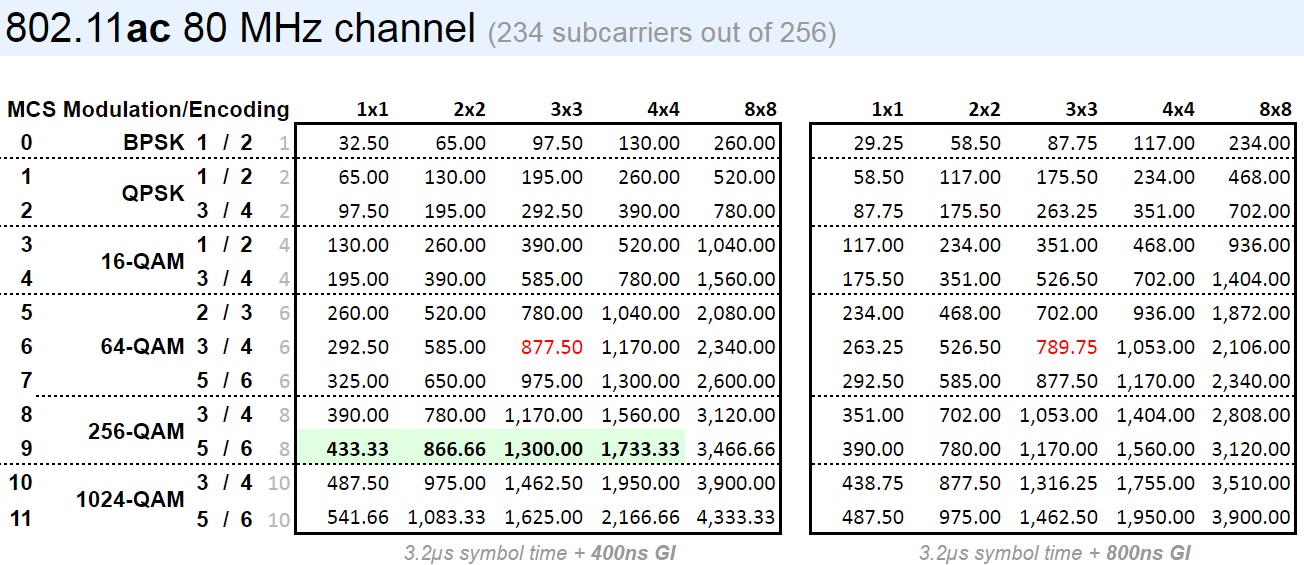 Useful: I often lookup the PHY speed on a client device, and then find that speed in the PHY tables, which reveals a ton of information about wifi on that client (802.11 mode, MIMO level, modulation, encoding, guard interval, channel width). When the same value appears in multiple places, usually a little common sense and deduction about client device capabilities (use devicespecifications.com or phonescoop.com) can resolve the conflict. Most modern clients are capable of 80 MHz channel widths and 2×2 MIMO. If you are not seeing PHY speeds indicating that, then you have something to look into. Other sources of PHY information:
mW: Signal strength in Wi-Fi is all about the mW (milliwatt, or 1/1000 watt). Most wifi devices (routers, clients, etc) have a power output somewhere between 25 mW and 1000 mw. But most devices receiving the wifi signal only see a signal strength of 'around' 0.00001 mW to 0.0000001 mW. Signal strength decreases VERY quickly with distance: Let's say the power output of a router is 975 mW. Inches from the router, you may have a signal strength of 0.04 mW. At five feet maybe 0.0016 mW. In the next room, maybe 0.00001 mW. And across the house, maybe 0.00000001 mW. This is because signal strength decreases very quickly with distance and obstacles (more details in the next section). Look at the table (right) for actual values possible. How should signal strength be represented?: Working with all of these very small mW numbers, like 0.00000001 mW, is very awkward and error prone -- because are you using (or reading) the correct number of zeros? Can we come up with a new unit and numbering scheme to represent mW that is much easier to use? First cut: Use scientific notation. 100 mW becomes 1E2, 0.001 mW becomes 1E-3 and 0.00001 mW becomes 1E-5. Well, we are on the right track because we don't have to count zeros, but 'E' notation is still awkward to use. mW to dBm: To convert from mW to dBm:
dBm to mW: To convert from dBm back to mW:
10 dB: mW powers of ten: Just by looking at the table (above right) and the discussion above, it becomes really obvious that increasing (or decreasing) mW power by a factor of ten equals changing the dBm value by adding/subtracting ten dB. Very convenient.
3 dB: mW powers of two: What do we have to add or subtract from dBm to adjust mW by a factor of two? The answer is incredibly close to 3. So adjusting by 3 dB is halving/doubling mW power. We can actually deduce this from the table above. How many 'times 2' steps are there in going from 1 to 1000? 1, 2, 4, 8, 16, 32, 64, 128, 256, 512, 1024? It turns out that 210=1024, so there are (very close to) ten steps. And ten steps from 0 dBm to 30 dBm means the step size is 30/10 = 3 dB. For those who want to know, the actual value is 10×log(2) = 3.0102999566... dB vs dBm: Whereas dBm refers an to absolute power level (translates to a specific mW value), dB expresses a 'magnitude' difference between two power levels (the difference between two dBm values; the ratio between mW). Summary: dBm is just the mW power level in logarithmic scale, but multiplied by ten. When you see a dBm of -37, you should instantly think that is just a mW of 10-3.7. Think in terms of how many digits the decimal point is moved left/right for the number "1.0" and it 'should' all make sense. For example, -40 is moving the decimal point -4.0 places (so left 4 digits), which results in 0.0001. NOTE: all 'log(#)' in this section are log base 10, or 'log10(#)' More information:
The short answer: The BEST option to improve Wi-Fi range (and far more importantly, to get great speeds at range) is to install an access point exactly where it is needed (and wired/Ethernet to your main router). Seriously. Don't try to extend Wi-Fi signals, because all that accomplishes is a 'very slow speed' at distance. Namely, after successfully extending Wi-Fi, you are then left with the problem of slow Wi-Fi speeds at that extended range -- and how are you then going to improve Wi-Fi speed?
Try both bands: If your primary goal is long range (and not fastest speed), first try connecting to your router's 2.4 GHz band SSID. This will only work as long as the 2.4 GHz band in your area is not too congested (there are not many neighbor AP's nearby). Next connect to the 5 GHz band and test. Technically, the 2.4 GHz band 'has more range' on paper than the 5 GHz band, but sometimes in the real world, the 5 GHz band performs much better.
Client devices almost always determine maximum range (not the AP/router): What determines the maximum range at which a client device can successfully communicate via Wi-Fi with an AP? Assuming that you already have a high quality AP, almost always, the answer is that the capabilities of the client device (and not the AP/router) determines maximum range. But why? The short answer is because Wi-Fi requires two-way communication. From the 'AP to client', and from 'client to AP'. And the weakest of those two directions determines maximum range. Think about it, if you could increase the transmit power in an AP by a thousand times, that certainly would improve 'AP to client' communication, but that power increase actually would do nothing to help 'client to AP' communication, right?
Power Level Model: When an AP transmits to a client, what happens? The AP outputs a certain mW power, which is then sent to the AP antennas, the signal travels through the air (lots of 'path loss'), hits the client antennas, and is received. Likewise, when a client transmits to an AP, the client outputs at a certain mW power, which is then sent to the client antennas, the signal travels through the air (lots of 'path loss'), hits the AP antennas, and is received. So transmit power of both the AP and the client plays a big role in range traveled (to the client, and to the AP). There is significant signal loss (in the air) between the antennas, but (usually) a small amount of 'gain' with each antenna. The wildcard here is that each client device will have a different dBi for its antennas (as compared to another client device), sometimes very small (or even a small loss), sometimes larger (5.2 dBi). The key for understanding this idealistic model is noticing that what impacts received signal strength (in both directions) is: (1) transmit power, (2) transmit antenna, (3) path loss, and (4) the receive antenna. 2.4 GHz vs 5 GHz: The actual frequency (MHz) of the channel used affects range. Because range goes down as frequency goes up. Using this RF loss calculator we can see that the difference (ratio) in range is exactly the same as the difference (ratio) in frequency. For example, in general and at identical power levels, 5 GHz channels have around 50% of the range of 2.4 GHz channels, or a 6 dB hit. So on paper, the 2.4 GHz band has more range than the 5 GHz band, and in real-world testing, that happens most of the time, but not all of the time. Once in a while, the 5 GHz band provides just as much range (and much better throughput). You just need to test.
DFS Channels: Using DFS channels causes an AP to use lower power levels (regulatory constraints). For example, the Netgear R7800 uses 995 mW for non-DFS 5 GHz channels, but uses 243 mW for DFS channels, a change of 6 dB. However, while this does affect PHY speed used, it rarely affects maximum range as most clients are already using a mW power level below 250 mW for ALL 5 GHz channels (so again, the client determines maximum range, not the AP). Example: The Netgear R7800 for DFS channels transmits with 243 mW. The Ring Stick Up Cam Wired for DFS channels uses 54 mW, a 6.5 dB disadvantage for the camera. So the camera ultimately limits range (not the AP). Channel width: Channel width (20/40/80 MHz) used can also actually impact range. You can 'technically' double range (but greatly reduce throughput) by switching from 80 Mhz channels to 20 Mhz channels. Diversity / Beamforming: Using a high MIMO router has significant benefits in improving range and signal strength.
"Can't I easily increase range by using high-gain antennas on my router?": Yes, very likely. But increased range in wifi is actually a double-edged sword. Yes, you might get the extra range you need (but at a slow PHY speed), but that also means that the router is also seeing all of the wifi devices in that extended range! Meaning the likelihood of seeing neighbors' routers and sharing a wifi channel with neighbors goes up significantly. And sharing a channel ultimately means sharing that channel's bandwidth (reduced bandwidth). So unless you literally have no neighbors, don't use high-gain antennas. Instead of thinking "How can I extend the range of my one router", the much better question is "How can I improve wifi signal strength and still maintain good bandwidth". The answer is: by installing another AP exactly where it is needed, wired/Ethernet to your main router. "But I need to improve range of my router!" Are you sure? Re-read above about the likelihood of sharing a channel/bandwidth with neighbors. Plus, you greatly increase the likelihood of experiencing the 'hidden node problem'. Instead, an AP wired/Ethernet to your main router is far superior. Assume you do install high-gain antennas. What happens? All you have accomplished is adding several client devices at range at very slow PHY speeds, causing them to use the bunch of TIME on the channel, potentially slowing everyone else (on the same channel) down. "How about wifi range extenders?": In general, don't use them at all. By definition they consume wifi bandwidth to perform their job (every packet is sent over Wi-Fi twice). Instead, an AP wired/Ethernet to your main router is far superior. Less range in an AP can mean higher throughput: Counterintutively, less range in an AP can actually translate to higher throughput (in areas with a lot of other AP's). With less range, the AP will be a lot less likely to see a neighboring AP operating on the same channel -- meaning the channel used is 100% yours (instead of the channel and bandwidth being shared with neighboring AP). Summary: In general, the power levels of client devices are anywhere from 6 dB to 12 dB below that of your AP -- which means that your client devices (and which band they use, 2.4 GHz or 5 GHz) ultimately determine maximum range possible, not the transmit power levels of the AP. Also, I can not stress enough the need to test actual throughput in both bands. The conventional wisdom and 'on paper' calculations show that 2.4 GHz has 'better range' than 5 GHz, but in the real world, this is NOT always the case! It may be true, but it may not be true. I frequently see a big jump in performance switching to the 5 GHz band. The ultimate cause is noise floor differences. It does not matter if 2.4 GHz has a stronger signal strength if that also means a higher noise floor! A final note that explains some strange observations: The asymmetric Tx power levels between a client and AP can cause strange observations (Wi-Fi seems good and then drops off a cliff and no longer works). For example, at near maximum range for a client, download PHY speeds may still actually be very reasonable and good because it is upload PHY speed that is 'maxing out' and about to drop to zero.
Wi-Fi signal strength decreases VERY quickly with distance, even in free space (with no obstacles). But why? Every house around you (likely) has a Wi-Fi router, and there are a very limited number of unique non-overlapping Wi-Fi channels. So you are definitely sharing Wi-Fi frequencies with some neighbors. But most neighbor Wi-Fi activity won't impact you due to the fact that Wi-Fi signals attenuate rather quickly. Your router often only sees neighbor Wi-Fi activity as a slightly elevated 'noise floor'.
How does mW signal power (seen in router specifications) relate to distance?: The discussion in the section above was all about raw mW power levels, but how do power levels relate to distance traveled by a wifi signal? Naively, twice the mW power means twice the distance, right? NO. To understand why not, we must first understand the Inverse-square law, which states that changes in wifi signal strength are inversely proportional to the square of the change in distance. For example, three times the signal distance means 1/(3×3) times (or 1/9) the signal power (at that 3x distance). Analogy: A great way to visually 'see' and understand this is to consider ever increasing spheres. Imagine an antenna at the center of the sphere and the surface area of the sphere is the radio signal as it travels outwards (in all directions). The (fixed) power output of the antenna must be distributed across the entire surface area of the sphere. Seen right are three spheres of radius 1, 2, and 3 (so a doubling and tripling of distance/radius). The formula for sphere surface area is 4×PI×r2. The critical term to focus on is r2. And you can confirm with your eyes that the sphere of radius 3 has a surface area that is not just three times larger, but 32 (nine) times larger (than the sphere of radius 1). Formulas: The Inverse-square law states that a change in distance squared is inversely proportional to the change in power (in mW):
And simplifying slightly (re-writing the right hand side inverse term), we get:
And then cross multiplying, you get the following formula that makes a lot of 'intuitive' sense:
Namely, the 'old' (left) side of the equation is a 'fixed' value. Then on the 'new' (right) side, you can change either term (power/distance), but there must be a corresponding (and inverse) change in the other term (distance/power) to keep the equation balanced: TIP: The best way to use this final formula is to fill in the three terms that you do know, and then solve for the one remaining unknown term.
6 dB: Doubling/halving distance: To double/halve distance means we need to multiply/divide mW power by a factor of four (22), which is in dB units (prior section) is 3 dB twice, or 6 dB. Unless you are working in a pure 'line of sight' environment, walls and other obstacles will have a far greater (negative) impact on signal strength than distance will. Example 1: One router has a power output of 975 mW. A second router has a power output of 216 mw. Everything else being equal, how much further (distance) can the higher power router communicate with wifi clients? Trick question, because virtually always, the answer is no change at all, because the wifi clients' must still transmit back to the router, and client's power level has not changed at all (and is often slightly less than the router power level) -- so client power levels often limit distance (not the router). Example 2: But, in Example 1 above, how much should dBm improve on wifi clients, hopefully resulting in slightly better PHY speeds (download) from the router to wifi clients, but not a better PHY speed from wifi clients to the router (upload). Answer: Up to 10×log(975)-10×log(216) dB, or 6.5 dB. Example 3: You are 90 feet away from your router and see a -65 dBm. At what distance should you be able to see a -55 dBm? The power ratio is 10(-55/10)/10(-65/10) = 10. So the distance ratio is sqrt(10) = 3.16, and solving for distance we get 90/3.16 = 28 feet. Example 4: At 7 feet from a router you observe a -35 dBm. Estimate at what 'line of sight' distance you will observe -65 dBm. The answer is that with a difference of 30 dB, that is 6 dB five times, meaning a doubling of distance 5 times, so 7×25 is approximately 200 feet. Of course, walls and other obstacles will likely get in the way first and have a greater impact than 'line of sight' distance. An observation: The 'distance' you have to move to halve signal strength starts out very small (very close to the router), but then grows exponentially larger as you move further away from the router. Let's say you are 1 foot from a router. At what distance will signal strength be 1/2 as powerful? Well, distance must be adjusted by sqrt(2) to keep the equation above 'balanced', so 1.41 feet (a change of 0.41 feet). Now step 10 feet away and repeat -- the adjustment is now 4.1 feet. Now step to 100 feet away and repeat -- the adjustment is now 41 feet.
It is not immediately obvious, but the decision as to which channel width to use in a Wi-Fi access point (20/40/80/160) actually alters and affects: (1) the range of the Wi-Fi signal, and (2) signal strength/quality for all clients. Almost all home access points use 80 MHz channels because speed ends up being far more important than range (and don't even notice, or just live with, the slightly reduced range). Wider channels reduces range: Each time you double Wi-Fi channel width (20->40, 40->80, 80->160) you decrease Wi-Fi range by around 30%, or signal strength by 3 dB. This is a key reason many low-bandwidth IoT devices intentionally want to stick to the smallest channel width possible and avoid 802.11ac (which mandates 80 MHz channel support) and stick with 802.11n (which has 20 MHz channels), because that allows operation at the longest distance possible.  Maximizing Wi-Fi range (by sacrificing speed): If being able to connect to a router in 5 GHz at greatest distance -- at any speed -- is far more important than having the fastest speed possible, configure that access point to only use 20 MHz channels (Netgear's name for 'channel width' is 'Mode'). Clients should now see the ability to communicate with the access point from a slightly further distance (albeit at a slower speed and on a 20 MHz channel). TIP: Alternatively, some clients allow the 5 GHz channel width to be specified/forced to 20 MHz (normally a client would just use the channel width of the access point). This has the huge advantage of allowing you select an 80 MHz channel on the router (so most clients get 'fast speed'), and then only setting 20 MHz channels for those few (far away) clients that need 'extra range'. Client devices often limit range: Most mobile (on battery) client devices do NOT transmit at the maximum power level allowed (like most routers). Instead, client devices intentionally transmit at a lower power level to conserve battery power. The end result is that the client device may often limit maximum distance from the router (and not the router itself). If your client device is able to see a weak router SSID in the wifi list, but is unable to connect to it, the router-to-client signal strength may be OK, but the client-to-router signal strength may be too weak. A final note: This section is more about understanding Wi-Fi. Changing the 5 GHz channel width to 20 MHz does extend range (a little). But if it is range you need, try both the 2.4 GHz and 5 GHz bands and select the one that works best for you (as every location will be different due to different noise floors). Or, install an AP (wired/Ethernet to your router) where it is needed.
In summary: The 2.4 GHz band can (not always, but often times) have an incredibly high 'noise floor' as compared to the 5 GHz band. So while 'on paper' the 2.4 GHz signal 'goes further' than the 5 GHz signal, you will likely experience much better throughput on the 5 GHz band due to this noise floor difference (a higher MCS level actually used in 5 GHz vs 2.4 GHz). KEY Wi-Fi concept: The PHY speed (and throughput) you experience in Wi-Fi is determined not by RSSI, but by SNR (or in other words, where the 'noise floor' is).
Noise floor: When a router tunes into a wifi channel and amplifies/processes it, at some point (with no one on the channel), there is only a 'hiss'. The dBm level of that hiss is the 'noise floor' (blue line graph right). Often times this 'noise floor' is 'around' -95 dBm to -100 dBm. I have seen the noise floor for a band vary by as much as 23 dB (-105 dBm to -82 dBm), and the only thing that changed is physical location (of my travel router; different State). That is rather interesting, because it implies that where you are located (actually how congested Wi-Fi is around you) can actually have a VERY measurable impact on the SNR (and Wi-Fi speeds) you experience. Signal level: Now start communicating on the channel and examine the dBm level of the signal on that channel (green line in graph right). The dBm level of that received signal is called RSSI. Often times between -35 dBm and -70 dBm. RSSI stands for "Received Signal Strength Indicator" (wiki info). And while RSSI officially is a 'relative' number (to itself), with no (official) direct relationship to dBm, RSSI is often converted via formulas and displayed as just that (a negative number followed by "dBm"). SNR: The difference between the signal level and the noise level is called the "Signal to Noise Ratio" (wiki info). SNR units are dB. So this means SNR is a relative number (not absolute number) that indicates how 'loud' a signal is vs background noise. A signal can only be 'heard' and understood as a signal by a device only as long as it is adequately above the noise floor. Analogy: Talk normally in an empty room, and you can easily be heard, because the 'noise floor' is so incredibly low (high SNR). But talk normally again (so RSSI signal level is the same) in a bar, and you won't be heard, because the 'noise floor' is so high (low SNR) relative to the signal level. The same thing applies to Wi-Fi. As long as the SNR for a Wi-Fi signal is 'good', that signal will be heard and understood. Why is the 2.4 GHz noise floor often much higher (worse) than the 5 GHz noise floor? Because of the incredible success of 2.4 GHz band. Virtually every single home is broadcasting 2.4 GHz signals, and the noise floor you see (in your home) is just the greatly attenuated 2.4 GHz signals from all other homes. Because 5 GHz signals attenuate more through free space (and obstacles), that is providing a noise floor advantage for 5 GHz. I often see the 2.4 GHz noise floor at/around -86 dBm. Whereas for 5 GHz, the noise floor is often around -105 dBm. Wi-Fi SNR is underreported: The 'noise floor', 'signal level', and 'SNR' are all underreported numbers in Wi-Fi. Some higher end vendors report all of this information, but many vendors report almost nothing. And the reason it is so important is because if you are in a 'noisy' environment, even with a strong signal, you will get very poor throughput. Conversely, a weaker signal but with a very low noise floor, can still get very good throughput. The implication is that knowing RSSI is a clue for knowing throughput, but you won't know for sure until you also know the noise floor (and SNR).
SNR vs channel width: Each time you double channel width -- from 20 MHz to 40 MHz to 80 MHz to 160 MHz requires 3 dB more in SNR to maintain the same modulation/coding (source), and if you don't have that SNR headroom, the modulation/coding rate will drop (see Wi-Fi Channel Width vs Range for why). TIP: What this means is that if a device is having trouble maintaining a Wi-Fi connection (and can't be moved closer to the router), and you would rather have a much slower PHY connection that stays up all of the time (than a faster connection to drops in and out) -- try reducing channel width (from 80 MHz to 40/20 MHz). SNR sensitivity: Here are the IEEE 802.11 SNR that each modulation/coding requires. Take these as ballpark figures, as your mileage may vary slightly: 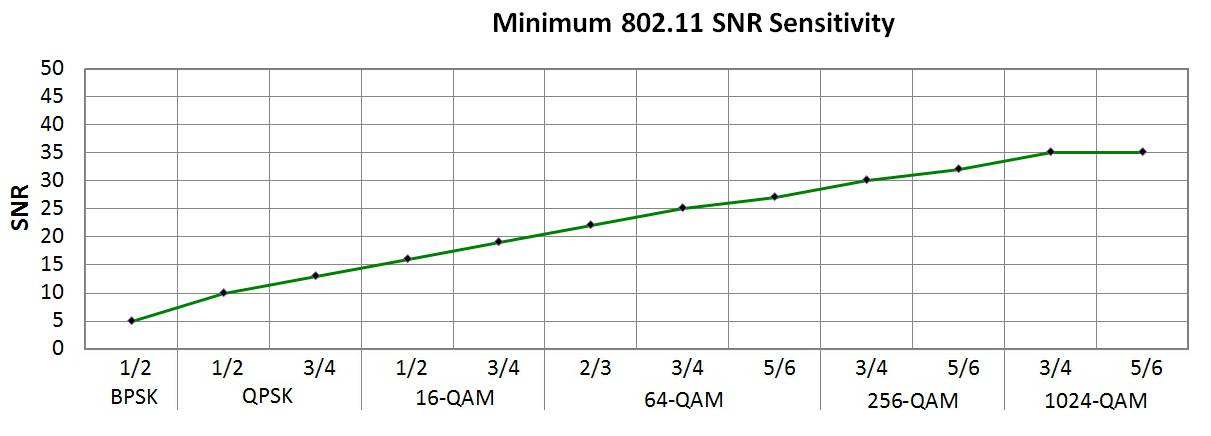 Atheros RSSI is really SNR: In routers when you obtain RSSI from system tools that use a Qualcomm Atheros wifi chipset, the RSSI value is the dBm signal level with the noise floor subtracted out. That is just SNR! More information:
Many AP/routers have the ability to 'telnet' into the device and run Linux commands. This section documents some of what I use on Netgear's R7800 router (uses the 'Qualcomm Atheros' chipset; immediately below) and Netgear's R6250 router (Broadcom chipset; further below). This has been invaluable to analyze the wifi behavior of a 'locked down' devices (what channel width, Tx and Rx PHY speeds, etc the cam uses). Netgear: Enable telnet: On many Netgear routers, visit "http://routerlogin.net/debug.htm" (and sign in) and check the 'Enable Telnet' checkbox. Then "telnet routerlogin.net" (LAN only, not WAN) and use the web interface password to sign in (if asked for 'login' username, use 'admin'), and then dive into the deep end... TIP: When analyzing a device (like a Ring cam), only have that one device connect to the router via wifi (so all wifi stats on one wifi band must be from the device being tested). And then on your PC, telnet to the router via Ethernet (or the other wifi band).
Qualcomm Atheros based AP: athstats -i wifi0|wifi1: [Atheros] Outputs tons of internal wifi statistics by band. By far the most useful are "Rx MCS STATS" and "Tx MCS STATS", which displays the number of packets sent/received for each MCS index (PHY speed)! Also, lists a noise floor that varies (but trying to confirm it is accurate). See header source code for a short description of items displayed.
wlanconfig ath0|ath1 list sta: [Atheros] Lists every wifi device connected to the router, with very useful information per device (mac address, channel, TxRate, RxRate, RSSI, 802.11n mode, channel width, etc). wlanconfig.c source code The TxRate and RxRate displayed appear to be kilo (1024) based numbers instead of bps (1000) PHY based numbers. So multiply by 1024/1000 to correct back to 'bps'. iwconfig: Lists 'wireless' information (if any) for each interface on the system. Includes SSID name, maximum bitrate and transmit power (in dBm units) for each wifi band. See also "ip link show", which enumerates all interfaces on the router. This is incredibly useful to clearly 'see' the difference in transmit power (in dBm units) between the different bands/channels in 5 GHz (using DFS channels in 5 GHz have a 6 dB penalty). Also of note is that these power levels do NOT include antenna gain. arp: Outputs a list of 'MAC address to IP address' mappings. iwlist: Get detailed information about interface capabilities A very cool graphical Atheros "MCS Spy" tool: Check out this MCS Spy tool, which displays Wi-Fi MCS index usage in real-time. It becomes incredibly obvious after running this tool that not only are PHY speeds asymmetric, but that there is no single PHY speed in one direction. Rather, the PHY speed is constantly fluttering around. This is especially evident when the device being tested (eg: tablet) is moving around (with a person walking). Future Research: Often times, the R7800 reports a noise floor of -105 in 5 GHz and -97 in 2.4 GHz. Does that explain why RSSI in 5 GHz on a client device is better than raw calculations (of AP transmit power and free space path loss) show it should be? Or is the difference fully explained by beamforming alone? Broadcom based AP: Broadcom based devices will have the wl command (command line reference). Here are some very useful commands... ip link show: Enumerates all 'interfaces' on the AP. wl -i eth1|eth2 status: Displays lots of information about the AP, including SSID, BSSID, supported rates, HT/VHT capabilities, noise floor, etc. wl -i eth1|eth2 channels: Displays the list of valid channels. wl -i eth1|eth2 assoclist: Outputs a list of all client MAC addresses currently associated with the AP. wl -i eth1|eth2 sta_info x:x:x:x:x:x: Output detailed statistics for ONE client device connected to the AP (by specifying the client's MAC address). Example output:
Quantenna based AP: This post points to using this command:
with some of the valid "CMD" being:
Linux in general: A very helpful command is:
where 'DEVICE' is 'wlan1' (or similar). You will see information like:
Netgear R7800 TCP/IP packet captures: I travel a lot and often need to packet capture Wi-Fi devices for debugging purposes. So I travel with a Netgear R7800 configured not as a router, but as an AP (access point). This also works around a bug that the R7800 has with packet captures while in 'router' mode. Method One: Use TCPDUMP on the R7800: I then plug the R7800 (AP mode) into the local network/router, connect the devices to test to my AP (Wi-Fi), and start debugging. My steps for obtaining a packet capture on the R7800 (you can probably use this as a template for obtaining a PCAP on your router/AP): WARNING: Netgear just released new .74 firmware that breaks TCPDUMP on the R7800 in AP mode, but the steps below still work with the older 1.0.2.68 firmware.
I PCAP to 'local storage' on the R7800, rather than directly to the USB drive, because local storage is a lot faster than the USB drive (otherwise a lot of packets will be dropped if tcpdump writes directly to the USB drive). But the downside of this is that you can only PCAP a couple hundred MB of activity, which is fine for my work. An alternative is to capture directly to the USB drive, but only capture the first 100 bytes of each packet (change "-s 0" to "-s 100"). If tcpdump still reports that packets are being dropped by the kernel, try increasing the kernel buffer size (-B command line option) -- but the '-B' option is not available on the R7800. Method Two: A much better PCAP alternative for most: An alternative that also works very well (and requires no router telnet access) is use the "WAN Port mirror to LAN port1" option on the R7800 "/debug.htm" web page. Then, plug your PC wired to port1 on the router and capture directly (on your PC) using WireShark (capturing the PC 'LAN connection'). In effect, LAN port 1 on the R7800 still functions (so your PC still works to the Internet), but your PC now also 'sees' all WAN traffic (as if the R7800 were now a 'hub', instead of a 'switch'), allowing all traffic (heading out the WAN port on the R7800) to be captured. The big advantage of using TCPDUMP on the R7800 itself (far above), is that the capture can be done 'remotely' (don't need to be physically next to the R7800).
WiGig (802.11ad) is effectively dead in routers for Internet access. It just never 'took off'.
802.11ad: 802.11ad (also called WiGig) is being marketed as the 'fastest' wifi possible, providing speeds "as fast as 4.6 Gbps", for '4K Streaming, VR Gaming and Backup' (Netgear, right), or for transferring an hour of HD video in 7 seconds. [source] Huge disadvantage: However, the huge disadvantage of 802.11ad is that is has no range and does not go through walls (or obstacles). It is intended to only be used line-of-sight in one room and has a range of just a few meters. [source] Range: At the same transmit power, 5 GHz has 1/2 (50%) the range of 2.4 GHz, but 60 GHz has 1/25 (4%) the range of 2.4 GHz, as measured in free space, or 'air'. [RF loss calculator] 802.11ac: Interestingly, 802.11ac products already exist TODAY that provide 4.3 Gbps (Arris TG3482G using the Quantenna QT10GU). That kind of puts Netgear's marketing hype ("3X faster than 11ac") into perspective. Conclusion: 802.11ad may take hold in very specialized situations (laptop docks, wireless displays, VR headgear, etc), but unless the range issue is addressed, 802.11ad will absolutely NOT become a replacement for wifi for generalized internet access for an entire home. UPDATE: This is all but confirmed now that 802.11ax (Wi-Fi 6) -- the successor to 802.11ac (Wi-Fi 5) -- is out. Wi-Fi 6 effectively kills 802.11ad from ever being widely adopted for internet access. Instead it IS being used for very short distance point to point (laptop computer to dock).
Beware all of the marketing hype surrounding tri-band routers. Tri-band routers were created by the router industry so that marketing could (yet again) claim even higher Wi-Fi Gbps speeds for new routers (a single connected client can never achieve these high speeds). A router is many devices in one: Remember, a wireless router is: (1) a router, (2) a switch, and (3) an AP -- all in one box. The AP is almost always dual-band (2.4GHz + 5 GHz). But the latest marketing hype concerns the speeds of tri-band routers -- where the AP inside the router is 2.4GHz + 5 GHz + 5 GHz. But 'dual 5 GHz' is only useful if you are maxing out your current 5 GHz band, and need to support more (5 GHz only) devices. But are you? This is important to realize, It DOES NOT make one device faster. Rather, it allows 5 GHz devices connected to different 5 GHz bands to operate at the same time (two devices connected to the same band will have the same problem). RF Interference: When there are multiple antennas in the same AP/router operating on the same band (5 GHz), near to the same frequency, there WILL be interference, which can reduce data rates. This mainly happens when one band is receiving and (at the same time) the second band is transmitting. One mitigation is a proper separation in channel numbers (the wider the better; at least three times channel width) because if not, there will be too much interference. The ideal fix is physical separation of the AP's. And that is why simply using a second AP (physically separated and located where it is really needed) is the best solution. Details And since (virtually) all Netgear routers are missing support for channel 138, that may limit your options running 'dual 5 GHz'. Instead of tri-band, use a second AP instead: BUT, if you are this situation, if is far more cost effective to just add a second AP ($158 for a high end Ubiquiti nanoHD Wave2 AP) -- wired (Ethernet) to your existing router rather than throwing everything away and buying only a tri-band router (for around $500) placed in a central location. Plus, the advantage of a second AP is that you can physically position it (separate from the router), on its own channel, exactly where it will do the most good. And physical separation between AP's make a lot of sense. Would you buy two AP's (same band) and place them literally on top of each other? Of course not. You would spread them around where they are needed. But with a tri-band router, that is exactly what you are doing (placing two AP's on top of each other). Don't fall for the marketing hype! If you need a new router and can get a deal on a router and it happens to be tri-band, go for it. But upgrading from a high end dual-band to a tri-band because you think it will be a lot faster because the Mbps rating is much higher is not a good thing. Tri-band without full DFS channel support is insane: There are vendors that sell tri-band routers without any DFS channel support! Without DFS channels, there are only TWO 80 MHz channels available in 5 GHz. A tri-band router must then use both of the only available channels. You have no choice. That dramatically increases the likelihood of sharing a channel (and bandwidth) with a neighbor. Be practical: Don't go out of your way looking for a tri-band router. But if you just happen to find a capable one at a fantastic price, go for it. Just realize that you have two AP's in a single location (that you can not physically separate), and keep the channels for the two AP's as far apart as possible.
The bottom line: Add wired Ethernet (and spare cable) everywhere you can in a new home during construction, like to AP locations and all streaming (TV) device locations, etc. KEY Wi-Fi concept: Use wired/Ethernet connections whenever possible. Only use Wi-Fi when that is the only connectivity option. But isn't the future all wireless? If so, then so is slow Wi-Fi and packet loss! Yes, wireless continues to improve (a lot), but the simple fact is that wireless can't come close to the incredible speed and reliability of wired connections (which are also improving a lot). When I built a new home in 2005-2006, my builder tried to convince me that installing Cat5e everywhere was not needed because everything was going 'wireless'. Wire everything you can: So, for speed and reliability, you should use Ethernet for everything in a house that you possibly can, and that requires planning (and then use wifi for only those devices that can't be wired). Ethernet is full duplex, and Ethernet 'switches' allow for full speeds between different ports on the switch. Structured Wiring: Take some time to research 'structured wiring'. The bottom line is that all 'low voltage' wiring (Internet / CATV / phone / etc) in a home must be direct one-to-one (a 'home run') to a centralized location (the structured wiring cabinets). NO wiring may be 'daisy-chained', looped, or split. This provides for the highest quality connections (and allows for reuse for maximum flexibility 'down the road'). One room in a new home had two CATV jacks, but the structured wiring cabinet only had ONE run to that room. The installer accomplished this via a CATV splitter somewhere in the walls! He clearly did not understand 'structured wiring' (or was trying to hide a wiring mistake). Add spare CAT6a everywhere! To every location you can think of, run the wires needed for the service at that location, but then also add spare CAT6a as well. Consider these locations:
The cost of adding spare CAT6a during construction is nothing compared to the inconvenience of trying to add wires after-the-fact (which frankly, is often impossible). Possible alternative?: Consider adding strategic 'smurf cable' (empty conduit) runs to many locations. Wired LAN/Internet in every room: Plan on having one or two wired LAN/Internet jacks in every room. Even if not connected to RJ45 ends immediately, you want the wires 'in the walls' when the home is built, so that you can turn them into wired connections immediately, or as they are needed. CAT6 is incredibly versatile: You can run almost anything over CAT6 cable, with the right adapter (USB / VGA / HDMI / audio / etc). So when you have spare CAT6 in every room, that allows you to make changes 'down the road' that you can't foresee today. An example where planning ahead really paid off: In a new home, there was a spare CAT5e to every TV RG6 location. I am sure glad that I had that 'spare', which just recently was turned into wired Internet for every Smart TV in the house (so no wifi is used for streaming). Also, since every room had two wired Ethernet connections, several runs were repurposed for AP's. My personal experience: I built a new house in 2005-2006 and here was my structured wiring checklist (at that time):
However, in hindsight, the changes I should have made:
A final thought/observation: Plan for more structured wiring space/cabinets than you think you need. One thing that I did not properly plan for is all the additional powered devices added into the structured wiring panels after the fact (and many years later) -- and taking into account the SPACE that the additional power cords/bricks uses up. I had initially planned on having only four powered devices (modem, router, and two 16-port switches), but over fifteen years, I have since added seven more powered devices into the cabinets. Managing the space for all of those power cords/bricks was a challenge. I actually needed to slightly change the layout of both panels (years later) to make room.
Main Router Placement: Imagine straight lines from the antennas on your main router to all of your Wi-Fi client devices. Place your main router somewhere so that:
Don't hide your router: You want your router 'out in the open'. Do not place your router inside a cabinet, or on the floor under furniture. Instead, place the router so that it is very visible from all directions. I was once at a rental house where the Wi-Fi router was in a piece of furniture, in a closet (with a door), in a bedroom, located along an outside wall of the house. So half the house had only OK Wi-Fi signal and the far half of the house had no Wi-Fi signal. The solution would have been to move the main router to the middle of the house (like the living room), and place the router out in the open. And don't overlook adjusting router 'height': Don't restrict yourself to only moving the router left/right. Also consider moving the router up/down (eg: on top of a shelf or hutch). It is all about finding the best location that best minimizes the most obstacles for 'at range' client devices. Mesh/Extender Nodes with wireless backhaul: Place the node so that the PHY speeds for each of the two paths (router to node, and node to furthest client device) are approximately the same speed. But because discovering the PHY speed of the two paths may be very hard, as a 'general rule', place a node roughly half way between the main router and the furthest client you must support -- but also place to minimize obstacles! Take advantage of long hallways where there are no obstacles to degrade the Wi-Fi signal. Mesh/AP Nodes with a wired backhaul: Since there is a reliable backhaul to the main router, think of large similarly sized spheres (the wifi signal) emanating from each node in your network -- and place all nodes so that (a) each Wi-Fi client potential location is covered, and that (b) all spheres just barely touch. OR, just place the AP's where they provide the maximuim value for the most client devices, most of the time. Namely, in the living room, in a kids playroom, or in the home office. Obstacles impact Wi-Fi signal strength MUCH more than air/distance: What degrades Wi-Fi signal strength the most are the obstacles that the Wi-Fi signal must pass through, not air/distance. A Wi-Fi signal can easily go hundreds of feet without any obstacles, but as soon as you start adding walls (and anything else), signal strength degrades very quickly. So if you can place a router so that the Wi-Fi signal avoids a wall or two for a far away client device, that will help a lot. TIP: Rotating the router can sometimes help (a little): The Wi-Fi signal range radiating out of a router is almost certainly not a 100% symmetrical sphere. Instead, think of a sphere that sometimes has indentations. This means that simply rotating the router 90°, 180°, or 270° can sometimes improve the signal strength for a key far-away room just enough to be helpful. But beware -- if this technique actually works and helps you, that the 'bad Wi-Fi signal' will also be rotated the same amount (and moved to a different part of the house, or hopefully outside the house, where it does no harm). TIP: Antenna orientation: Sometimes moving the antennas on the router slightly can improve the signal strength for a far-away client device. You just need to try and test. Using the MCS Spy tool (to confirm MCS indexes used in real-time), I was able to change the MCS level used by a far away device from MCS index 1 to MCS index 2 (doubling the speed) simply by moving the antennas on my AP slightly. |
|||||||||||||||||||||||||||||||||||||||||||||||||||||||||||||||||||||||||||||||||||||||||||||||||||||||||||||||||||||||||||||||||||||||||||||||||||||||||||||||||||||||||||||||||||||||||||||||||||||||||||||||||||||||||||||||||||||||||||||||||||||||||||||||||||||||||||||||||||||||||||||||||||||||||||||||||||||||||||||||||||||||||||||||||||||||||||||||||||||||||||||||||||||||||||||||||||||||||||||||||||||||||||||||||||||||||||||||||||||||||||||||||||||||||||||||||||||||||||||||||||||||||||||||||||||||||||||||||||||||||||||||||||||||||||||||||||||||||||||||||||||||||||||||||||||||||||||||||||||||||||||||||||||||||||||||||||||||||||||||||||||||||||||||||||||||||||||||||||||||||||||||||||||||||||||||||||||||||||||||||||||||||||||||||||||||||||||||||||||||||||||||||||||||||||||||||||||||||||||||||||||||||||||||||||||||||||||||||||||||||||||||||||||||||||||||||||||||||||||||||||||||||||||||||||||||||||||||||||||||||||||||||||||||||||||||||||||||||||||||||||||||||||||||||||||||||||||||||||||||
Wi-Fi 4/5/6/6E/7 (802.11 n/ac/ax/be)
Information and Tips
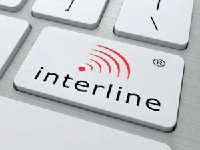
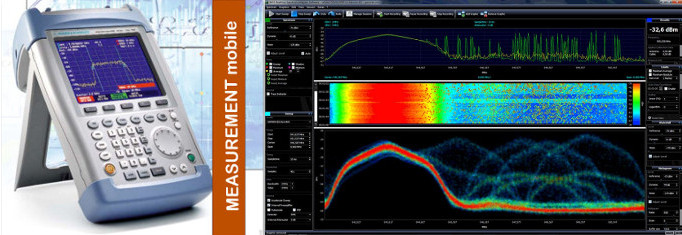

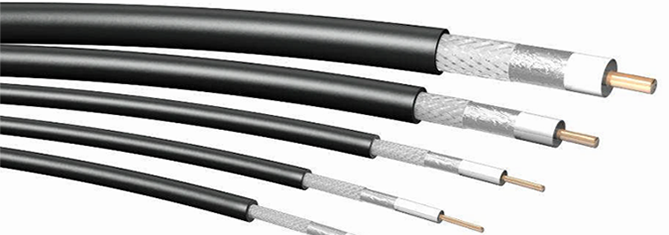
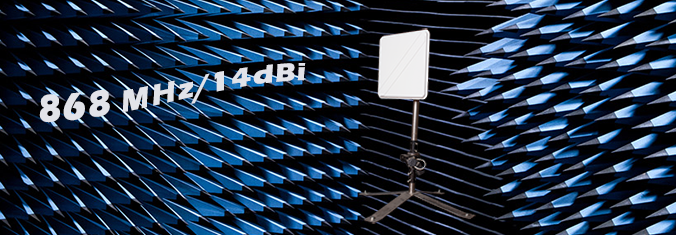
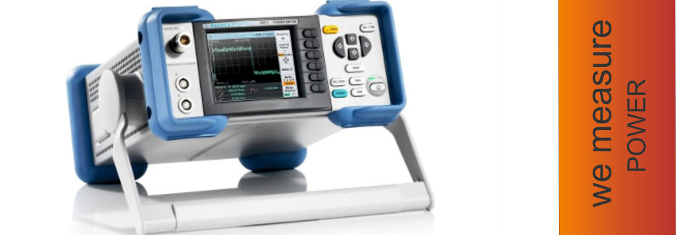
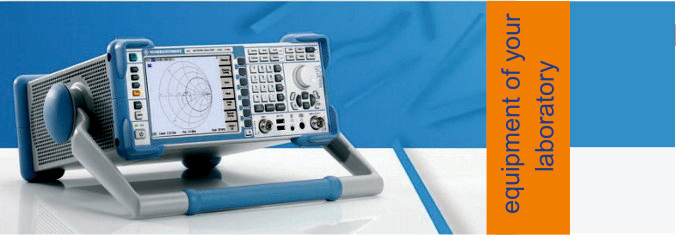

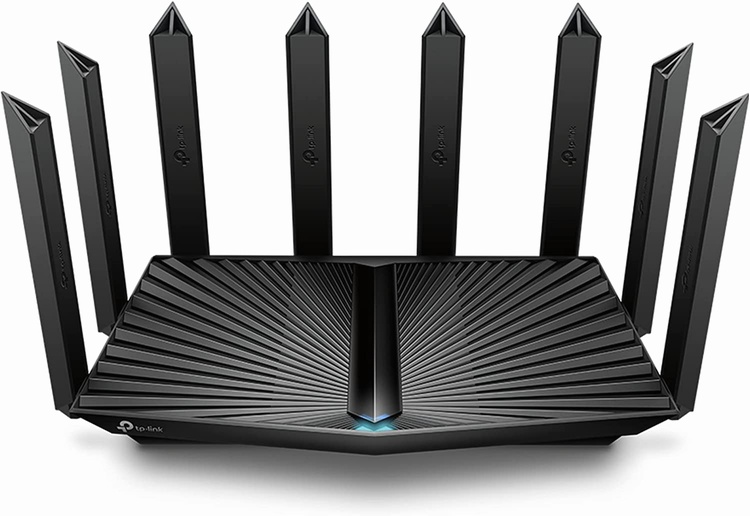
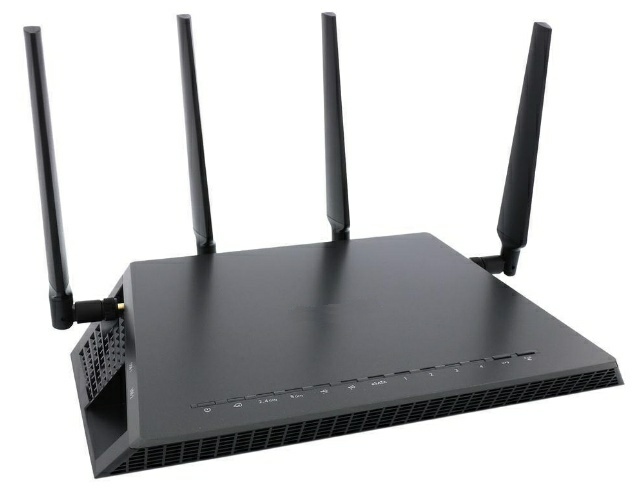


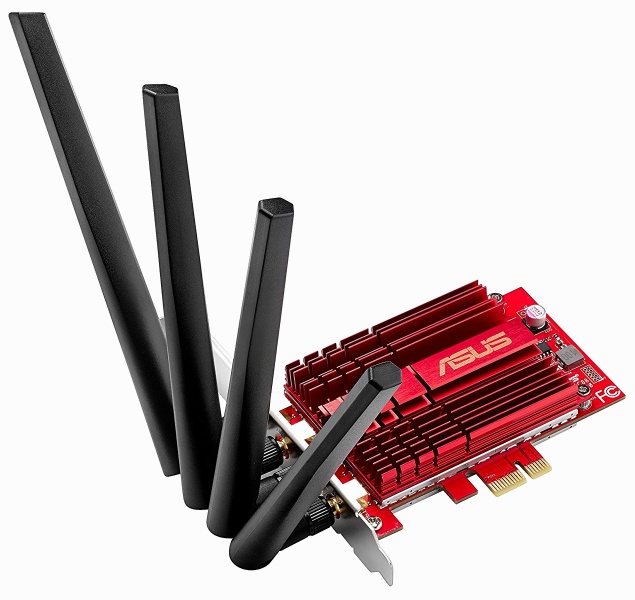
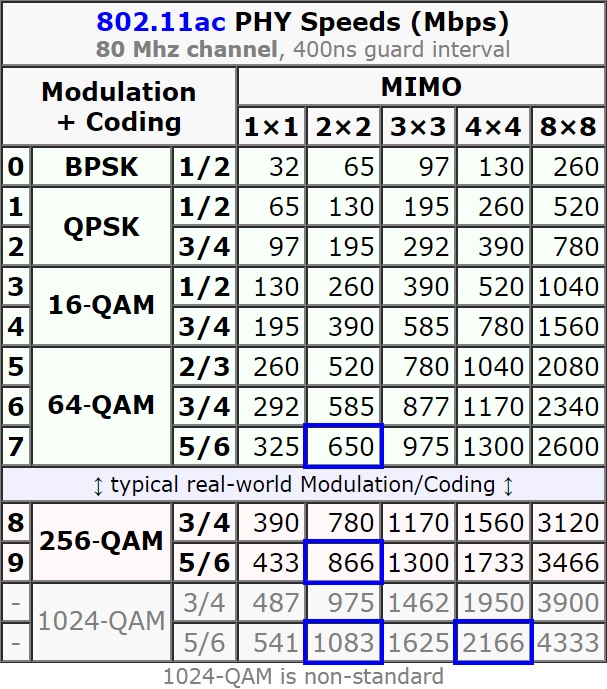
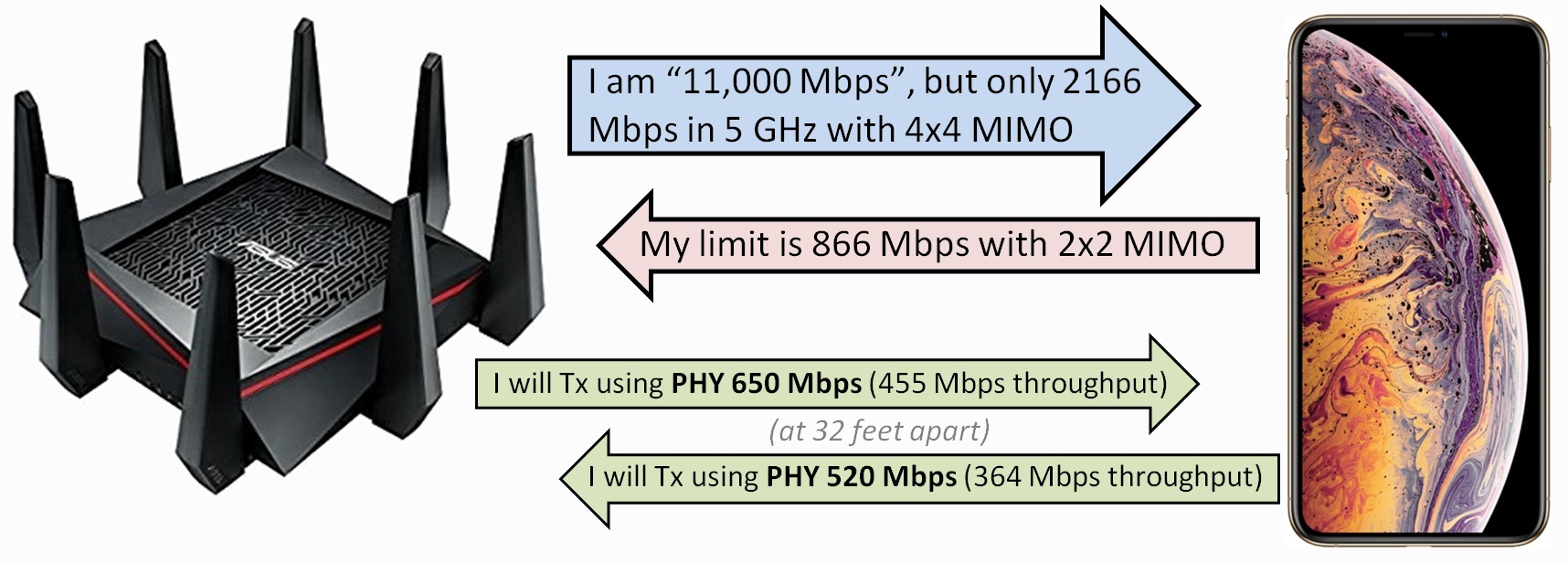
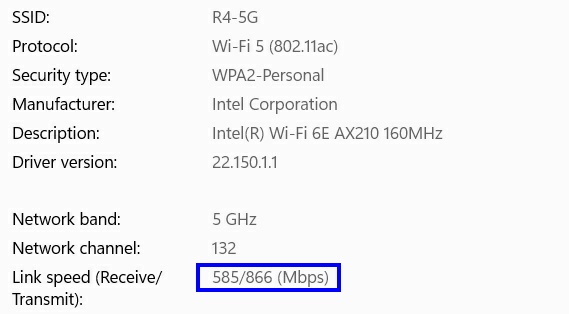
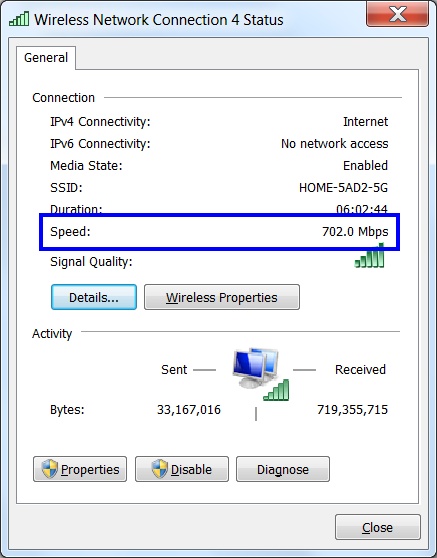
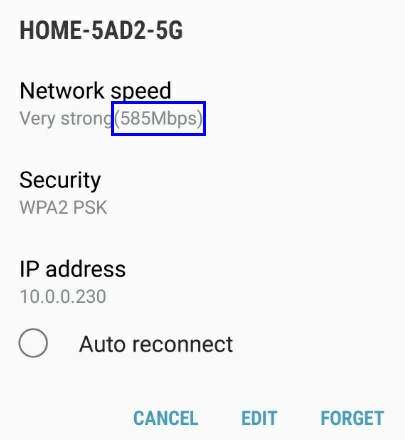
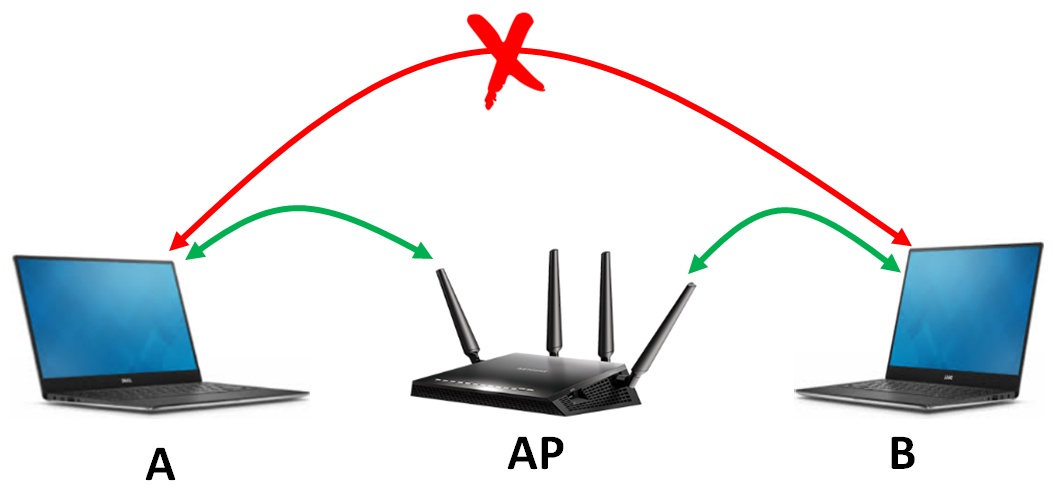
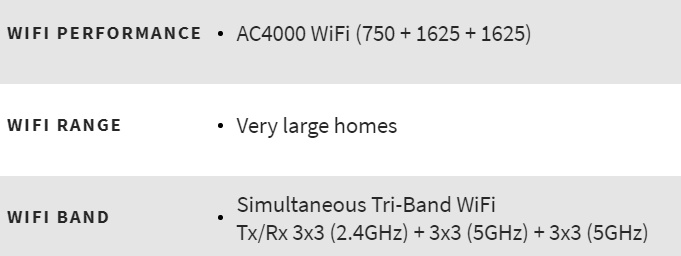
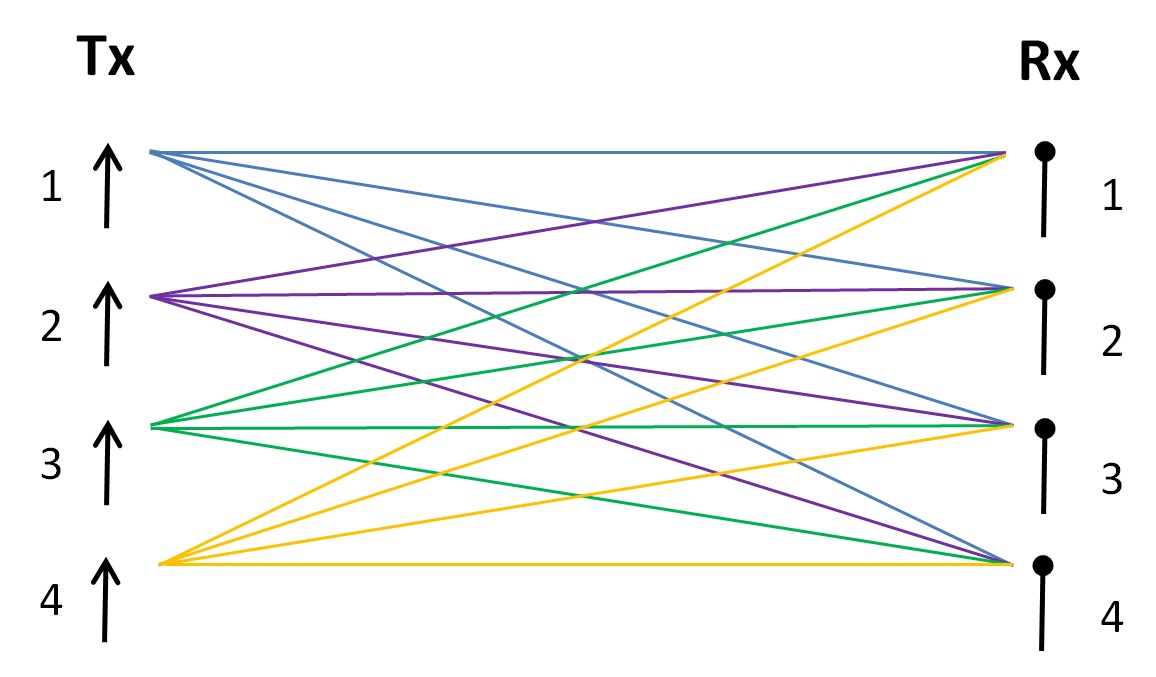
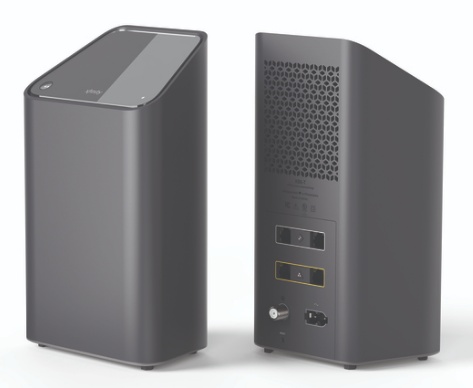


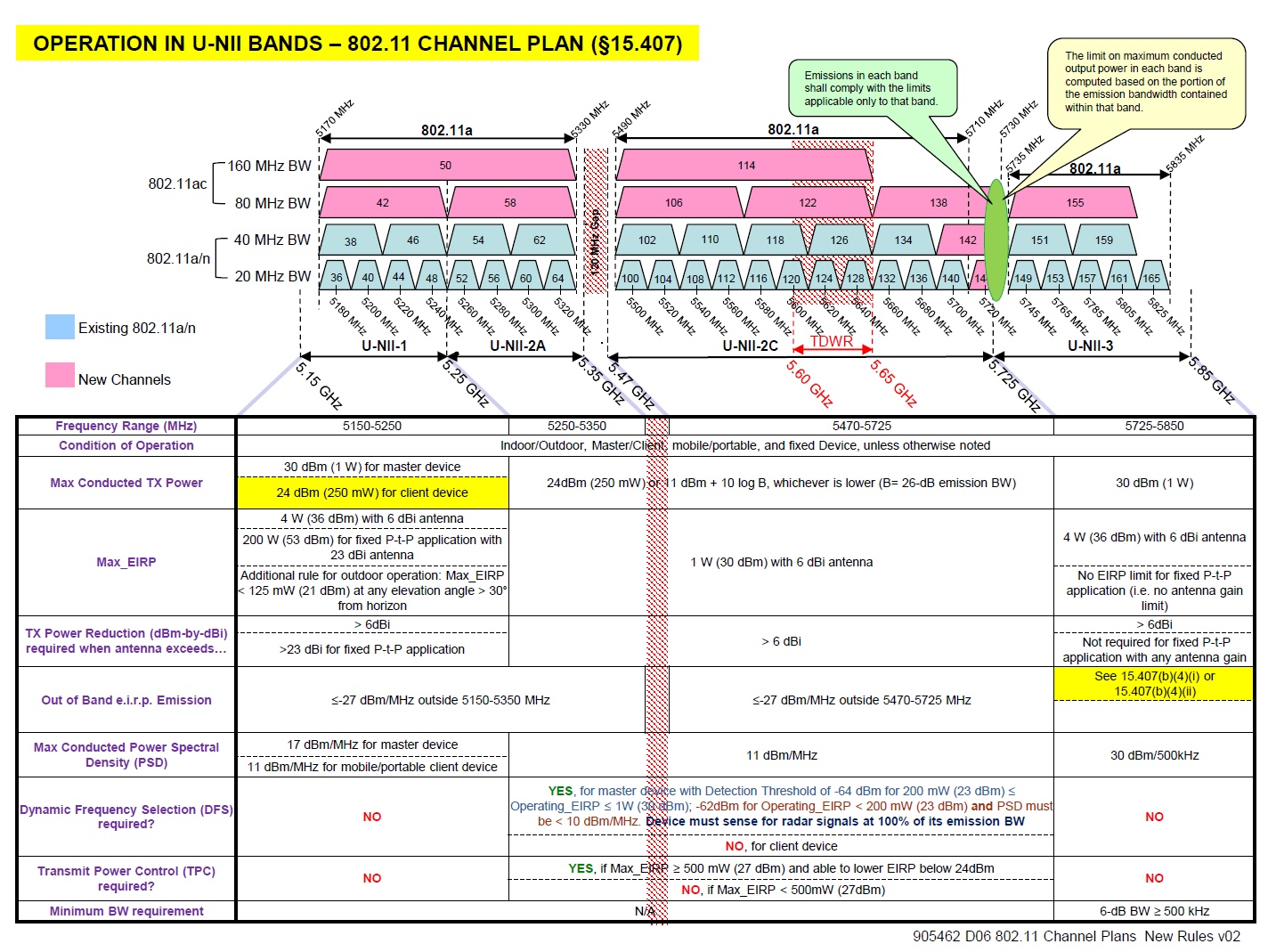
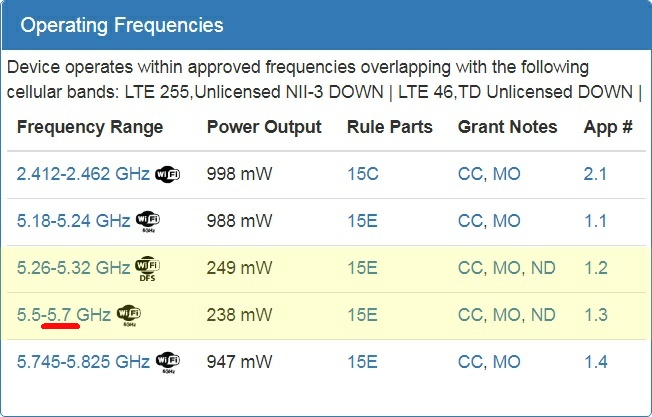
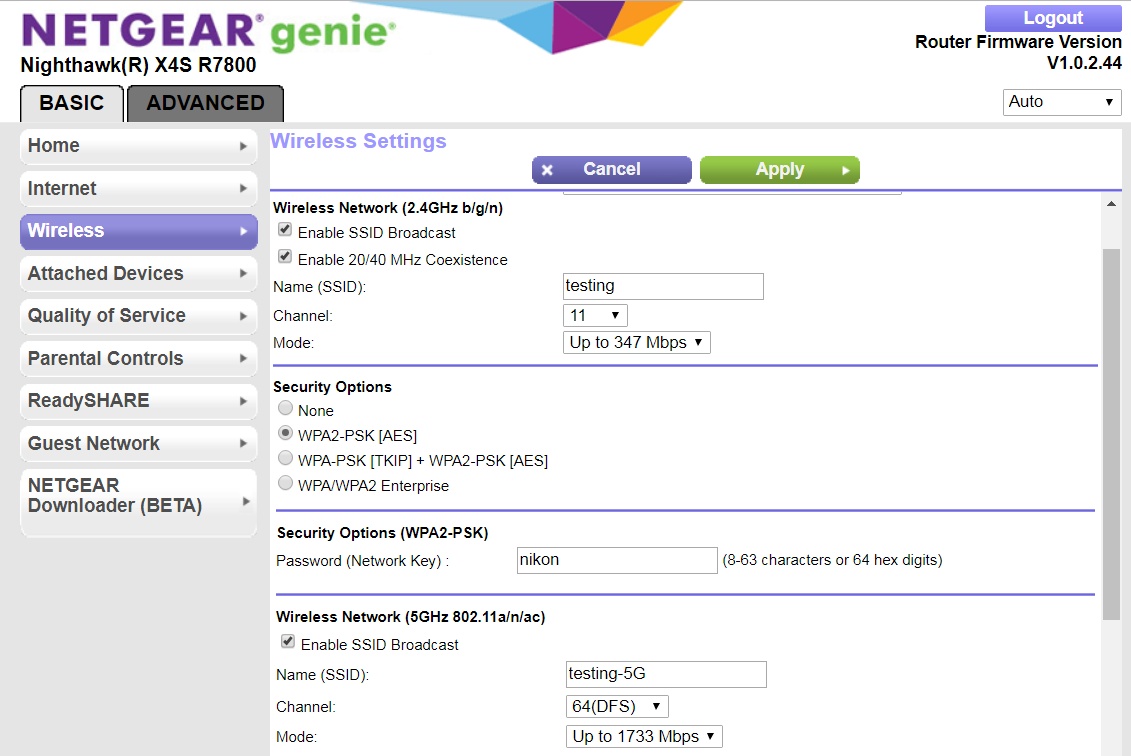
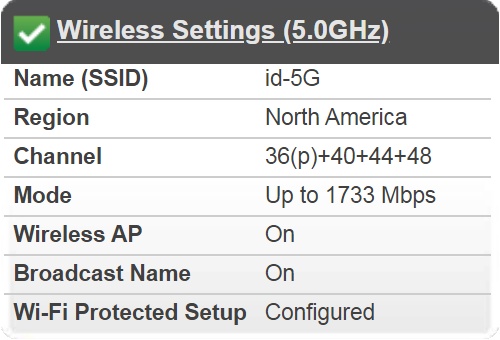
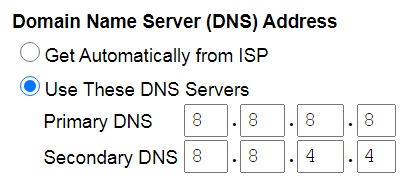
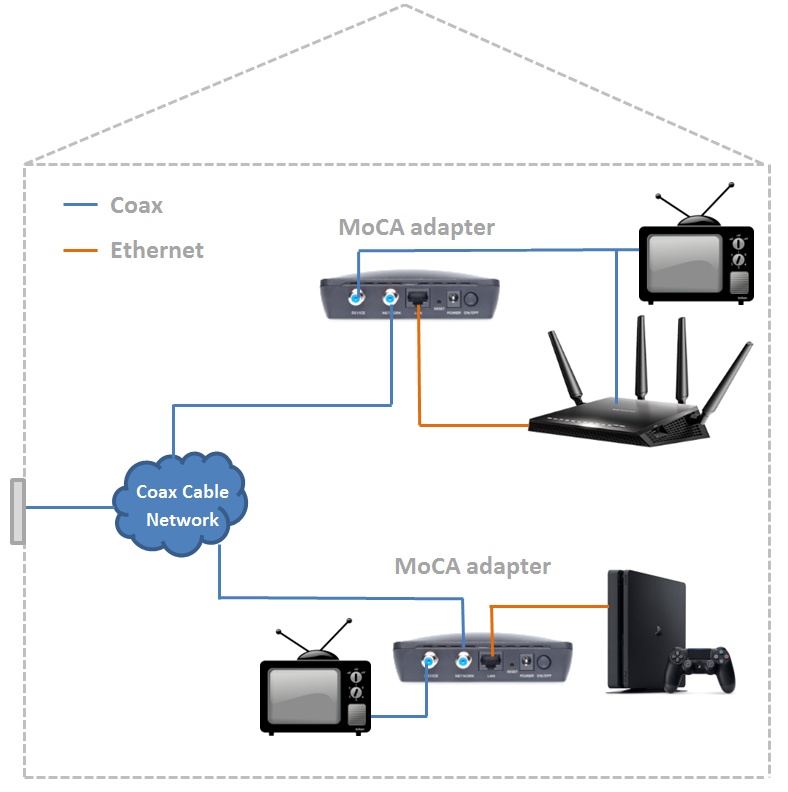
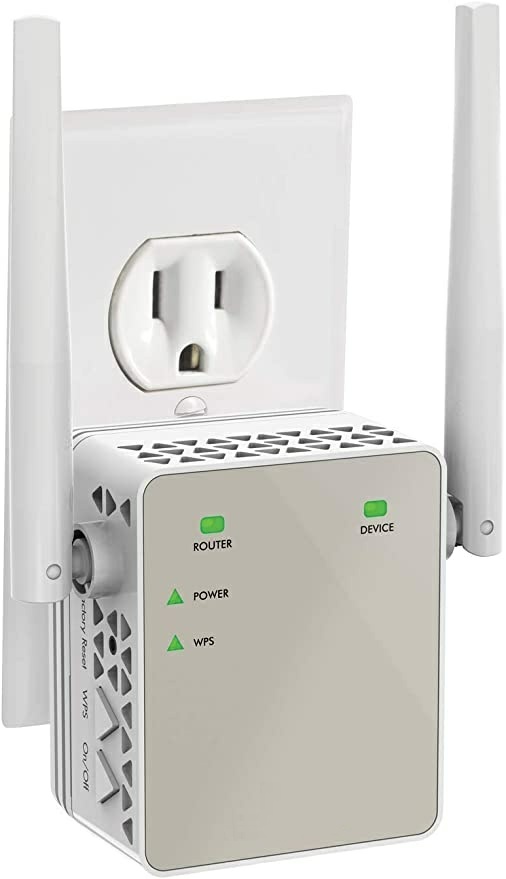
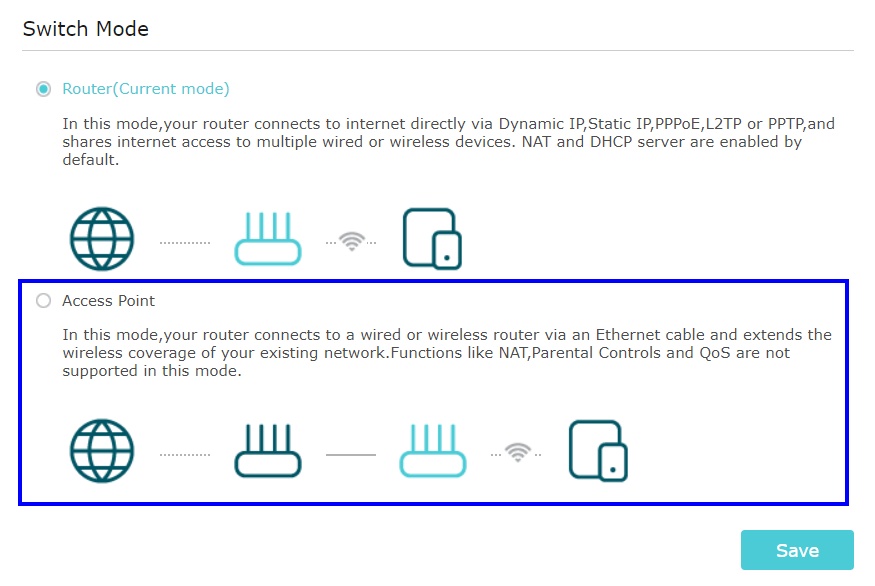
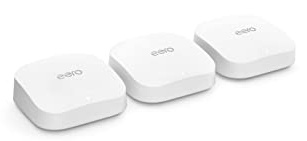
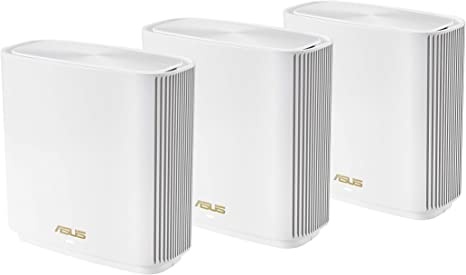
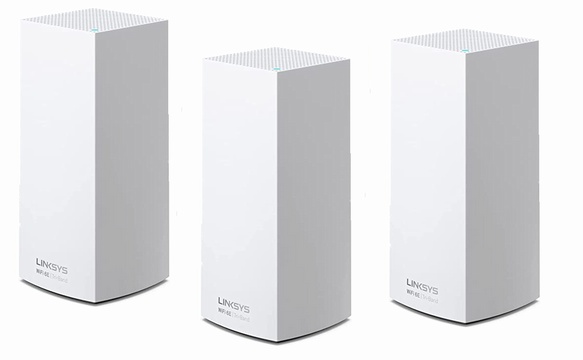
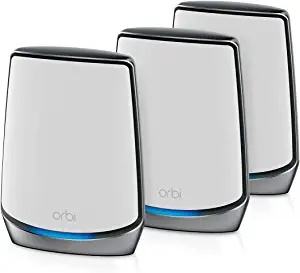
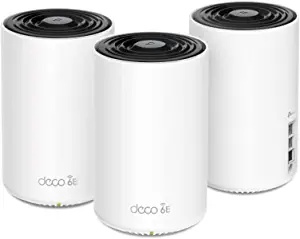
 Advertised router speeds are pure fiction: Consider this claim from a manufacturer:
Advertised router speeds are pure fiction: Consider this claim from a manufacturer: 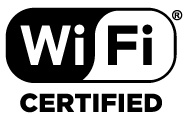 Be critical (and smart): There is no point in replacing your router if PHY speeds to/from your wireless devices do NOT improve (by at least some reasonable amount). So, be very critical. Take note of
Be critical (and smart): There is no point in replacing your router if PHY speeds to/from your wireless devices do NOT improve (by at least some reasonable amount). So, be very critical. Take note of 
